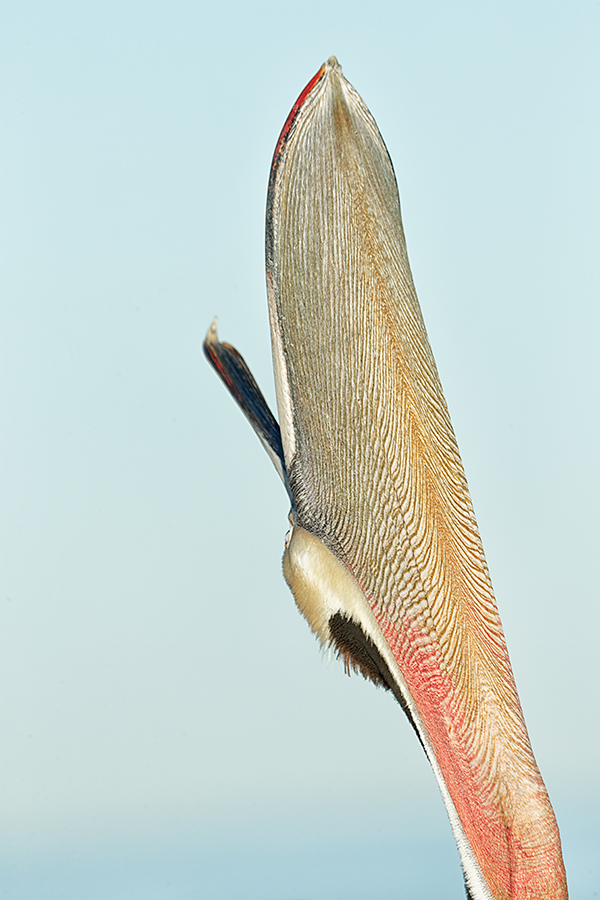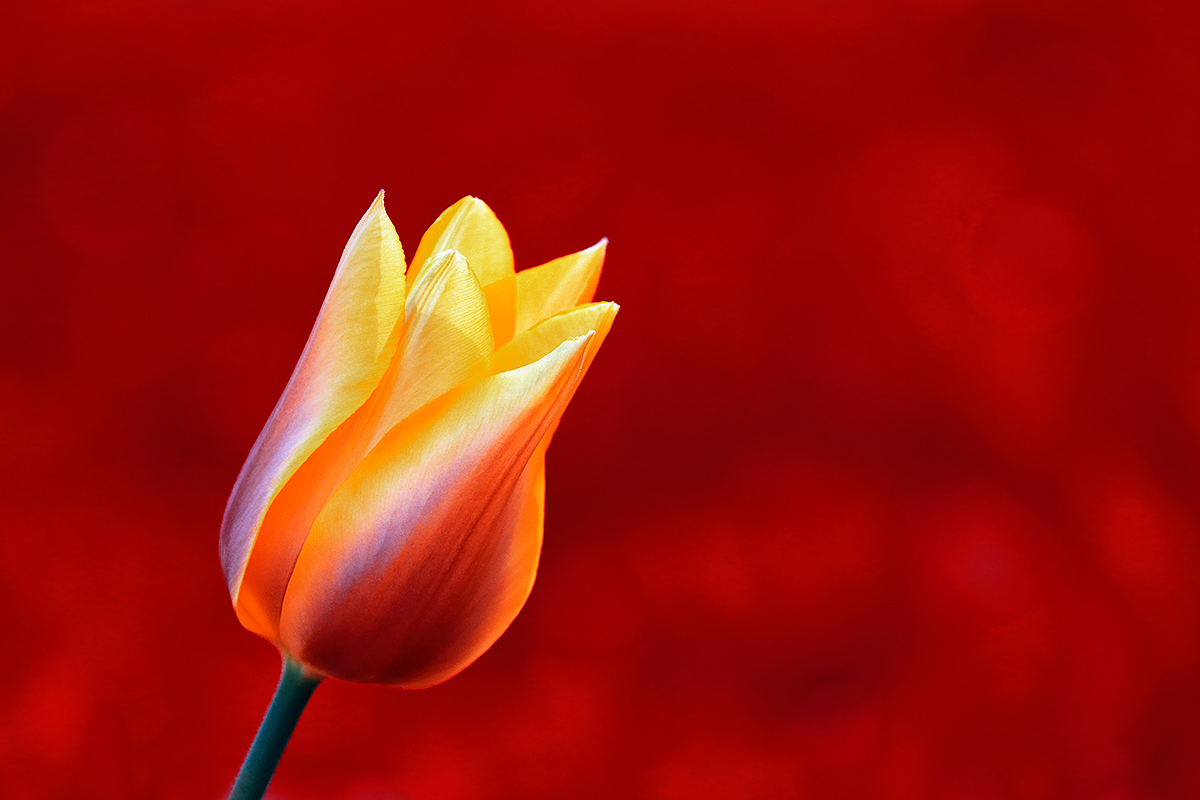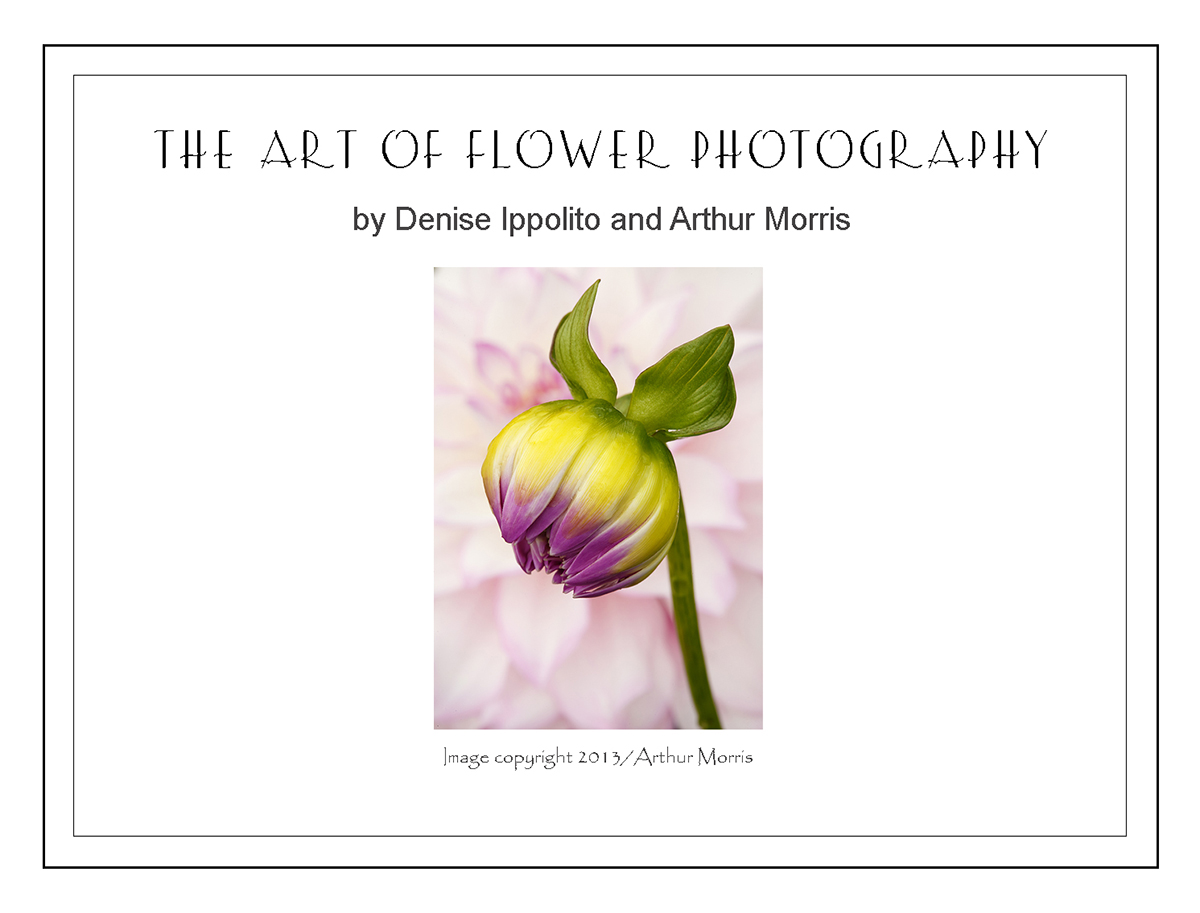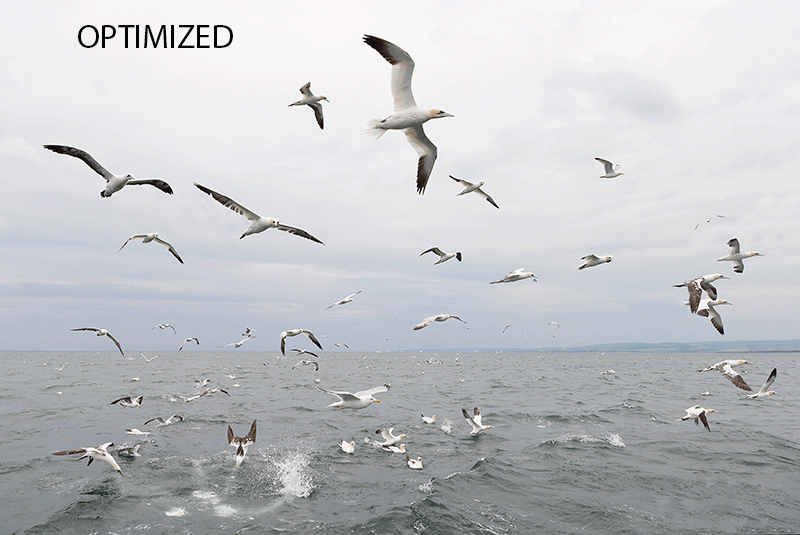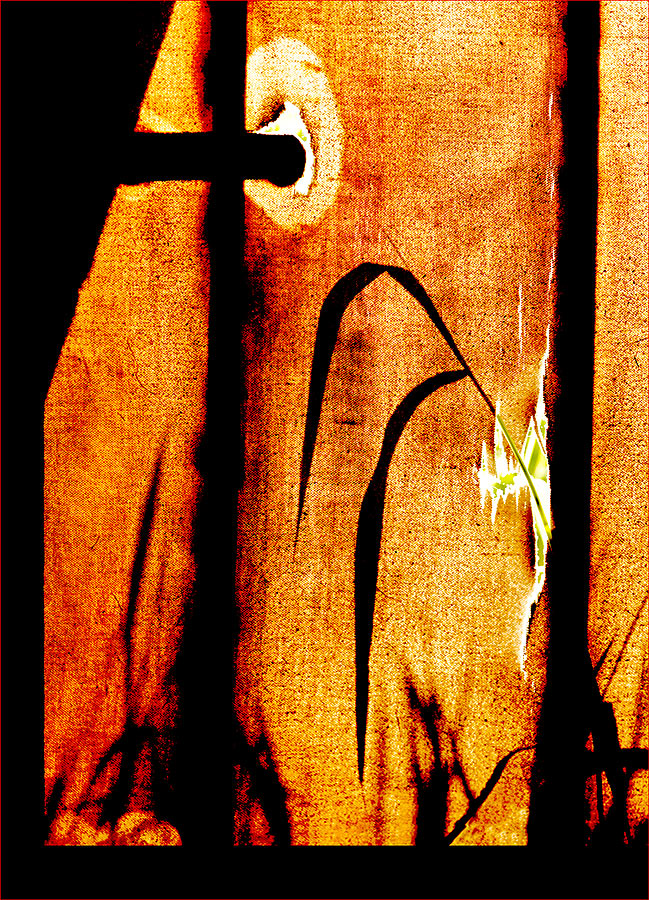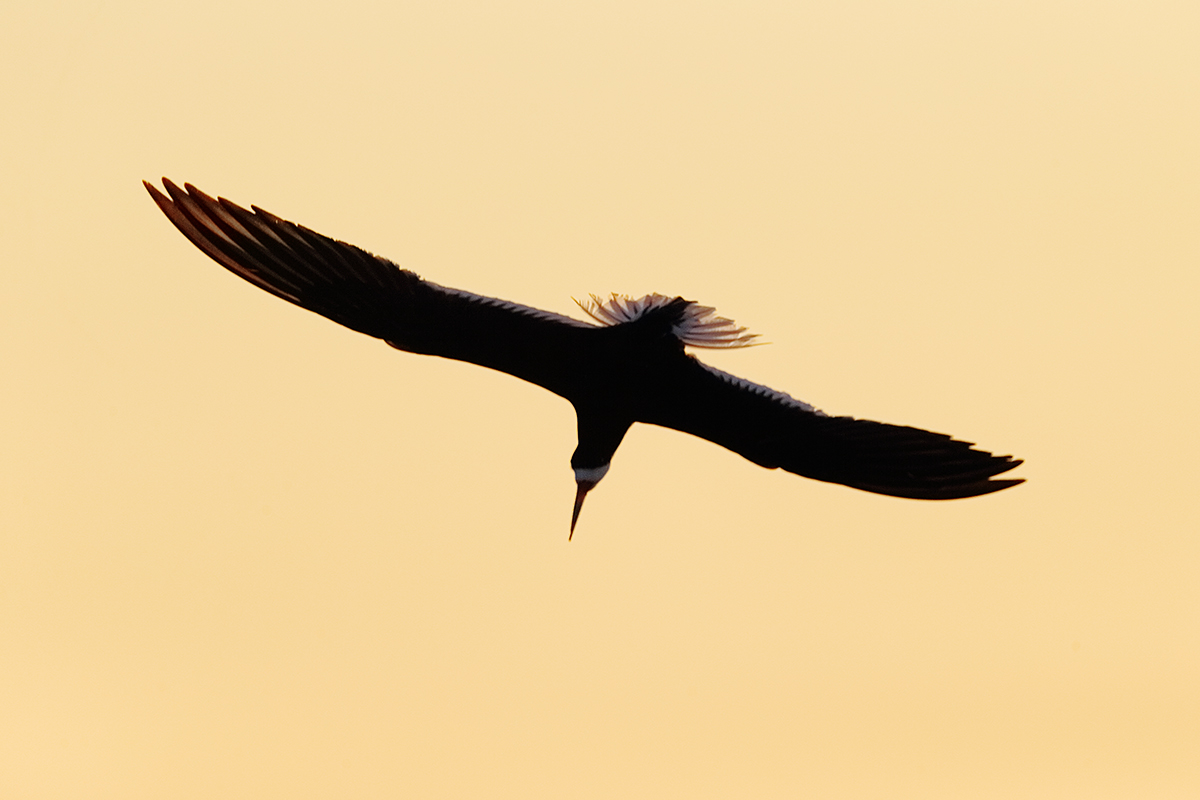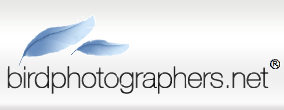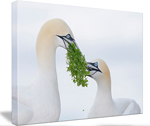September 21st, 2014 The Streak Continues: 295
After our one hour phone conference with Arash Hazeghi yesterday, I cleaned up a bunch of stuff that I had not quite understood; the way it works is that I ask the questions and Arash “‘splains” things. This morning I will spend another hour or two on stylistic issues and consistency and then send the MS Word file to Arash via Hightail. Otherwise most of yesterday was spent relaxing. And I enjoyed another nice 8 hours of sleep. This blog post, the 295th in a row, took me about 3 1/2 hours to prepare. It was published just before 7:45am from my home in Indian Lake Estates, FL.
As always, I would appreciate your using the BIRDS AS ART B&H affiliate links for all of your major gear, video, and electronic purchases, using our Amazon logo-link for all of your household purchases, and visiting the BAA Online Store for your tripod, tripod head, LensCoat, miscellaneous, accessories, and eGuide purchases as well. Please remember, web orders only. 🙂 Please remember also that all are invited to e-mail for gear advice.
Important Bosque Festival of the Cranes Event Registration Notice
Registration for all Festival of the Cranes workshops, seminars and programs is open. Please click here and read carefully to avoid missing out on several wonderful and inexpensive educational opportunities. Please do not tarry as we expect all of the BAA/A Creative Adventure sessions to sell out quickly, especially the early morning In-the-Field Workshops. You can click here to register.
There is still lots of room in the seminar and the free program. The Thursday In-the-Field Workshop (ITF-W) is sold out. Friday and Sunday are filling nicely. For some strange reason Saturday has only 4 folks signed up…. Both the seminar (below) and the ITF-Workshops represent a chance to learn a ton cheap.
Bosque del Apache Photography Two-Part Seminar
Bosque del Apache Photography Two-Part Seminar. Thursday, NOV 20, 2014. 2:00-4:30 pm at the refuge visitor center with Arthur Morris and Denise Ippolito: $50.00. Click here to register.
Part I: Bosque del Apache Photography Basics
Artie and Denise will cover the basics of lens selection, tripod and head selection, image design, getting the right exposure, autofocus options, and the relationship between light direction and wind direction, and will give an overview of the best photographic opportunities at the refuge. Artie and Denise have more than 26 years of experience photographing Bosque and count it high on their list of soul places.
Part II: Creative Photography at Bosque del Apache
Artie and Denise will teach you to think outside the box when photographing at the refuge (and elsewhere!). You will learn to create a variety of pleasingly blurred images by using slow shutter speeds, by photographing moving subjects, and by zooming or by panning with the lens during the exposure. They will teach you to take advantage of spectacular lighting and weather conditions. They will also cover post processing creative techniques.
|
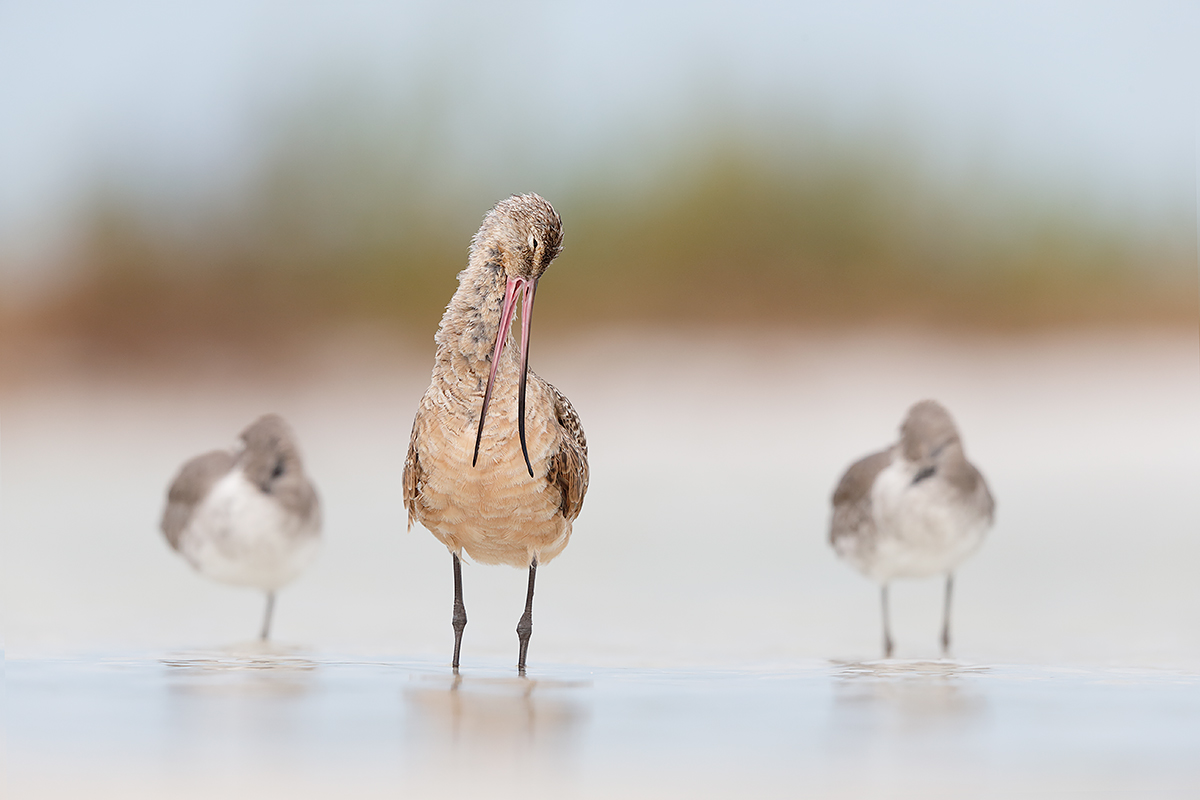
|
|
This image was created on the morning of September 16, 2012 at Fort DeSoto Park, Tierra Verde, FL, southwest of St. Petersburg, FL. I used the hand held Canon 500mm f/4L EF IS II lens, the Canon 1.4x EF tele-extender III, and the Canon EOS-1D X. ISO 800. Evaluative metering +2 2/3 stops off the light grey sky: 1/1600 sec. at f/6.3 in Manual mode.
Central Sensor Surround/AI Servo Rear Focus AF on the godwit’s face and recompose. Click here to see the latest version of the Rear Focus Tutorial. Be sure to click on the image for a larger version.
|
Difficult Questions Answered
In the “Difficult Questions” blog post of September 17, 2014 (you can see it here), I did ask some difficult questions as below. My answers with comments follow each question.
#1: Should I have tried to get higher by sitting up? By standing up? Why or why not?
Most folks who left comments liked the image and the background as presented. I did too. But I clearly remember trying to get up just high enough on my elbows to move the distant background to just above the top of the bird’s head with a nice border. Those efforts were not very successful. I did sit up but then I lost the background altogether while retaining some of the intimacy. Standing would totally eliminate all intimacy.
Many of the boys and girls were totally confused as to how getting higher would influence the placement of the background. See item next below, “The Effect of Getting Higher…”
#2: What do you think of the placement of the three birds in the frame? Would you have done anything differently as far as the image design is concerned?
Most folks like the image design and the placement of the birds in the frame and I agree 100%. With two birds on the left side of the frame and the godwit looking to our right the image is perfectly balanced with the gowdit placed just left of center. If you connect the the heads of the three birds there is a nice triangle going on. David Pugsley added: 2. I like the positioning of the birds. Had the godwit been centered between the two Willets the image would have bit’d been a bit too symmetrical.
#3: Why is it OK to use rear focus and recompose (which is effectively one-shot AF) when you are lying down but not OK to use rear focus and recompose (effectively one-shot AF) when you are sitting or standing? (In those cases you are much better off using AI Servo AF and keeping it active at the moment of exposure.) Why? What difference does it make if you are lying down as opposed to sitting or standing?
I have reviewed this principle so often that many folks nailed the answer. Richard Lethbridge wrote: You are much steadier lying down with both elbows firmly supported. Thus, there is no risk of throwing off the focus. David Policansky finished off the perfect answer when he wrote, Sitting or standing, you’re more likely to move a bit back and forth and so you want AI Servo AF to make sure the subject stays in focus.
|
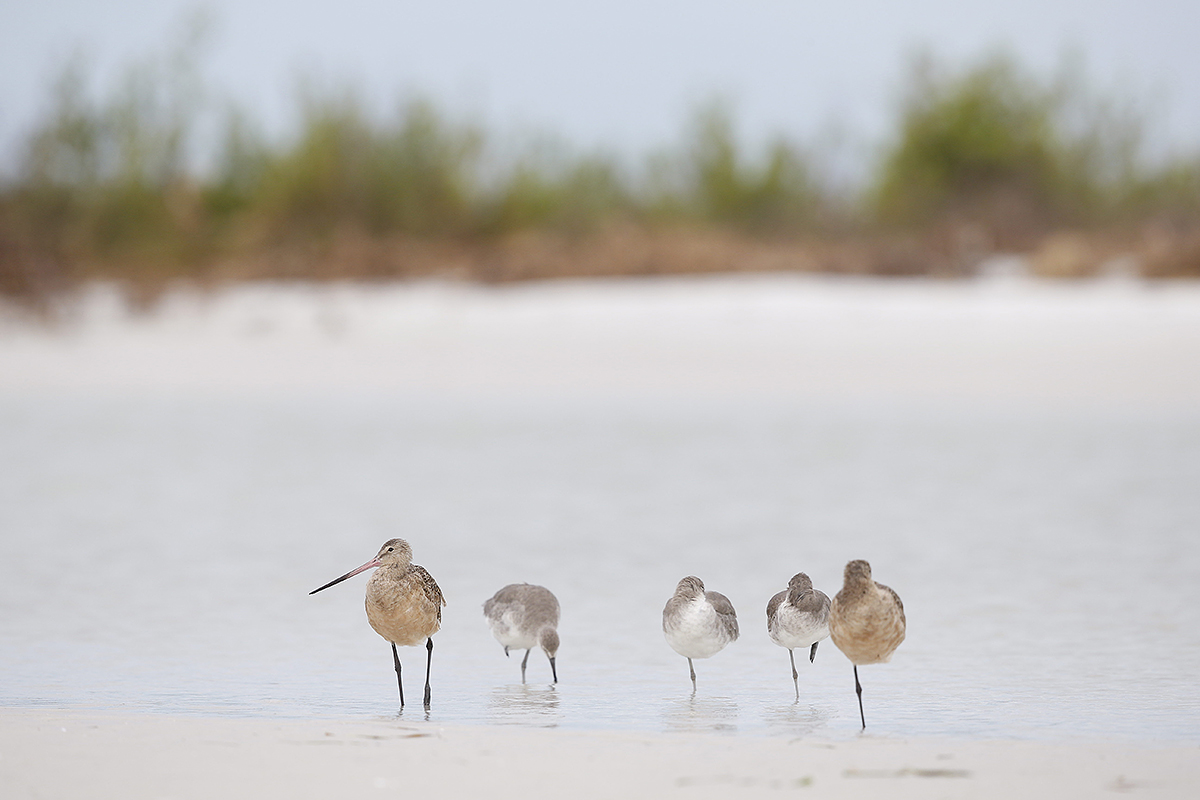
|
|
This image was also created on the morning of September 16, 2012 at Fort DeSoto Park, Tierra Verde, FL, southwest of St. Petersburg, FL. For this one I kneeled behind the Gitzo 3532 LS carbon fiber tripod, the Mongoose M3.6 head, the Canon 500mm f/4L EF IS II lens and the Canon EOS-1D X. ISO 800. Evaluative metering +2 2/3 stops off the light grey sky: 1/1250 sec. at f/6.3 in Manual mode.
Central Sensor Surround/AI Servo Rear Focus AF on the left hand godwit’s face and recompose. Click here to see the latest version of the Rear Focus Tutorial. Be sure to click on the image for a larger version.
This JPEG was created from the extracted JPEG. It represents the original RAW capture as it came out of camera. The optimized image below was created from the RAW file that was converted in DPP 4.0.
|
The Effect of Getting Higher…
This image was created 12 minutes before the opening image, “on the way in,” that is, as I approached the birds. I had the lens on the tripod but standing at full height I had only a water background. To bring the vegetation on the shoreline into the frame I needed to get lower. So that is what I did; in effect I brought the birds and the shoreline closer to the same plane.
Note with the opening image that getting higher would effectively move the shoreline above the birds. For experienced photographers this concept is a no-brainer but many beginners have a problem understanding how the relationship of the subject with various other elements in an image will change as they get higher or lower or move left or right (or any combination of the two). The very best way to learn these concepts is to actually move yourself up or down or left or right. You do not even need a lens in your hand to see how the juxtapositions change as you shift your position.
If you are struggling in any way with designing pleasing images you are directed to the “Designing the Image” chapter (pages 103-113) in the original The Art of Bird Photography (now available in soft cover). The sections on Backgrounds (pages 108-9) and Perspective (110-110) will be especially helpful. In addition, the chapter on Advanced Image Design in The Art of Bird Photography II, the follow-up to the classic original, would also be most helpful–APB II: 916 pages, 900+ images on CD only.
What Bugged Me?
What bugged me about this image? The merge of the godwit on our right with the Willet next to it….
|
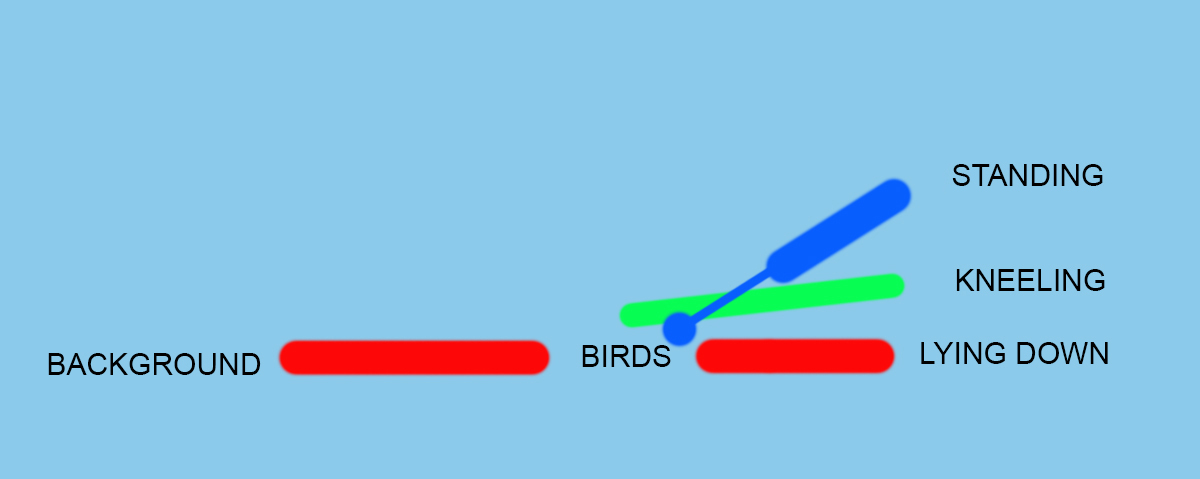
|
The Perspective Diagram
|
The Perspective Diagram
This is a schematic diagram of the situation that I encountered that morning. It is a common situation. If you study it carefully it will help you to better understand the perspective and juxtaposition issues that nature photographers must consider each and every time that they look through the viewfinder.
Consider the orange perspective line. When you are lying down, the birds and the relatively distant background will be on relatively the same plane. Imagine that if you got just a few inches higher, the background would move up just a bit relative to the birds….
Now consider the lime perspective line. You are kneeling. If you imagine extending this line it is easy to see that if you place the birds in the bottom of the frame the background will be well above the birds somewhere in the top of the frame.
Now consider the blue perspective line. When you are standing, you will be looking down on the birds; you will have only water in your background.
|
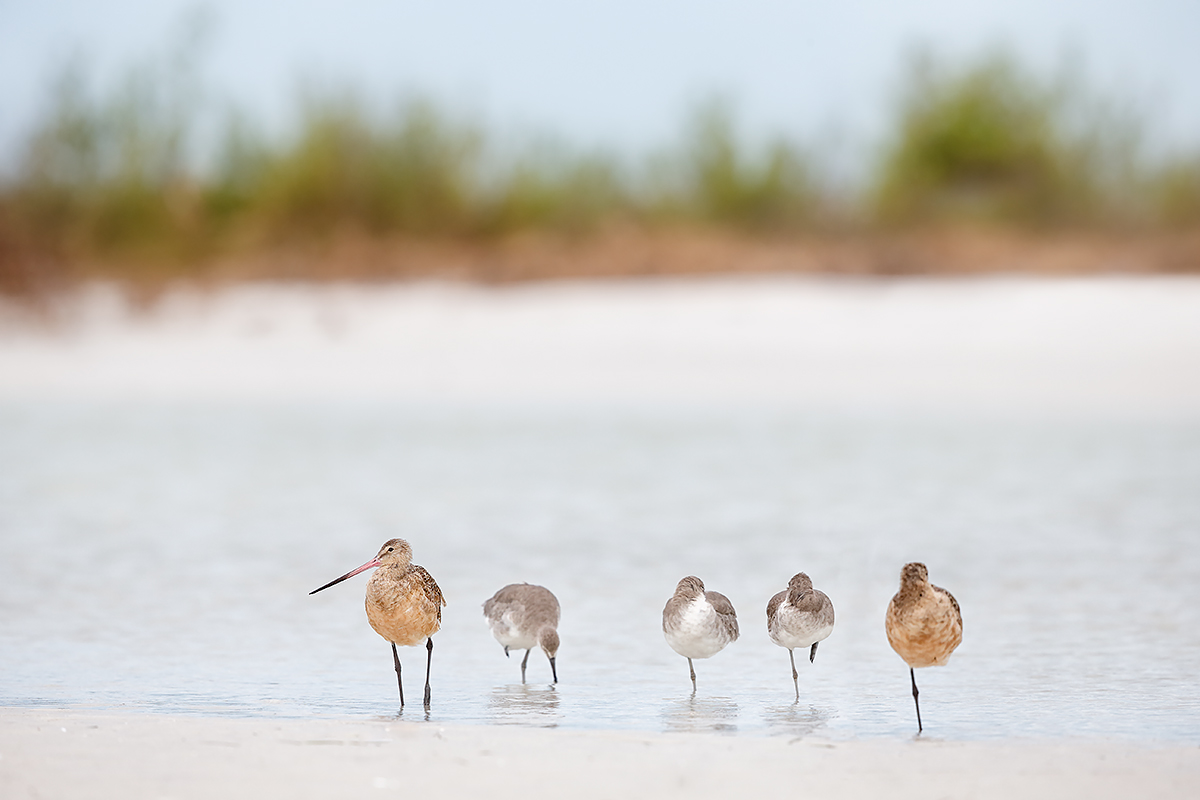
|
|
This is the optimized image that was created from the image above.
|
The Image Optimization
First the image was converted in DPP 4.0 and then brought into Photoshop CS-6. Aside from the usual, I used two fairly large Quick Masks, one to move the godwit to our right and then a second one of water only to cover the original godwit. I made the second QM first, labeled that layer, moved it out of the way, went back to the Background copy, created the QM of the bird, moved that to the right, went back to the first Quick Mask, moved it into position, and then refined it as noted next. Both of the QMs were refined via the addition of a Regular Layer Mask. The QM that covered the original godwit needed to be warped. Next I needed to rebuild the missing edge of the Willet, the edge that had originally been hidden behind the godwit. For that I used several small QMs, some from the bird itself, one or two from the bird to its right.
Other Changes?
Please leave a comment and let us know what other changes you see when comparing the optimized image to the original.
Advanced Image Design Question
With the Marbled Godwit on our left looking to our left why didn’t I point the camera more to the left to move the whole group of birds back (to our right) in the frame?
The DPP RAW Conversion Guide
To learn why I use Canon’s Digital Photo Professional (DPP) to convert every image that I work on, click here. Coming very soon: The DPP 4.0 RAW Conversion Guide by Arash Hazeghi and Arthur Morris. I finished my first edit of Arash’s manuscript yesterday. The more that I use DPP 4.0 for my RAW conversions the more I learn about it and the more I learn about it the more I am impressed with it. Note: at present, DPP 4.0 will work only with 1D X and 5D III images.
Digital Basics
Everything that I did to optimize today’s image is covered in detail in my Digital Basics File–written in my easy-to-follow, easy-to-understand style. Are you tired of making your images look worse in Photoshop? Digital Basics File is an instructional PDF that is sent via e-mail. It includes my complete digital workflow, dozens of great Photoshop tips, details on using all of my killer image clean-up tools, the use of Contrast Masks, several different ways of expanding and filling in canvas, all of my time-saving Keyboard Shortcuts, Quick Masking, Layer Masking, and NIK Color Efex Pro basics, Digital Eye Doctor, Tim Grey Dodge and Burn, how to create time-saving actions, and tons more.
APTATS I & II
Learn the details of advanced Quick Masking techniques in APTATS I. Learn Advanced Layer Masking Techniques in APTATS I. Mention this blog post and apply a $5 discount to either with phone orders only. Buy both APTATS I and APTATS II and we will be glad to apply at $15 discount with phone orders only. Please call Jim or Jennifer at 863-692-0906 weekdays to order.
|
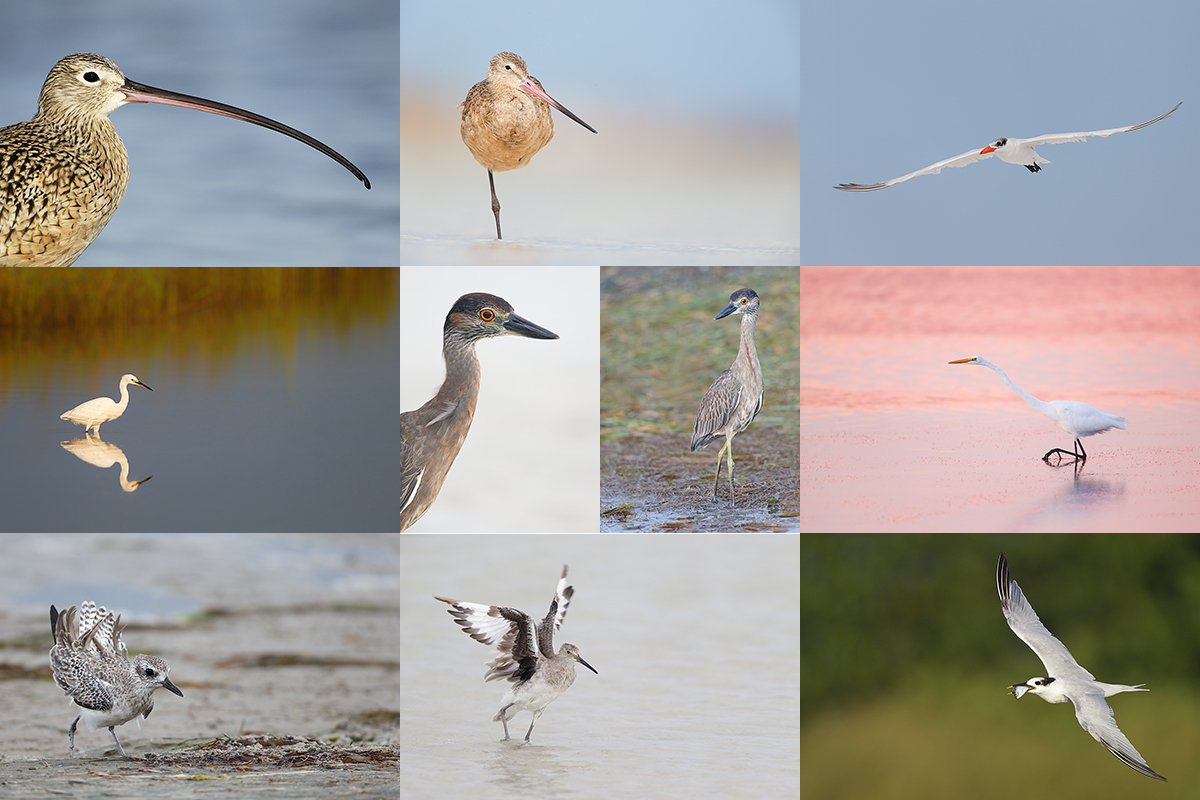
|
|
Fort DeSoto in fall is rich with tame birds. All of the images in this card were created at Fort DeSoto in either late September or early October. I hope that you can join me there this October. Click on the composite to enjoy a larger version.
|
First-ever BIRDS AS ART In-the-Field/Meetup Workshop Session (ITF/MWS): $50
Join me on the afternoon of October 10, 2014 for 3-hours of photographic instruction at Fort DeSoto Park. Beginners are welcome. Lenses of 300mm or longer are recommended but even those with 70-200s should get to make some nice images. Teleconverters are always a plus.
You will learn the basics of digital exposure and image design, autofocus basics, and how to get close to free and wild birds. We should get to photograph a variety of wading birds, shorebirds, terns, and gulls. This inexpensive afternoon workshop is designed to give folks a taste of the level and the quality of instruction that is provided on BIRDS AS ART Instructional Photo-tours. I hope to meet you there.
To register please call Jim or Jennifer during weekday business hours with a credit card in hand to pay the nominal registration fee. Your registration fee is non-refundable. You will receive a short e-mail with instructions, gear advice, and meeting place at least two weeks before the event.
|
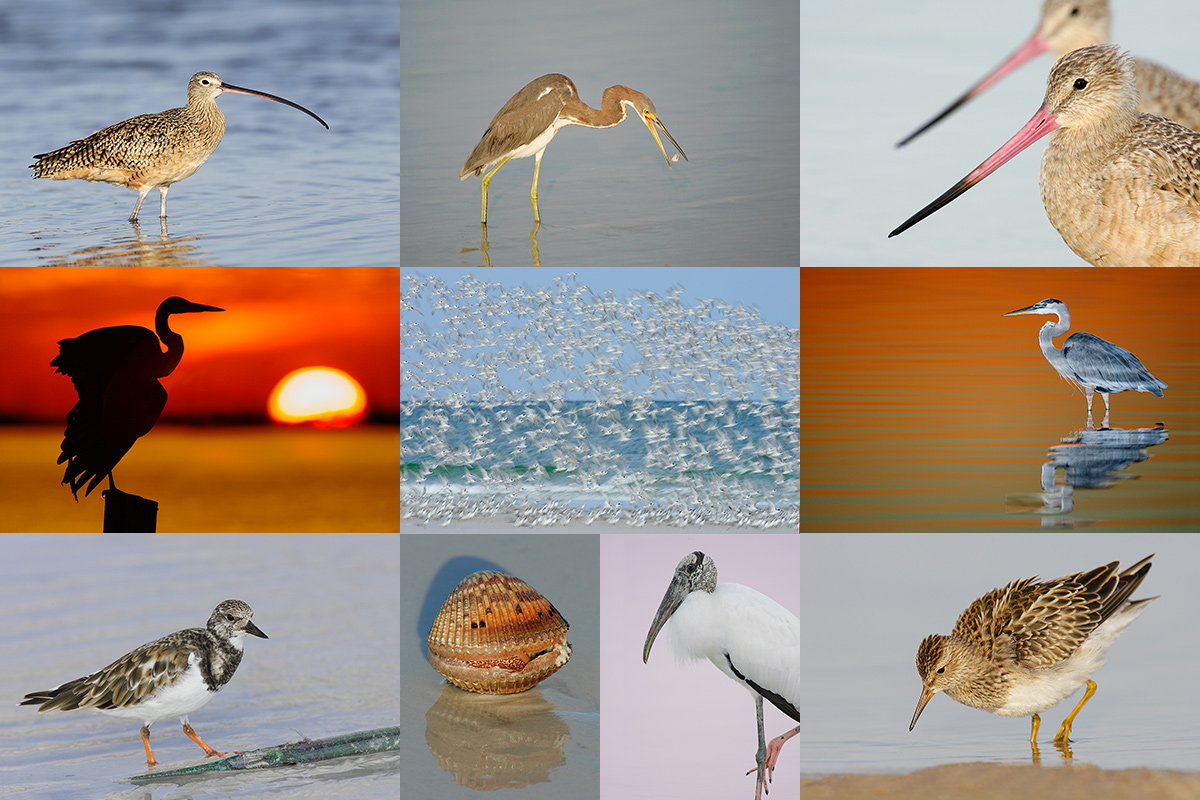
|
|
Obviously folks attending the IPT will be out in the field early and stay late to take advantage of sunrise and sunset colors. The good news is that the days are relatively short in October. Click on the composite to enjoy a larger version.
|
Fort DeSoto Fall IPT/October 11-13, 2014. 3 FULL DAYs: $1099. Limit 8/Openings 5.
Fort DeSoto, located just south of St. Petersburg, FL, is a mecca for migrant shorebirds in fall. There they join hundreds of egrets, herons, night-herons, gulls, and terns who winter on the T-shaped peninsula that serves as their wintering grounds. With any luck, we should get to photograph two of Florida’s most desirable shorebird species: Marbled Godwit and the spectacular Long-billed Curlew. Black-bellied Plover and Willet are easy, American Oystercatcher likely. Great Egret, Snowy Egret, Great Blue Heron, and Tricolored Heron are easy as well and we will almost surely come up with a tame Yellow-crowned Night-Heron or two. We should get to do some Brown Pelican flight photography. And Royal, Sandwich, Forster’s, and Caspian Terns will likely provide us with some good flight opportunities as well. Though not guaranteed Roseate Spoonbill and Wood Stork would not be unexpected.
Folks who sign up for the IPT are welcome to join us on the ITF/MWS on Friday afternoon as my guest. See above for details on that.
On the IPT you will learn basics and fine points of digital exposure and to get the right exposure every time after making a single test exposure, how to approach free and wild birds without disturbing them, to understand and predict bird behavior, to identify many species of shorebirds, to spot the good situations, to choose the best perspective, to see and understand the light, to, and to design pleasing images by mastering your camera’s AF system. And you will learn learn how and why to work in Manual mode (even if you’re scared of it).
At lunch (included) we will review my images–folks learn a ton watching me edit–why keep this one and delete that one. If you opt to bring your laptop, we will take a look at five of your best images from the morning session. We will process a few of my images in Photoshop after converting them in DPP. That followed by Instructor Nap Time.
If you decide to register and are traveling to attend this IPT, please make your reservations at the Beachcomber Beach Resort, 6200 Gulf Blvd, St. Petersburg (St. Pete Beach), FL 33706 (727-367-1902) as soon as possible as rooms for the weekend days are scarce: ARR: 10 OCT/DEP 14 OCT. I stayed there on my last DeSoto visit and was quite happy with it. Lodging is tough in Florida at this season…. The best airport is Tampa (TPA). It is always best if IPT folks stay in the same hotel so if you are interested it would be a good idea to register now and make your hotel reservations as well. We can, however, coordinate easily with local folks who opt to stay at home either by cell phone or e-mail.
Because of the relatively late date, payment is full is due upon registration either by check or credit card. If the former, please e-mail us immediately so that we can save you a spot. If the latter, please call Jim or Jennifer during weekday business hours at 863-692-0906 with a credit card in hand to register . Your registration fee is non-refundable unless the IPT sells out with eight so please check your plans carefully before committing. You will receive a confirmation e-mail with detailed instructions, gear advice, and first morning meeting place about one month before this IPT.
|
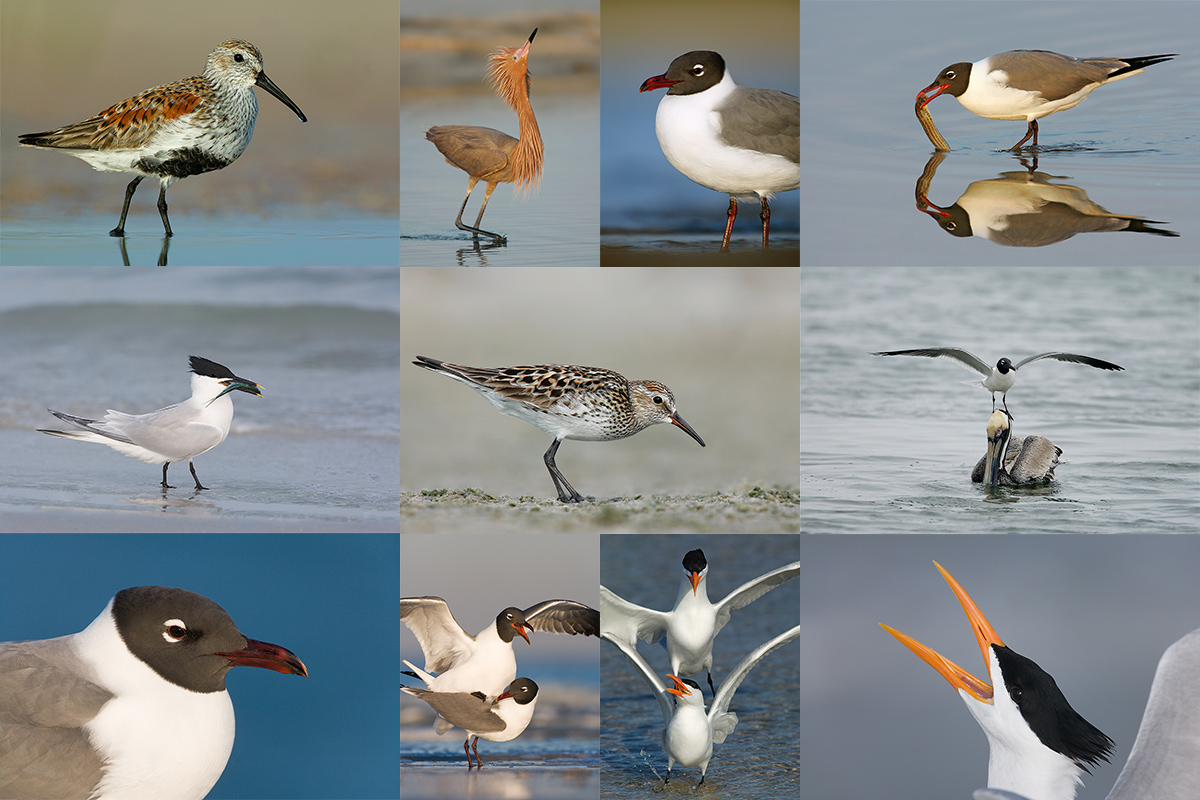
|
|
BAA Site Guides are the next best thing to being on an IPT.
|
Fort DeSoto Site Guide
Can’t make the IPT? Get yourself a copy of the Fort DeSoto Site Guide. Learn the best spots, where to be when in what season in what weather. Learn the best wind directions for the various locations. BAA Site Guides are the next best thing to being on an IPT. You can see all of them here.
Facebook
Be sure to like and follow BAA on Facebook by clicking on the logo link upper right. Tanks a stack!
Support the BAA Blog. Support the BAA Bulletins: Shop B&H here!
We want and need to keep providing you with the latest free information, photography and Photoshop lessons, and all manner of related information. Show your appreciation by making your purchases immediately after clicking on any of our B&H or Amazon Affiliate links in this blog post. Remember, B&H ain’t just photography!
…..
Amazon.com
Those who prefer to support BAA by shopping with Amazon may use this link:
Amazon Canada
Many kind folks from north of the border, ay, have e-mailed stating that they would love to help us out by using one of our affiliate links but that living in Canada and doing so presents numerous problems. Now, they can help us out by using our Amazon Canada affiliate link by starting their searches by clicking here. Many thanks to those who have written.
Typos
In all blog posts and Bulletins, feel free to e-mail or to leave a comment regarding any typos, wrong words, misspellings, omissions, or grammatical errors. Just be right. 🙂
September 20th, 2014 The Streak Continues: 294
I finally finished editing/re-writing Arash Hazeghi’s first draft the new DPP 4.0 RAW Conversion e-Guide that we are doing together. We have another phone conference scheduled for this morning. This blog post, the 294th in a row, was published just before 7:30am from my home in Indian Lake Estates, FL.
As always, I would appreciate your using the BIRDS AS ART B&H affiliate links for all of your major gear, video, and electronic purchases, using our Amazon logo-link for all of your household purchases, and visiting the BAA Online Store for your tripod, tripod head, LensCoat, miscellaneous, accessories, and eGuide purchases as well. Please remember, web orders only. 🙂 Please remember also that all are invited to e-mail for gear advice.
EOS-7D Mark II Thanks!
Thanks a stack to the 22 folks who pre-ordered their EOS 7D Mark II bodies (and lots of accessories) using a BAA affiliate link.
If you are ready to order, please click on the logo-link immediately below to pre-order. This will be one hot-ticket item; the sooner you get your name on the pre-order list, the sooner you will have a 7D II in your hands.
Not convinced? Click here and be sure to check out yesterday’s blog post as well.
Breathing Your Way to Better Health
As my 60-year old younger sister Arna had two TIAs (mini strokes) fairly recently, my health guru, Dr. Cliff Oliver of The Center for Balance in San Diego, CA, suggested that I have a carotid artery ultrasound done. Nearly 20 years ago, Cliff saved me from killing myself with food, mainly more than half a million Oreo cookies dunked two at a time in cold milk. Today when Cliff says “Jump” I do not ask “Why?,” I ask “How high?”
I first met Cliff Oliver on a Bosque IPT nearly two decades ago. Thank God for that. For the complete story of how I went from a 240 pound 50 year old with uncontrolled diabetes, an ulcer, atrial fibrillation, high blood pressure, coronary artery disease (on every heart medication known to mankind) to a relatively healthy 184 pound 68 year old on zero heart meds with an A1C that hovers around 5.0, shoot me an e-mail with the words “Health Basics File” cut and pasted into the Subject line.
When I arrived at the church in Plant City, FL for the ultrasound test, the nice lady at reception talked me into a battery or four tests rather than just the carotid artery scan. I should be getting the results by mail in another week or so. In the meantime they took my blood pressure. It was high, something like 170 over 98. For the past ten years my blood pressure in the doctor’s office has routinely averaged about 135 over 75 so I was of course a bit concerned.
On the way back to ILE, I stopped in Lake Wales and purchased an Omron Blood Pressure Monitor, model BP 742N. I had had one years ago but after using it for ages it bit the dust.
I figured that I had been a bit nervous about the ultrasound test, that my pressure had been high because of cuff psychosis, and that when I took my BP at home it would be back to normal. That did not happen. My blood pressure that first day ranged from about 170-180 over 95-98. In a word, high.
After some thought I realized that though I have always salted my food, I had really been overdoing it lately. Secondly, I realized that about four months ago, when my blood pressure had been normal, that I had quit taking OXY A+ drops as I was thinking that they were negatively affecting my stomach in a rather unpleasant way.
So I called Cliff. He suggested that by getting some empty gel caps and putting the drops in those that my stomach would not be affected. And of course he agreed on eliminating salt.
Most importantly he said that I should resume doing the 4-7-8 breathing that had once been a part of my daily regimen. It is recommended that you do the 4-7-8 breathing twice a day, once in the early morning and once when you get into bed at night. As my Mom said when I was a kid, “This child does not know the meaning of the word moderation.” Little has changed. I’ve been doing the 4-7-8 breathing ten or fifteen times each day. My blood pressure readings began dropping immediately. After just four days my blood pressure is nearly back to normal: the last reading was 140 over 82. Amazing.
BTW, yesterday was my Mom’s 92nd birthday. Happy Bird-day Mom.
With all due respect to the many Western Medicine folks out their, there is a lot to be said for alternative medicine.
While Doctor Oliver recommended the 4-7-8 breathing to lower my blood pressure–he swears that it works every time, here is what Dr. Andrew Weil has to say about it:
Once you develop this breathing technique by practicing it every day, twice a day, it will be a very useful tool that you will always have with you. Use it whenever anything upsetting happens – before you react. Use it whenever you are aware of internal tension. Use it to help you fall asleep. Use it to deal with food cravings. Great for mild to moderate anxiety, this exercise cannot be recommended too highly. Everyone can benefit from it. The relationship between feeling at peace and lowered blood pressure seems pretty direct.
I should have mentioned that one round of 4-7-8 breathing takes less than two minutes. And you can learn to do it in just a few minutes at most. To learn how, and for a better explanation of the many benefits, click here and then click on the big white triangle.
The guy on the stool is Dr. Andrew Weil. Twice on the cover of TIME magazine and author of 10 books, Dr. Weil.M.D., is a world-renowned leader and pioneer in the field of integrative medicine, a healing oriented approach to health care which encompasses body, mind, and spirit. Though many in traditional Western medicine would point to him as a quack, he is an American medical doctor, naturopath, and a teacher and writer on holistic health. He is founder, professor, and director of the Arizona Center for Integrative Medicine at the University of Arizona. He received his medical degree, and an undergraduate degree in biology, from Harvard University. Weil is widely known for establishing the field of integrative medicine which aims to combine alternative and conventional medicine. Weil suggests that patients take the Western medicine prescribed to them by doctors and then incorporate a variety of alternative therapies including and especially nutritional therapies. .
To be sure, a quick internet search will reveal hosts of harsh criticism of Dr. Weil. I am not at all qualified to judge either him or the articles that trash him, but I can say that 4-7-8 breathing can help you reduce stress and help you lower your blood pressure.
Shedding Some Light on 7D II Battery Misconceptions
After reading that the 7D II battery life would be approximately 800 images at 73°F while the 7D battery life would be approximately 1000 images at 73°F, I assumed that the 7D II’s new battery was not as powerful as the old battery in the 7D. So I wrote Rudy Winston as follows:
Hey Again Rudy, Do you have any clues as to why the new 7D II battery is less powerful than the older battery in the 7D? thanks, artie
Rudy kindly replied via e-mail:
Hi Artie,
Actually, the new and very slightly modified LP-E6N battery that launches with the EOS 7D Mark II is marginally more powerful than the LP-E6 battery that we’ve known up to now. It’s rated at 3.5% higher mAh rating — 1865 mAh vs. 1800 for the current LP-E6. The charger (the LC-E6), is the same for both batteries; use it with either the new or the current battery.
LP-E6N and LP-E6 are absolutely, unconditionally backward- and forward-compatible… users who have a number of the older batteries can use them freely in the new EOS 7D Mark II, and likewise the new LP-E6N can be freely used in an EOS 5D Mark II/Mark III, 70D, the original 7D, or any other LP-E6-compatible EOS body. There has, however, been a lot of unfounded speculation and misinformation on-line about this with people freaking-out that they’ll have to get all-new batteries, etc. That is just not the case.
Here are the battery life ratings, according to Canon Inc. —
Original EOS 7D — 800 shots (with 50% using built-in flash; at 73 degrees F)
New EOS 7D Mark II — 670 shots (same conditions)
Though there is no official word or explanation, it is clear that the higher resolution, higher-capacity processors and system overhead contribute to fewer potential shots on a single battery charge. FYI, the built-in flash has the same maximum power as the previous unit, although they’ve changed the official method of calculating Guide Number, so the GN appears to be slightly lower on the 7D Mark II than on the original 7D.
So to summarize, it’s not a less powerful battery at all, even though the rated number of possible shots has decreased a bit vs. the original EOS 7D.
Hope that this is helpful to you and to those who follow your blog. Rudy Winston, Canon USA
IPT Updates
Several IPTs including the Fall Fort DeSoto and San Diego are filling nicely. We had a cancellation on the Bosque 4-DAY but that was filled immediately from the Waiting List. We may have another cancellation; if you are interested please shoot me an e-mail. There is room on the Bosque Creative IPT. Click here and scroll down for the IPT schedule and dates, rates, and info.
Coming soon:
The Hooptie Deux Breeding Plumage Roseate Spoonbill IPT. 4 1/2 DAYs/9 pontoon boat trips. SUN FEB 22 thru lunch on THUR FEB 26, 2015/Strict Limit: 6 photographers. Meet and greet on the evening of SAT 21 FEB. Two great leaders: Captain James Shadle (Nikon) and Canon Explorer of Light Emeritus Arthur Morris.
Please e-mail if you would like to receive early notice.
Festival of the Cranes in-the field instruction, programs, and events
For information on the great (cheap) in-the field instruction, programs, and events that I and Denise Ippolito are doing in conjunction with this year’s Festival of the Cranes, please click here.
Facebook
Be sure to like and follow BAA on Facebook by clicking on the logo link upper right. Tanks a stack!
Support the BAA Blog. Support the BAA Bulletins: Shop B&H here!
We want and need to keep providing you with the latest free information, photography and Photoshop lessons, and all manner of related information. Show your appreciation by making your purchases immediately after clicking on any of our B&H or Amazon Affiliate links in this blog post. Remember, B&H ain’t just photography!
…..
Amazon.com
Those who prefer to support BAA by shopping with Amazon may use this link:
Amazon Canada
Many kind folks from north of the border, ay, have e-mailed stating that they would love to help us out by using one of our affiliate links but that living in Canada and doing so presents numerous problems. Now, they can help us out by using our Amazon Canada affiliate link by starting their searches by clicking here. Many thanks to those who have written.
Typos
In all blog posts and Bulletins, feel free to e-mail or to leave a comment regarding any typos, wrong words, misspellings, omissions, or grammatical errors. Just be right. 🙂
September 19th, 2014 The Streak Continues: 293
I am having a great time being at home and taking good care of myself. Eating just two meals a day, breakfast and lunches of protein and vegetables only, I have lost more than five pounds slowly. My left knee and my right shoulder are both improving a lot. I spent yesterday meditating and doing breathing exercises and taking a nice easy 2/3 mile swim. I enjoyed a short nap, a 44 minute ice bath, and answered another zillion e-mails. All that followed by another good night’s sleep. This blog post, the 293rd in a row, was published just after 7:30am from my home in Indian Lake Estates, FL.
As always, I would appreciate your using the BIRDS AS ART B&H affiliate links for all of your major gear, video, and electronic purchases, using our Amazon logo-link for all of your household purchases, and visiting the BAA Online Store for your tripod, tripod head, LensCoat, miscellaneous, accessories, and eGuide purchases as well. Please remember, web orders only. 🙂
EOS-7D Mark II Thanks!
Thanks a stack to the 20 folks who pre-ordered their EOS 7D Mark II bodies (and lots of accessories) using a BAA affiliate link. If you missed all of yesterday’s excitement, click here. And best of luck to Geoffrey Cuff of the Cayman Islands with the Canon EF 400mm f/4 DO IS II USM Lens that he ordered in similar fashion.
Convinced? Click on the logo-link immediately below to pre-order yours. This will be one hot-ticket item; the sooner you get your name on the pre-order list, the sooner you will have a 7D II in your hands.
Not convinced? Click here and be sure to see tomorrow’s blog post.
Selling Your Used Photo Gear Through BIRDS AS ART
Selling your used (or like-new) photo gear through the BAA Blog or via a BAA Online Bulletin is a great idea. We charge only a 5% commission. One of the more popular used gear for sale sites charges a minimum of 20% plus assorted fees! Yikes. The minimum item price here is $500 (or less for a $25 fee). If you are interested please e-mail with the words Items for Sale Info Request cut and pasted into the Subject line :). Stuff that is priced fairly–I offer free pricing advice, usually sells in no time flat. In the past few months, we have sold just about everything in sight. Click here to see all the current listings.
Used Gear Cautions
Though I am not in a position to post images of gear for sale here or elsewhere, prospective buyers are encouraged to request for photos of the gear that they are interested in purchasing via e-mail. Doing so will help to avoid any misunderstandings as to the condition of the gear. Sellers are advised to take care to photograph their used gear with care against clean backgrounds so that the stuff is represented accurately and in the best light; please pardon the pun :).
New Listing: Canon 400mm EF f/5.6 L IS UMS Lens
Bob Bass is offering a used Canon 400mm EF f/5.6 L IS UMS in excellent condition for $999. The sale includes the original box, the tough fabric case, the front and rear lens caps, the instruction CD, and insured shipping via UPS Ground to US addresses only. Your new gear will be shipped only after your check clears unless other arrangements are made. You can contact Bob via e-mail or by phone at 781-275-5230 EST.
Original owner. The lens was purchased in 2012 and used infrequently. It was recently returned from Canon Professional Services where it received a clean and checked. Images of the lens are available upon request as are images made with the lens.
The 400 f/5.6, my old “toy lens” is an ideal flight or starter lens for younger folks with a steady hand. It will AF with a 1.4X TC with the new 7D II….
The Canon EOS-7D Mark II: Wading Through the Morass
If you type the words “Canon EOS-7D Mark II” into a Google search box it finds about 4,130,000 results in 1/3 of once second. And I have a very slow internet connection. I have spent the last three days reading each and every one of the more than four million articles and watching hundreds of 7D II videos. Actually not. But I have been doing lots of surfing, lots of reading, and watched more than a few videos from either trusted or interesting sources.
Below, each under a separate heading, I share just a fraction of what I have learned about this new camera.
Rudy Winston on the 7D II
Rudy Winston been with Canon USA’s Pro Products team for more than 17 years. He has been responsible for training Canon’s staff on new products, creating presentations for customers and dealers, numerous writing projects, and providing technical assistance to professional and amateur photographers including yours truly. Often. Currently, he’s a key figure in Canon’s Education department and contributes many on-line articles to Canon USA’s Digital Learning Center. Best of all he is a hell of a nice guy.
The 7D Mark II’s Intelligent Viewfinder
Rudy’s latest article is entitled “New Intelligent Viewfinder feature on EOS-7D Mark II.” You can read the whole thing here. I did, and here are my highlights.
Canon has packed a ton of potential info into the viewfinder via a clear, transmissive LCD overlay above the focusing screen. You can customize your 7D II so that it shows every feature–warning, it will be crowded in there. Or, you can customize it to show nothing. You choice. I was most excited to learn that you can turn on the new Viewfinder Electronic Level so that it is displayed in the camera’s viewfinder. It is in addition to and completely independent of the level display that can be programmed to appear on the large, rear LCD monitor. The one in the viewfinder is a dual-axis Electronic Level that shows any tilt (in 1-degree increments) from side-to-side, as well as up-and-down. It will be a dream feature for those like me who do lots of hand held scenic photography with wide angle or fish eye lenses.
You can opt to see a ton of shooting information across the bottom of the viewfinder if you choose. These are included, each with independent on/off control: Exposure Mode, White Balance, Drive, AF setting (One-Shot AF/AI Focus AF/AI Servo AF), Metering mode, Image quality (RAW or JPEG), and the Flicker! icon. And there are about a zillion options for displaying a great variety of AF info.
The Flicker icon? This is an amazing feature for those who photograph indoors or in other locations where unseen to the human eye, the lighting flicker or pulses thus causing mega-exposure problems for those who work in Manual exposure mode. Rudy explains the new Anti-Flicker technology in quite succinctly in a different article here.
Rudy sums up the 7D viewfinder article in part as follows:
There’s more extensive information in the EOS 7D Mark II viewfinder than any previous Canon EOS digital SLR but, again, the cool thing is you can display as much or as little as you like. With as sophisticated an AF system as this camera has, it understandably gives numerous options for how AF points (and even AF Operation Settings, One-Shot AF, AI Focus AF, and AI Servo AF) are displayed in the viewfinder. The viewfinder is the nerve center of any SLR camera and the EOS 7D Mark II provides options that make it almost like a heads-up display in a plane or automobile, figuratively speaking.
Tidbits and Gems from the Manufacturer’s Hype
In-camera lens aberration corrections
To help photographers with achieving high quality images, the EOS 7D Mark II corrects image distortions like peripheral illumination, chromatic aberration and distortion, in-camera, as the image is recorded. When shooting in Live View mode, the results of distortion can even be monitored in real time through the EOS 7D Mark II’s Image Simulation Function.
As far as I can figure, this feature will simplify the RAW conversions by eliminating a somewhat time-consuming step.
Speed and Accuracy with Intelligent Subject Recognition and Analysis.
The EOS-7D Mark II has an amazing iSA Intelligent Subject Analysis system that employs an independent RGB light sensor with approximately 150,000-pixel resolution. This sensor enables Canon’s intelligent Tracking and Recognition system (iTR AF) that detects and tracks subjects, automatically switching the AF point to optimize tracking. With new tracking algorithms tailored to recognize faces and colors, this system serves as a brilliant foundation to the EOS 7D Mark II’s AF system.
This sounds as if it might be great for photographing birds in flight or in action. The big questions are, truth or fiction? Fact or hype? The proof will eventually be in the pudding.
Specialty Controls, Built Right In
An EOS first, the EOS 7D Mark II offers time-lapse fixed-point shooting and long exposures without the need for a remote control. The EOS 7D Mark II’s interval timer takes from 1 to 99 shots at preselected intervals, ideal for shooting flowers as they bloom or clouds drifting through the sky. Its built-in bulb timer keeps the shutter open for a designated amount of time, perfect for night photography.
These two will be perfect for lazy folks like me….When the massive clouds are rolling by, it will be time lapse time. And there will be no more excuses for when it comes to trying my hand at night sky photography.
Full HD recording at 60p in MOV and MP4 Formats
Stunning full HD video with custom Movie Servo AF and multiple frame rates. While offering performance improvements across the board for still photography, the EOS 7D Mark II is also an incredibly capable HD movie camera. Taking advantage of its Dual Pixel CMOS AF capabilities, the EOS 7D Mark II has customizable Movie Servo AF options: not only can AF location be defined, AF speed and tracking intervals can be specified too, for fluid, smooth focus transitions. The EOS 7D Mark II delivers refined and detailed image quality with Full HD 60p recording at ISO values up to 16000, has an HDMI output and records to both SD and CF cards for versatility and security during important shoots.
Yours truly know zip about video so I will leave reviews of the 7D II’s video capabilities to others. You can see a 3 minute, 50 second sample video here. “Cello”is the second of the five videos. It was created at ISO 3200 in a great variety of lighting conditions using a great variety of Canon EF lenses.
Achieve Impressive AF During Video Capture
The EOS 7D Mark II features Canon’s revolutionary Dual Pixel CMOS AF, a milestone in AF speed and accuracy that unlocks the potential of Live View shooting. This advanced technology has truly changed what is possible with a DSLR camera. Dual Pixel CMOS AF involves a sophisticated rethinking of the CMOS sensor. Traditionally, image sensors have one photodiode per pixel for recording, but the CMOS sensor on the EOS 7D Mark II has two photodiodes per pixel, 40 million in total, enabling each pixel on the sensor to both perform phase-difference detection autofocus and capture light. With phase-difference detection AF, autofocus is achieved quickly and easily on the camera. This unique AF system enables autofocus on approximately 80% of the image plane, vertically and horizontally, and helps ensure virtually no loss in image quality.
The benefits of Dual Pixel CMOS AF are clearly evident in Live View and video shooting, where the EOS 7D Mark II achieves natural, precise focus very quickly, even when switching between subjects. And, combined with the predictive power of Movie Servo AF, subjects in motion are smoothly and consistently tracked – once focus is locked, the EOS 7D Mark II holds on! Plus, with the shallow depth-of-field afforded by EOS optics, video gains a brilliant, cinematic ambience lacking when shooting video with many other Digital SLRs.
Though I do not understand everything above, it seems pretty clear that the 7D II will offer AI servo AF with video…. That will surely tempt me. And it seems pretty clear as well that the new technology promises great improvement in the autofocus system when shooting stills of birds in flight or birds or animals in action. Again, we need to see how promised theoretical improvements pan out against reality.
More Great Stuff or Hollow Promises?
You can learn more about the features of the 7D IIby clicking here. In addition to those above these include the new 20.2 Megapixel CMOS (APS-C) sensor that promise gorgeous images, ten frames per second, a new mirror vibration control system, and brilliant, speedy AF tracking.
My Conclusions
I will sum things up here with two of my responses to questions left as comments on the blog.
The first was asked by Sandra Corless who wrote:
It would be very helpful Artie to know if the new features offered in the way of auto-focus require the use of the newer Canon telephoto lenses or if it will work just as well on some of the older lenses and converters.
Here is my response:
I am sure that the 7D II will focus better than the 7D on any lens. I am sure that the 7D II will AF just fine with the older EF lenses. And I am sure that it will AF faster and more accurately with the Series II super-telephotos than with the older lenses. Not because of anything to do with the camera, simply because the Series II lenses feature better AF than the older lenses.
To be sure that I was not stepping out of bounds with the statement above, I ran it by Chuck Westfall. He responded by e-mail: “Looks good to me.”
Next was a question asked by David Policansky who was kind enough to pre-order his 7D II and accessories using a BAA B&H affiliate link:
Do you plan to get a 7DII?
I answered:
Since I can say for sure that I am getting older every day I can say for sure that I would welcome a light weight 1.6X crop factor camera with very good to excellent image quality and very good high ISO performance. The crop factor would allow me to work with shorter, lighter lenses….
As I have been saying all along, the proof will be in the pudding. artie
Right now there are two chances that I might get my hands on a 7D II some time in mid- to late October or early November. If I do, and if I am permitted to share the images before the camera begins shipping, I will do so.
The two biggest promised and potential 7D II improvements for bird, wildlife, and nature photographers have to do with the all new AF system and with image quality. To get a handle on those, we need to have a 7D II in our hands in the field….
|
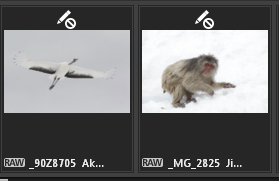
|
|
DPP 4.0 screen capture
|
DPP 4.0 Camera Compatibility Issues and Info
Thanks to Jim Simon who asked in a blog comment:
I have the Canon 1D Mk IV and the updater on the Canon site only shows the latest update as DPP 3.14.15. There is no explanation about why I should not update to DPP 4. Does anyone know whether the camera is just an orphan now or if there is a reason that DDP 4 should not be used for files from the Mk IV?
I wrote in response:
DPP 4.0 currently supports images from the following camera bodies: 1D X, 5D III, and 6D. Images from all other Canon digital cameras bodies including the EOS-1D Mark IV need to rely on DPP V 3 point whatever is the latest version.
It is not that DPP 4 shouldn’t be used for 1D IV images. It cannot be used to convert them. You need a serial # for a 1D X, 5D III, or a 6D to download DPP 4.0, but even if a friend gives you a valid serial number a 1D IV image will show in DPP 4.0 with a symbol that leaves no doubt that the image is incompatible: a pencil (indicating “edit”) and a circle with a diagonal line through it (indicating “sorry, Jack.”) I will try to remember to include a screen capture in tomorrow’s blog post. In addition I have the current news on DPP 4.0 and the 7D II.
Well, obviously I did remember :). In the screen capture above you can see the symbol that indicates that DPP 4.0 is not compatible with a given camera.
Here is some disappointing news: right now indications from Japan are that DPP 4.0 will not support 7D Mark II images…. I for one am hoping that this will change at some point, the sooner the better.
September 18th, 2014 The Streak Continues: 292
I am almost finished with the first edit of the DPP 4.0 RAW Conversion eGuide that I am doing with Arash Hazeghi. We spoke on the phone yesterday for a bit so I have some re-writing to do today. We will spend an hour or two on the phone on Saturday morning; I should be sending Arash the MS Word file that afternoon. The price of this extensive guide will be $40. The PDF will be sent via e-mail or via Hightail.
The rest of my day was made up of meditating and breathing exercises, a nice easy swim, healthy eating, a short nap, a 44 minute ice bath, and answering about a zillion e-mails. All that followed by another good night’s sleep.This blog post, the 292nd in a row, was published at about 6:45am from my home in Indian Lake Estates, FL.
As always, I would appreciate your using the BIRDS AS ART B&H affiliate links for all of your major gear, video, and electronic purchases, using our Amazon logo-link for all of your household purchases, and visiting the BAA Online Store for your tripod, tripod head, LensCoat, miscellaneous, accessories, and eGuide purchases as well. Please remember, web orders only. 🙂
EOS-7D Mark II Thanks!
Thanks a stack to the 18 folks who pre-ordered their EOS 7D Mark II bodies (and lots of accessories) using a BAA affiliate link. If you missed all of yesterday’s excitement, click here. And best of luck to Geoffrey Cuff of the Cayman Islands with the Canon EF 400mm f/4 DO IS II USM Lens that he ordered in similar fashion.
Convinced? Click on the logo-link immediately below to pre-order yours. This will be one hot-ticket item; the sooner you get your name on the pre-order list, the sooner you will have a 7D II in your hands.
Not convinced? Click here and be sure to see tomorrow’s blog post.
Canon EOS-7D Mark II AF at f/8 Info
Though it seemed likely from the 7D II info on several websites that the new camera would focus to f/8, it was great to have that confirmed via e-mail by Canon USA’s top tech guru, Chuck Westfall, Advisor, Technical Information, ITCG Prof Bus Strategy Plan Division, Canon U.S.A., Inc.
He wrote:
The 7D Mark II is the same as 1D X re: autofocus at f/8. Central point is fully supported for cross-type focusing, and focusing point expansion around the central point is also supported.
My Comments on the 7D II AF
I responded to a 7D AF question as follows:
I am sure that the 7D II will focus better than the 7D on any lens. I am sure that the 7D II will AF just fine with the older EF lenses. And I am sure that it will AF faster and more accurately with the Series II super-telephotos than with the older lenses. Not because of anything to do with the camera, simply because the Series II lenses feature better AF than the older lenses.
To be sure that I was not stepping out of bounds with the statement above, I ran it by Chuck Westfall. He responded by e-mail: “Looks good to me.”
EOS-7D Mark II Mode Dial Info
Here is another 7D II plus,adapted from a Ken Shelton e-mail:
A Mode dial that can be locked is now standard; you have to push the center lock button to be able to rotate the dial. As the original 7D came out of the box, it was easy to inadvertently rotate the Mode dial. Fixing the problem was a $125 factory add-on. This change is important to me.
Ken surely got is money’s worth with his original EOS-7D; the shutter failed 638,444 actuations!
|
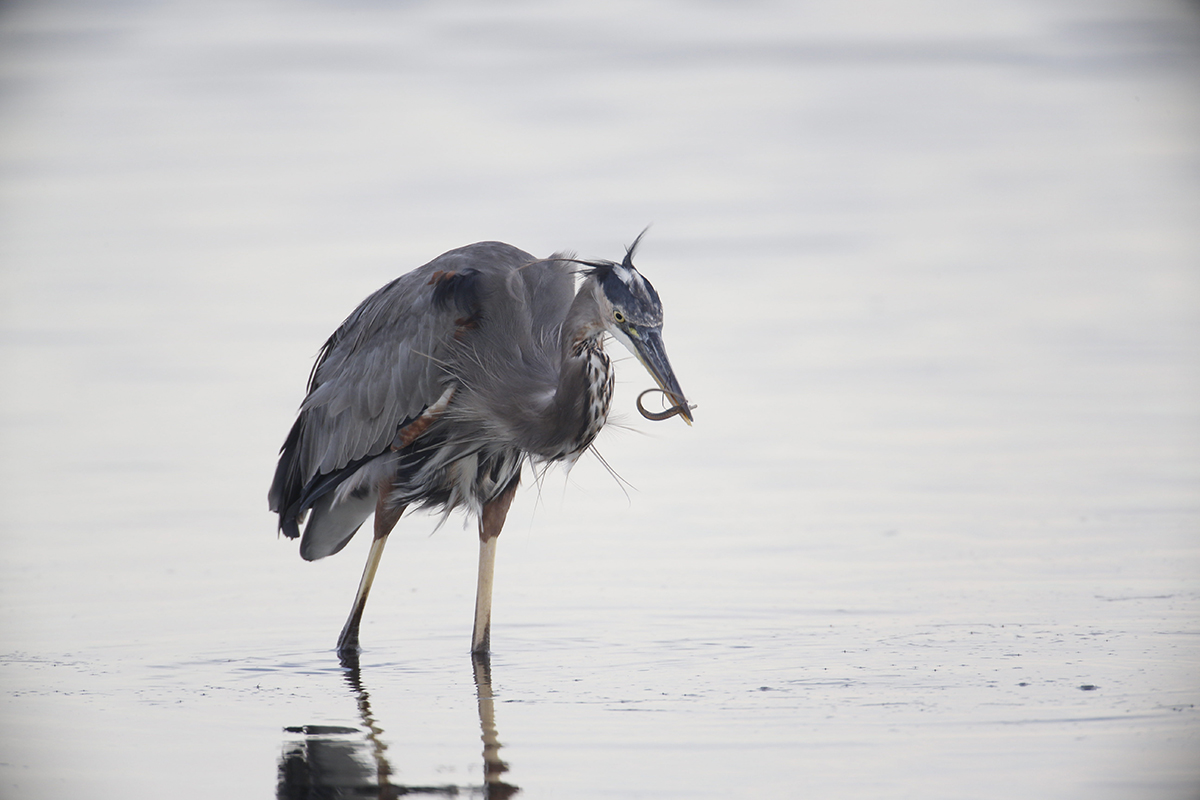
|
|
This image was created at Fort DeSoto Park on the cloudy afternoon of September 14, 2012 at 6:37pm with the Gitzo 3532 LS carbon fiber tripod, the Mongoose M3.6 head, the Canon EF 800mm f/5.6L IS USM lens, the Canon Extender EF 1.4X III, and the Canon EOS-1D X). ISO 800. Evaluative metering +1 stop as framed: 1/1250 sec. at f/8. Should have been +2 2/3 stops….
Central sensor/AI Servo/Surround Rear Focus AF on the front center of the curve of he neck as framed above was active at the moment of exposure. Click here to see the latest version of the Rear Focus Tutorial. Click on the image to see a larger version. This is the full frame original (well under-exposed) image capture.
|
Great Blue Heron with Small Pipefish
Sometimes we simply screw up the exposure. It happens to me on occasion when I am in too much of a hurry. When we do, dealing with the noise caused by underexposure has always been a problem. As you can see by taking a close look at the optimized image below, DPP 4.0 does a great job with handling the noise caused by underexposures, even relatively severe underexposures. Arash spent many days and countless hours coming up with his suggested values for both luminance and chrominance noise reduction. The two charts in the new eGuide–coming fairly soon, include his recommended values for the 5D Mark III/6D and for the 1D X for each ISO from 400 to 6400. In every case that I have encountered Arash’s values out-performed the values that were automatically suggested by DPP 4.0 in terms of reducing noise while maintaining fine feather detail.
|
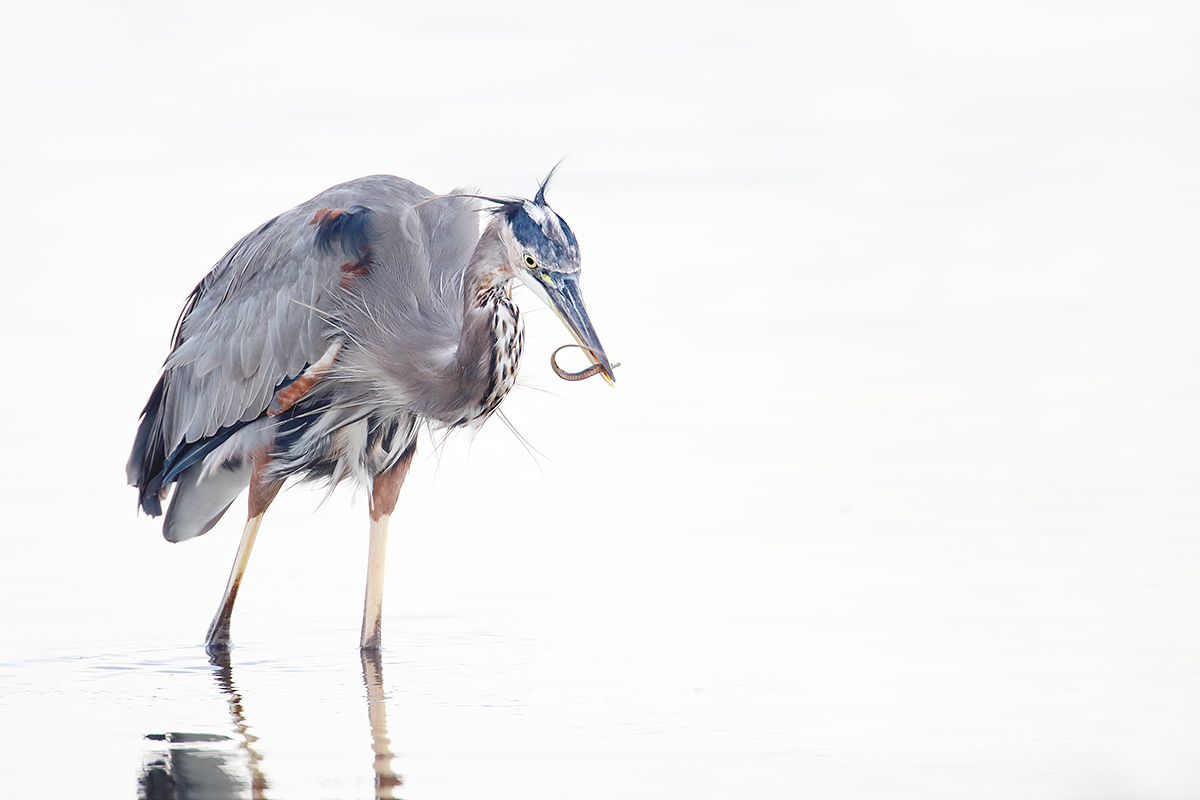
|
|
This is the optimized image that was created from the underexposed original image that opened this blog post.
|
DPP 4.0 Before and After Magic
After opening this image in DPP 4.0 the first thing that I did was move the Brightness slider one full stop to the right to 1.00. Then I moved the Shadow slider to the right to +2.2 to bring up the darker tones a bit more. Then I increased both the Contrast and the Saturation one click to 1.0. Next, on the Adjust image detail tab, I applied Arash’s brilliant noise reduction values for the 1D X at ISO 800 as described above. In the new guide we teach you how to easily compare before and after magnified views. Unfortunately the Lens data for the Canon 800mm f/5.6L IS lens is not and never has been available for any version of DPP. As a result, I had to deal with the vignetting in Photoshop after the RAW file was converted. I used both the Crop Tool and the Clone Stamp Tool (that latter at 80%). That was followed by a bit of water surface clean-up, NIK 50-50 on the face and neck, dust spotting, and selective sharpening of the face and neck via a Contrast Mask. Then I saved my master file, duplicated the image for safety, cropped the copy to 1200 pixels wide, sharpened it, and used Save for Web optimized to < 395kb for both the blog and for posting on BPN. Done deal.
The DPP RAW Conversion Guide
To learn why I use Canon’s Digital Photo Professional (DPP) to convert every image that I work on, click here. Coming soon: The DPP 4.0 RAW Conversion Guide by Arash Hazeghi and Arthur Morris. The more that I use DPP 4.0 for my RAW conversions the more I am impressed with it. Today, I will be finishing up my edit of our new DPP RAW Conversion eGuide. Note: at present, DPP 4.0 supports only 1D X, 5D Mark III, and 6D images.
Digital Basics
Everything that I did to optimize today’s image is covered in detail in my Digital Basics File–written in my easy-to-follow, easy-to-understand style. Are you tired of making your images look worse in Photoshop? Digital Basics File is an instructional PDF that is sent via e-mail. It includes my complete digital workflow, dozens of great Photoshop tips, details on using all of my killer image clean-up tools, the use of Contrast Masks, several different ways of expanding and filling in canvas, all of my time-saving Keyboard Shortcuts, Quick Masking, Layer Masking, and NIK Color Efex Pro basics, Digital Eye Doctor, Tim Grey Dodge and Burn, how to create time-saving actions, and tons more.
|

|
|
Fort DeSoto in fall is rich with tame birds. All of the images in this card were created at Fort DeSoto in either late September or early October. I hope that you can join me there this October. Click on the composite to enjoy a larger version.
|
First-ever BIRDS AS ART In-the-Field/Meetup Workshop Session (ITF/MWS): $50
Join me on the afternoon of October 10, 2014 for 3-hours of photographic instruction at Fort DeSoto Park. Beginners are welcome. Lenses of 300mm or longer are recommended but even those with 70-200s should get to make some nice images. Teleconverters are always a plus.
You will learn the basics of digital exposure and image design, autofocus basics, and how to get close to free and wild birds. We should get to photograph a variety of wading birds, shorebirds, terns, and gulls. This inexpensive afternoon workshop is designed to give folks a taste of the level and the quality of instruction that is provided on BIRDS AS ART Instructional Photo-tours. I hope to meet you there.
To register please call Jim or Jennifer during weekday business hours with a credit card in hand to pay the nominal registration fee. Your registration fee is non-refundable. You will receive a short e-mail with instructions, gear advice, and meeting place at least two weeks before the event.
|

|
|
Obviously folks attending the IPT will be out in the field early and stay late to take advantage of sunrise and sunset colors. The good news is that the days are relatively short in October. Click on the composite to enjoy a larger version.
|
Fort DeSoto Fall IPT/October 11-13, 2014. 3 FULL DAYs: $1099. Limit 8/Openings 5.
Fort DeSoto, located just south of St. Petersburg, FL, is a mecca for migrant shorebirds in fall. There they join hundreds of egrets, herons, night-herons, gulls, and terns who winter on the T-shaped peninsula that serves as their wintering grounds. With any luck, we should get to photograph two of Florida’s most desirable shorebird species: Marbled Godwit and the spectacular Long-billed Curlew. Black-bellied Plover and Willet are easy, American Oystercatcher likely. Great Egret, Snowy Egret, Great Blue Heron, and Tricolored Heron are easy as well and we will almost surely come up with a tame Yellow-crowned Night-Heron or two. We should get to do some Brown Pelican flight photography. And Royal, Sandwich, Forster’s, and Caspian Terns will likely provide us with some good flight opportunities as well. Though not guaranteed Roseate Spoonbill and Wood Stork would not be unexpected.
Folks who sign up for the IPT are welcome to join us on the ITF/MWS on Friday afternoon as my guest. See above for details on that.
On the IPT you will learn basics and fine points of digital exposure and to get the right exposure every time after making a single test exposure, how to approach free and wild birds without disturbing them, to understand and predict bird behavior, to identify many species of shorebirds, to spot the good situations, to choose the best perspective, to see and understand the light, to, and to design pleasing images by mastering your camera’s AF system. And you will learn learn how and why to work in Manual mode (even if you’re scared of it).
At lunch (included) we will review my images–folks learn a ton watching me edit–why keep this one and delete that one. If you opt to bring your laptop, we will take a look at five of your best images from the morning session. We will process a few of my images in Photoshop after converting them in DPP. That followed by Instructor Nap Time.
If you decide to register and are traveling to attend this IPT, please make your reservations at the Beachcomber Beach Resort, 6200 Gulf Blvd, St. Petersburg (St. Pete Beach), FL 33706 (727-367-1902) as soon as possible as rooms for the weekend days are scarce: ARR: 10 OCT/DEP 14 OCT. I stayed there on my last DeSoto visit and was quite happy with it. Lodging is tough in Florida at this season…. The best airport is Tampa (TPA). It is always best if IPT folks stay in the same hotel so if you are interested it would be a good idea to register now and make your hotel reservations as well. We can, however, coordinate easily with local folks who opt to stay at home either by cell phone or e-mail.
Because of the relatively late date, payment is full is due upon registration either by check or credit card. If the former, please e-mail us immediately so that we can save you a spot. If the latter, please call Jim or Jennifer during weekday business hours at 863-692-0906 with a credit card in hand to register . Your registration fee is non-refundable unless the IPT sells out with eight so please check your plans carefully before committing. You will receive a confirmation e-mail with detailed instructions, gear advice, and first morning meeting place about one month before this IPT.
|

|
|
BAA Site Guides are the next best thing to being on an IPT.
|
Fort DeSoto Site Guide
Can’t make the IPT? Get yourself a copy of the Fort DeSoto Site Guide. Learn the best spots, where to be when in what season in what weather. Learn the best wind directions for the various locations. BAA Site Guides are the next best thing to being on an IPT. You can see all of them here.
Facebook
Be sure to like and follow BAA on Facebook by clicking on the logo link upper right. Tanks a stack!
Support the BAA Blog. Support the BAA Bulletins: Shop B&H here!
We want and need to keep providing you with the latest free information, photography and Photoshop lessons, and all manner of related information. Show your appreciation by making your purchases immediately after clicking on any of our B&H or Amazon Affiliate links in this blog post. Remember, B&H ain’t just photography!
…..
Amazon.com
Those who prefer to support BAA by shopping with Amazon may use this link:
Amazon Canada
Many kind folks from north of the border, ay, have e-mailed stating that they would love to help us out by using one of our affiliate links but that living in Canada and doing so presents numerous problems. Now, they can help us out by using our Amazon Canada affiliate link by starting their searches by clicking here. Many thanks to those who have written.
Typos
In all blog posts and Bulletins, feel free to e-mail or to leave a comment regarding any typos, wrong words, misspellings, omissions, or grammatical errors. Just be right. 🙂
September 17th, 2014 EOS-7D Mark II Thanks!
Thanks a stack to the 15 folks who pre-ordered their EOS 7D Mark II bodies (and lots of accessories) using a BAA affiliate link. If you missed all of yesterday’s excitement, click here. And best of luck to Geoffrey Cuff of the Cayman Islands with the Canon EF 400mm f/4 DO IS II USM Lens that he ordered in similar fashion.
Convinced? Click on the logo-link immediately below to pre-order yours. This will be one hot-ticket item; the sooner you get your name on the pre-order list, the sooner you will have a 7D II in your hands.
The Streak Continues: 291
I spent a great deal of time on Tuesday doing additional research on the new EOS-7D Mark II. I will share what I have learned with you here soon. The rest of the day was made up of meditating, a nice easy swim, healthy eating, a short nap, a 44 minute ice bath, and answering about a zillion e-mails. All that followed by a rare-for-me 8 full hours of sleep. I will be hard working on editing the first draft of the DPP 4.0 RAW Conversion eGuide that I am doing with Arash Hazeghi. I am getting very close…. This blog post, the 291st in a row, was published at about 6:30am from my home in Indian Lake Estates, FL.
As always, I would appreciate your using the BIRDS AS ART B&H affiliate links for all of your major gear, video, and electronic purchases, using our Amazon logo-link for all of your household purchases, and visiting the BAA Online Store for your tripod, tripod head, LensCoat, miscellaneous, accessories, and eGuide purchases as well. Please remember, web orders only. 🙂
|

|
|
This image was created on the morning of September 16, 2012 at Fort DeSoto Park, Tierra Verde, FL, southwest of St. Petersburg, FL. I used the hand held Canon 500mm f/4L EF IS II lens, the Canon 1.4x EF tele-extender III, and the Canon EOS-1D X. ISO 800. Evaluative metering +2 2/3 stops off the light grey sky: 1/1600 sec. at f/6.3 in Manual mode.
Central Sensor Surround/AI Servo Rear Focus AF on the gowit’s face and recompose. Click here to see the latest version of the Rear Focus Tutorial. Be sure to click on the image for a larger version.
|
Difficult Questions
Though I did not process this image until just before my ice bath on Tuesday evening, I have always liked it. I especially like the soft light. I like how the brown tones of the godwit pick up the brown tones in the distant background. And y’all know that I love shorebirds, especially Marbled Godwits. When I saw one just after sunrise on the South Flats of the East Pond at Jamaica Bay Wildlife Refuge, Queens, NY probably 36 years ago, I had no idea that that experience would change the remainder of my adult life. But it did just that.
I was lying flat down in wet sand when I created this image. A bit later the sun was coming in and out and I had a great time photographing the flying Sandwich, Royal, and Caspian Terns that were landing right in front of me. You gotta love winds with an easterly component in the morning.
#1: Should I have tried to get higher by sitting up? y standing up? Why or why not?
#2: What do you think of the placement of the three birds in the frame? Would you have done anything differently as far as the image design is concerned?
#3: Why is it OK to use rear focus and recompose (which is effectively one-shot AF) when you are lying down but not OK to use rear focus and recompose (effectively one-shot AF) when you are sitting or standing? (In those cases you are much better off using AI Servo AF and keeping it active at the moment of exposure.) Why? What difference does it make if you are lying down as opposed to sitting or standing?
|

|
|
Fort DeSoto in fall is rich with tame birds. All of the images in this card were created at Fort DeSoto in either late September or early October. I hope that you can join me there this October. Click on the composite to enjoy a larger version.
|
First-ever BIRDS AS ART In-the-Field/Meetup Workshop Session (ITF/MWS): $50
Join me on the afternoon of October 10, 2014 for 3-hours of photographic instruction at Fort DeSoto Park. Beginners are welcome. Lenses of 300mm or longer are recommended but even those with 70-200s should get to make some nice images. Teleconverters are always a plus.
You will learn the basics of digital exposure and image design, autofocus basics, and how to get close to free and wild birds. We should get to photograph a variety of wading birds, shorebirds, terns, and gulls. This inexpensive afternoon workshop is designed to give folks a taste of the level and the quality of instruction that is provided on BIRDS AS ART Instructional Photo-tours. I hope to meet you there.
To register please call Jim or Jennifer during weekday business hours with a credit card in hand to pay the nominal registration fee. Your registration fee is non-refundable. You will receive a short e-mail with instructions, gear advice, and meeting place at least two weeks before the event.
|

|
|
Obviously folks attending the IPT will be out in the field early and stay late to take advantage of sunrise and sunset colors. The good news is that the days are relatively short in October. Click on the composite to enjoy a larger version.
|
Fort DeSoto Fall IPT/October 11-13, 2014. 3 FULL DAYs: $1099. Limit 8.
Fort DeSoto, located just south of St. Petersburg, FL, is a mecca for migrant shorebirds in fall. There they join hundreds of egrets, herons, night-herons, gulls, and terns who winter on the T-shaped peninsula that serves as their wintering grounds. With any luck, we should get to photograph two of Florida’s most desirable shorebird species: Marbled Godwit and the spectacular Long-billed Curlew. Black-bellied Plover and Willet are easy, American Oystercatcher likely. Great Egret, Snowy Egret, Great Blue Heron, and Tricolored Heron are easy as well and we will almost surely come up with a tame Yellow-crowned Night-Heron or two. We should get to do some Brown Pelican flight photography. And Royal, Sandwich, Forster’s, and Caspian Terns will likely provide us with some good flight opportunities as well. Though not guaranteed Roseate Spoonbill and Wood Stork would not be unexpected.
Folks who sign up for the IPT are welcome to join us on the ITF/MWS on Friday afternoon as my guest. See above for details on that.
On the IPT you will learn basics and fine points of digital exposure and to get the right exposure every time after making a single test exposure, how to approach free and wild birds without disturbing them, to understand and predict bird behavior, to identify many species of shorebirds, to spot the good situations, to choose the best perspective, to see and understand the light, to, and to design pleasing images by mastering your camera’s AF system. And you will learn learn how and why to work in Manual mode (even if you’re scared of it).
At lunch (included) we will review my images–folks learn a ton watching me edit–why keep this one and delete that one. If you opt to bring your laptop, we will take a look at five of your best images from the morning session. We will process a few of my images in Photoshop after converting them in DPP. That followed by Instructor Nap Time.
If you decide to register and are traveling to attend this IPT, please make your reservations at the Beachcomber Beach Resort, 6200 Gulf Blvd, St. Petersburg (St. Pete Beach), FL 33706 (727-367-1902) as soon as possible as rooms for the weekend days are scarce: ARR: 10 OCT/DEP 14 OCT. I stayed there on my last DeSoto visit and was quite happy with it. Lodging is tough in Florida at this season…. The best airport is Tampa (TPA). It is always best if IPT folks stay in the same hotel so if you are interested it would be a good idea to register now and make your hotel reservations as well. We can, however, coordinate easily with local folks who opt to stay at home either by cell phone or e-mail.
Because of the relatively late date, payment is full is due upon registration either by check or credit card. If the former, please e-mail us immediately so that we can save you a spot. If the latter, please call Jim or Jennifer during weekday business hours at 863-692-0906 with a credit card in hand to register . Your registration fee is non-refundable unless the IPT sells out with eight so please check your plans carefully before committing. You will receive a confirmation e-mail with detailed instructions, gear advice, and first morning meeting place about one month before this IPT.
|

|
|
BAA Site Guides are the next best thing to being on an IPT.
|
Fort DeSoto Site Guide
Can’t make the IPT? Get yourself a copy of the Fort DeSoto Site Guide. Learn the best spots, where to be when in what season in what weather. Learn the best wind directions for the various locations. BAA Site Guides are the next best thing to being on an IPT. You can see all of them here.
Facebook
Be sure to like and follow BAA on Facebook by clicking on the logo link upper right. Tanks a stack!
Support the BAA Blog. Support the BAA Bulletins: Shop B&H here!
We want and need to keep providing you with the latest free information, photography and Photoshop lessons, and all manner of related information. Show your appreciation by making your purchases immediately after clicking on any of our B&H or Amazon Affiliate links in this blog post. Remember, B&H ain’t just photography!
…..
Amazon.com
Those who prefer to support BAA by shopping with Amazon may use this link:
Amazon Canada
Many kind folks from north of the border, ay, have e-mailed stating that they would love to help us out by using one of our affiliate links but that living in Canada and doing so presents numerous problems. Now, they can help us out by using our Amazon Canada affiliate link by starting their searches by clicking here. Many thanks to those who have written.
Typos
In all blog posts and Bulletins, feel free to e-mail or to leave a comment regarding any typos, wrong words, misspellings, omissions, or grammatical errors. Just be right. 🙂
September 16th, 2014 The Streak Continues: 290
I was excused early from jury duty yesterday. Then it was back to work. I woke before 4am, did 45 minutes of meditation, and then got to work on this blog post. This post, published at about 6:45am, took me about 1 3/4 hours to prepare and makes 290 in a row.
As always, I would appreciate your using the BIRDS AS ART B&H affiliate links for all of your major gear, video, and electronic purchases, using our Amazon logo-link for all of your household purchases, and visiting the BAA Online Store for your tripod, tripod head, LensCoat, miscellaneous, accessories, and eGuide purchases as well. Please remember, web orders only. 🙂
Thanks a stack to all who pre-ordered there EOS 7D Mark II bodies using a BAA affiliate link. See lots more below.
|
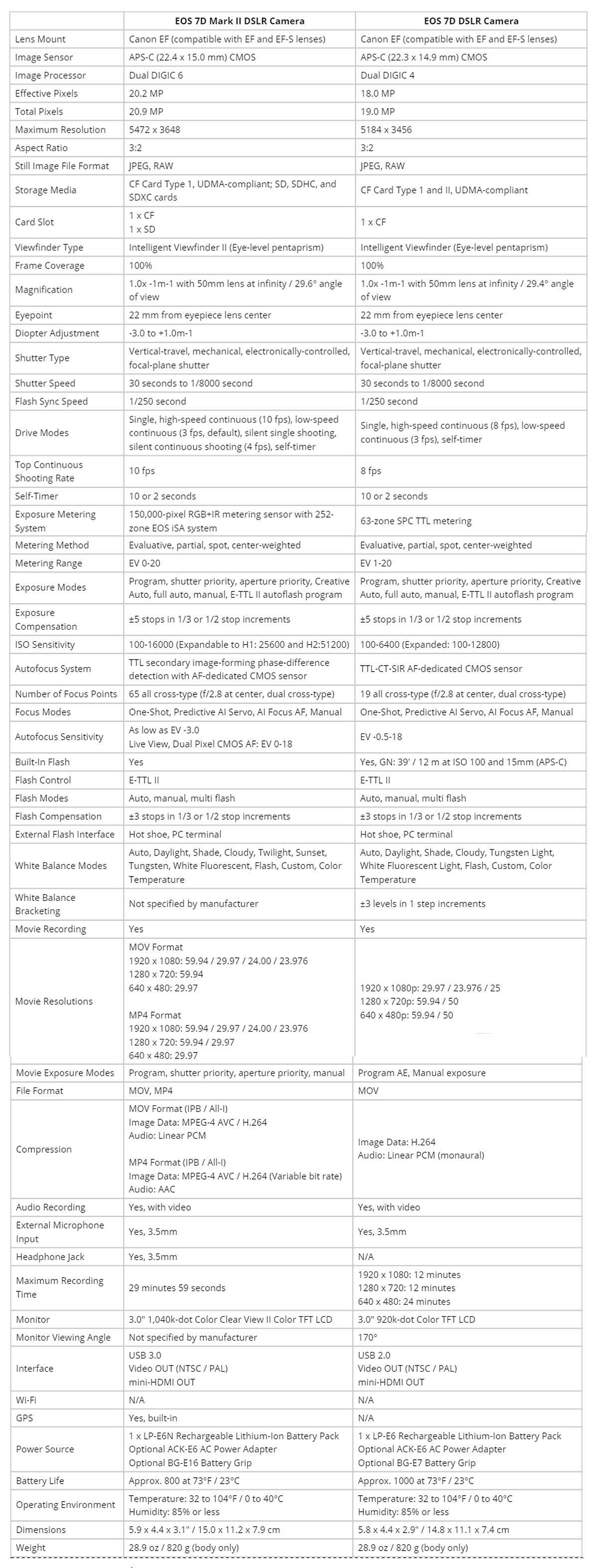
|
|
The Canon EOS-7D Mark II/EOS-7D Specifications Comparison Chart
|
The 7D II/7D Specs Comparison
What Jumps Out At Me?
First off, let’s not forget that the 7D II is a 1.6 crop factor camera that increases the effective focal length of you lens by 60%….
Is it likely that the Dual Digic 6 processors will yield higher quality images with less noise at the higher ISOs? Probably. To know for sure we need to get our hands on a 7D II, get out, create some images, and see how they look on a good monitor. To that end B&H ordered a loaner for me so I should have my hands on one of the first 7D II bodies. Today, I will try to arrange to borrow one from Canon for testing soon but success there for whatever ridiculous reasons is not likely. Some folks including me were not huge fans of the original 7D’s tiny pixels, especially at the higher ISOs and in cloudy or overcast conditions. That said, some folks, like BPN Avian Forum Moderator Dan Cadieux have done just fine with the 7D. If you are a non-believer, click here.
The addition of an SD card slot should make some folks happy. I never use them in fear of losing the tiny SD cards….
The top continuous shooting (frame) rate of 10 fps should make all bird and wildlife photographers happy. Be sure to read the fine print when it becomes available as the maximum frame rate often drops considerably when you go from One-Shot or Manual focus to AI Servo AF.
The new metering system sounds impressive but getting the right exposure will always be more about the photographer’s understanding of exposure theory and their camera’s metering system than about the camera’s metering system….
The expanded ISO Sensitivity (expandable to ISO 25,600 and ISO 51,200) is not likely to be of interest to most nature photographers.
The improved autofocus system sounds great but as always, the proof will be in the pudding. But the My T Fine Pudding is not yet on the shelves.
The improved low light AF sensitivity sounds great as well.
It’s been so long since I have used a 7D that I had forgotten that it has a Built-in Flash. That feature has been continued in the 7D II. I always enjoyed having a pop up flash available for both indoor shooting and for a very few nature photography applications.
I am not qualified to comment on the improvements in the movie capabilities of the new camera but they too sound exciting.
AF at f/8
Thanks to Nick and Geoff who left comments with links on the first 7D II blog post that indicate that the 7D II will AF to f/8. I followed the Canon Europe link and found this:
AF System/ Points: 65 cross-type AF points (Centre point is an extra sensitive dual-cross-type point at f/2.8, cross-type at f/8, and sensitive to -3EV).
This is a huge plus as folks will be able to AF with f/5.6 lenses and a 1.4X TC and will be able to AF with f/4 lenses and a 2X TC…. This is so huge that I will try to confirm it with Canon USA’s top technical representative Chuck Westfall today.
More Neat Stuff
A built-in intervalometer permits the creation of time-lapse imagery and supports recording 1-99 consecutive frames in pre-selected intervals. This sounds like a great feature that will make it easy for folks to experiment with time-lapse photography.
Your Call
If you feel that I missed something important, or if you have any questions on the comparative specifications chart, please leave a comment.
The info that follows was adapted from yesterday afternoon’s emergency blog post.
The Canon EOS-7D Mark II
I know that many of you who use a Canon 1.6 crop factor camera have been waiting too long for the rumored replacement for the EOS-7D. The Canon EOS 7D Mark II DSLR camera (body only) is now available for pre-order. If you are good to go, please use our B&H affiliate logo-link above to place your order. The sooner you order the sooner you will have your new camera in your hands. Right now I believe that they are looking at some time in November 2014. When this body hits the stores it is likely that it will be one of the hottest tickets ever; remember that some folks waited as long as six months to get their hands on a Series II super-telephoto lens or a 1D X…. If you order now and shoot me your B&H receipt via e-mail I will do my very best to have your order expedited.
Most will surely want to add the new Canon EOS 7D Mark II DSLR Camera (Body Only). To order yours simply continue shopping after ordering your 7D Mark II and do a search for “Canon BG-E16 Battery Grip for the EOS 7D Mark II.” It will pop right up.
There will be lots more on the 7D Mark II and on the new Canon EF 400mm f/4 DO IS II USM Lens as well on the blog in the very near future.
7D Mark II Video
You can see an exclusive 7D Mark II B&H video by clicking here.
Big Time Thanks/Only Two?
Big time thanks to Doug Schurman and Scott Mobley who each ordered two Canon EOS 7D Mark II bodies within minutes of seeing this blog notice. Each sent me their B&H receipts via e-mail; I will do my best to have their orders expedited when the shipments start arriving but as they will be on the top of the list they will likely not need my help. Scott also ordered two of the new battery grips and four of the new batteries, the Canon LP-E6N Lithium-Ion Battery Packs for EOS 7D Mark II.
Much appreciated guys!
This Just In!
Huge thanks to the following BAA Friends who pre-ordered their 7D IIs using our link and sent me their B&&H receipts so that I can follow up if need be:
David Policansky, Kirk Stitt, Bruce Finocchio, Walt Thomas, Bill Griswold, Steve Zarate, Ted Keltz, and Pam Higginbotham. Their support of my efforts here on the blog and elsewhere is greatly appreciated.
Facebook
Be sure to like and follow BAA on Facebook by clicking on the logo link upper right. Tanks a stack!
Support the BAA Blog. Support the BAA Bulletins: Shop B&H here!
We want and need to keep providing you with the latest free information, photography and Photoshop lessons, and all manner of related information. Show your appreciation by making your purchases immediately after clicking on any of our B&H or Amazon Affiliate links in this blog post. Remember, B&H ain’t just photography!
…..
Amazon.com
Those who prefer to support BAA by shopping with Amazon may use this link:
Amazon Canada
Many kind folks from north of the border, ay, have e-mailed stating that they would love to help us out by using one of our affiliate links but that living in Canada and doing so presents numerous problems. Now, they can help us out by using our Amazon Canada affiliate link by starting their searches by clicking here. Many thanks to those who have written.
Typos
In all blog posts and Bulletins, feel free to e-mail or to leave a comment regarding any typos, wrong words, misspellings, omissions, or grammatical errors. Just be right. 🙂
September 15th, 2014
The Canon EOS-7D Mark II
I know that many of you who use a Canon 1.6 crop factor camera have been waiting too long for the rumored replacement for the EOS-7D. The Canon EOS 7D Mark II DSLR camera (body only) is now available for pre-order. If you are good to go, please use our B&H affiliate logo-link above to place your order. The sooner you order the sooner you will have your new camera in your hands. Right now I believe that they are looking at some time in November 2014. When this body hits the stores it is likely that it will be one of the hottest tickets ever; remember that some folks waited as long as six months to get their hands on a Series II super-telephoto lens or a 1D X…. If you order now and shoot me your B&H receipt via e-mail I will do my very best to have your order expedited.
There will be lots more on the new 7D Mark II and on the new Canon EF 400mm f/4 DO IS II USM Lens as well on the blog in the very near future.
Most will surely want to add the new Canon EOS 7D Mark II DSLR Camera (Body Only). To order yours simply continue shopping after ordering your 7D Mark II and do a search for “Canon BG-E16 Battery Grip for the EOS 7D Mark II.” It will pop right up.
7D Mark II Video
You can see an exclusive 7D Mark II B&H video by clicking here.
Big Time Thanks/Only Two?
Big time thanks to Doug Schurman and Scott Mobley who each ordered two Canon EOS 7D Mark II bodies within minutes of seeing this blog notice. Each sent me their B&H receipts via e-mail; I will do my best to have their orders expedited when the shipments start arriving but as they will be on the top of the list they will likely now need my help. Scott also ordered two of the new battery grips and four of the new batteries, the Canon LP-E6N Lithium-Ion Battery Packs for EOS 7D Mark II.
Much appreciated guys!
Facebook
Be sure to like and follow BAA on Facebook by clicking on the logo link upper right. Tanks a stack!
Support the BAA Blog. Support the BAA Bulletins: Shop B&H here!
We want and need to keep providing you with the latest free information, photography and Photoshop lessons, and all manner of related information. Show your appreciation by making your purchases immediately after clicking on any of our B&H or Amazon Affiliate links in this blog post. Remember, B&H ain’t just photography!
…..
Amazon.com
Those who prefer to support BAA by shopping with Amazon may use this link:
Amazon Canada
Many kind folks from north of the border, ay, have e-mailed stating that they would love to help us out by using one of our affiliate links but that living in Canada and doing so presents numerous problems. Now, they can help us out by using our Amazon Canada affiliate link by starting their searches by clicking here. Many thanks to those who have written.
Typos
In all blog posts and Bulletins, feel free to e-mail or to leave a comment regarding any typos, wrong words, misspellings, omissions, or grammatical errors. Just be right. 🙂
September 15th, 2014 The Streak Continues: 289
I totally couch-potatoed it yesterday afternoon with the Fed-Ex golf and NFL on the big screen. In a zombie-like state, I fell asleep several times until I finally got into bed at about eleven. I woke at 3:45am and was trying to decide whether to try to go back to sleep or get up and finish this blog post when I remembered that I had to leave home at 6:30am this morning to head to the Polk County courthouse in Bartow to report for jury duty. Yikes!
This post, published at about 5:15am, took me about 1 3/4 hours to prepare and makes 289 in a row.
As always, I would appreciate your using the BIRDS AS ART B&H affiliate links for all of your major gear, video, and electronic purchases, using our Amazon logo-link for all of your household purchases, and visiting the BAA Online Store for your tripod, tripod head, LensCoat, miscellaneous, accessories, and eGuide purchases as well. Please remember, web orders only. 🙂
You can find the following items in the Store: Gitzo tripods, Mongoose M3.6 and Wimberley heads, plates, low feet, and accessories, flash brackets, , Delkin e-film Pro Compact Flash Cards, LensCoat products, and our unique line-up of educational materials including ABP I & II, Digital Basics, Site and Set-up e-Guides, Canon and Nikon Camera Users and AF e-Guides, and MP-4 Photoshop video tutorials among others.
For the photographic stuff mentioned in the paragraph above we, meaning BAA, would of course greatly appreciate your business. Purchasing the items listed above from B&H actually hurts us :). Here is a huge thank you to the many who have been using our links on a regular basis and visiting the BAA Online store as well.
Used Photography Gear Sales Updates
Mike Gotthelf’s 800mm f/5.6L IS and Walt Anderson’s EOS-1D Mark IV both sold this week. And amazingly, Brent Bridges sold his old 500 within two hours of publication of the blog. And then he sold his two Series II TCs that afternoon. Talk about effective….
Selling Your Used Photo Gear Through BIRDS AS ART
Selling your used (or like-new) photo gear through the BAA Blog or via a BAA Online Bulletin is a great idea. We charge only a 5% commission. One of the more popular used gear for sale sites charges a minimum of 20% plus assorted fees! Yikes. The minimum item price is $500 (or less for a $25 fee). If you are interested please e-mail with the words Items for Sale Info Request cut and pasted into the Subject line :). Stuff that is priced fairly–I offer free pricing advice, usually sells in no time flat. In the past few months, we have sold just about everything in sight. Click here to see all the current listings.
|
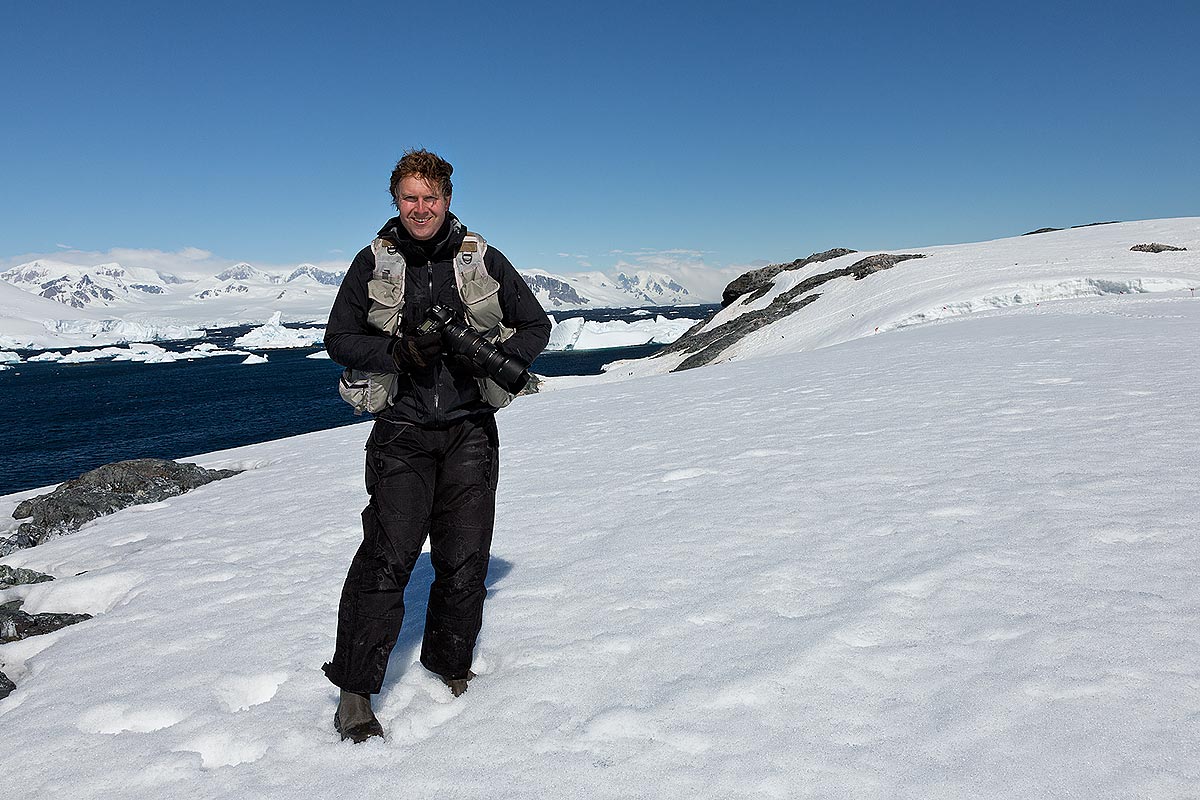
|
|
This image was created with the Canon 24-105mm f/4L IS EF USM AF lens hand held at 28mm with the Canon EOS 5D Mark III Digital camera body. ISO 400: 1/1600 sec. at f/13 in Manual mode.
Central sensor Surround/AI Servo/Rear Focus AF and recompose. Click here if you missed the Rear Focus Tutorial. Click on the image to see a larger, sharper version.
Image #1: A Happy Photographer… Detaille Island, Antarctica, south of the antarctic circle. Image courtesy of Clemens Van der Werf.
|
Exposure Quiz Answers and Explanations
In the blog post of September 8, 2014 here, I posted this:
Exposure Quiz
OK boys and girls, here is your chance to shine and show how much you have learned here. List the images by number like this:
#1:
#2:
#3:
#4:
#5:
#6: +1 1/3 stops.
and then type in what you think is the correct exposure compensation for each image. I have given you my best guess for #6. Nikon folks will on average need to add 2/3 stop to their Nikon exposure compensations. When we follow up I will share my thoughts on each exposure and we will have Clemens chime in with his best recollections.
Eight folks took a crack at it and most did fairly well.
I had Clemens e-mail me the exposure compensation that he thought had likely been used for each image. Prior to that, I sent myself an e-mail with the ECs that I though would be best.
Image #1
Image #1 was the most difficult of the six. Here’s how it looked to us: Clemens: +1/3. artie: +1. Even though the meter is smarter when the sun is out at full strength (as it was here) than it is in cloudy or overcast conditions, we both realized that at least some light needed to be added to bring up he detail on the black rain gear. I went with more plus than Clemens because the meter would be seeing lots of bright white in the center of the frame after re-composing. Ideally in this situation you would want a very few blinkies on the snow. Why? To make sure that you maximize detail on the black rain suit.
With image #1 we were 2/3 stop apart. For the next five we were either right-on or 1/3 stop apart. We hope that you are impressed :).
|
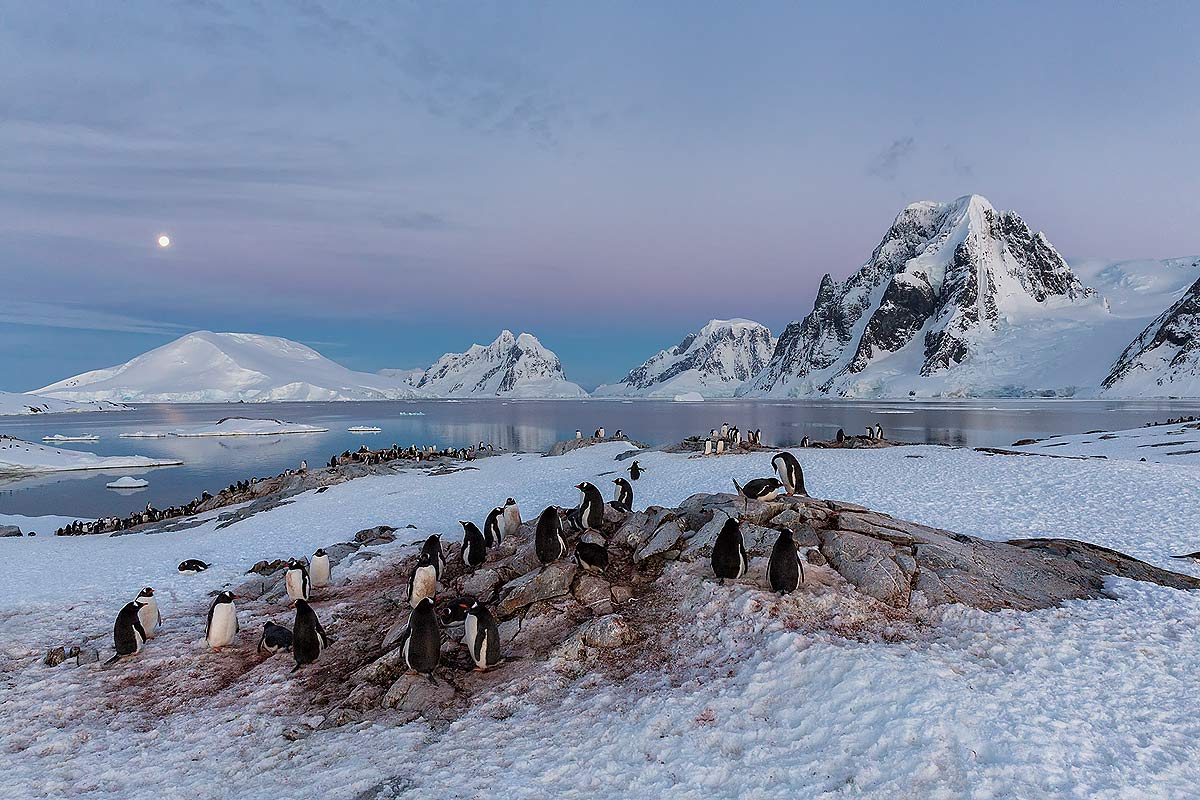
|
|
This image was created with the Canon EF 24-70mm f/2.8L II USM lens (hand held at 24mm) and the Canon EOS 5D Mark III. ISO 400: 1/80 sec. at f/8 in Manual mode.
Central sensor/AI Servo/Surround Rear Focus AF on the nearest penguin and re-compose. Click here to see the latest version of the Rear Focus Tutorial. Click on the image to see a larger version.
Image #2: Gentoo Penguins & full moon with a pink/purple/blue sky. Petermann Island, Antarctica , looking towards the south entrance of the Lemaire Channel. Image courtesy of and copyright 2013 Clemens Van der Werf.
|
Image #2
Clemens suggested +1 for this pink/purple/blue moonscape. I went with +1 1/3 stop. The key here is to realize that without the full moon in the frame you would want to add at least 2 stops of light to this image. But. And this is the important but. You want to make sure to avoid blinkies on the moon itself. Having faced this situation before, I would–in retrospect–agree that +1 would be safer than +1 1/3.
|
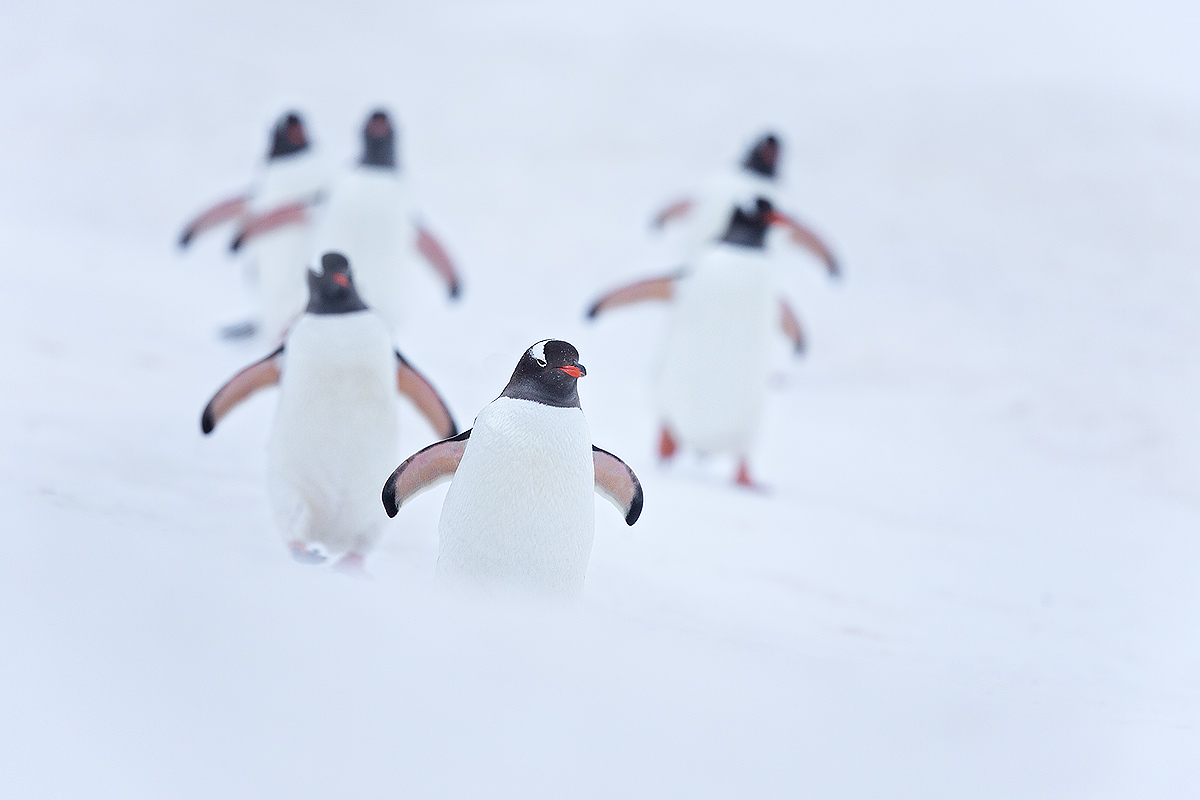
|
|
This image was created with the Canon EF 500mm f/4L IS II USM lens, a Canon Extender EF 1.4X III, and the Canon EOS 5D Mark III. ISO 400: 1/80 sec. at f/8 in Manual mode.
One sensor to the left of the central sensor/AI Servo/Surround Rear Focus AF on the neck of the nearest penguin was active at the moment of exposure. Click here to see the latest version of the Rear Focus Tutorial. Click on the image to see a larger version.
Image #3: Gentoo Penguin March. 3rd image: Yankee Harbor, South Shetlands Islands, Antarctica. Image courtesy of and copyright 2013 Clemens Van der Werf.
|
Image #3
For this whimsical image we both suggested an exposure compensation of +2 1/3 stops. How did we get so smart? In very soft light on cloudy days the camera’s meters are stupid; the lighter the overall tonality of the image, the stupider they are. Here the scene averages almost to pure white, thus a large positive EC is called for. Only the relatively tiny amounts of black on the penguin’s heads influence the meter to open up (albeit fractionally). +2 2/3 would likely not have hurt you here.
|
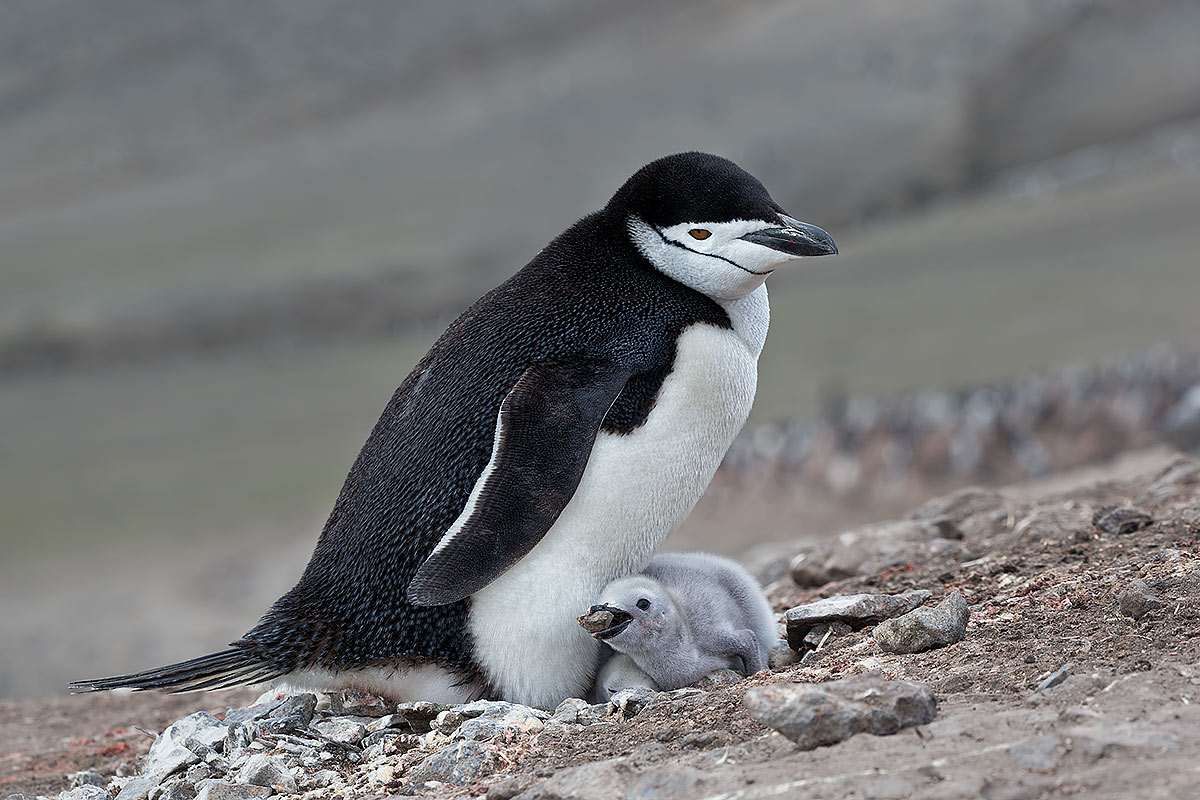
|
|
This image was created with the Sigma 50-500mm f/4.5-6.3 APO DG OS HSM lens for Canon EOS (hand held at 203mm) and the Canon EOS-1D X. ISO 500: 1/320 sec. at f/11 in Manual mode.
Central sensor/AI Servo/Surround Rear Focus AF on the nearest penguin and re-compose. Click here to see the latest version of the Rear Focus Tutorial. Click on the image to see a larger version.
Image #4: Chinstrap Penguin at nest with grown chick. Bailey Head, South Shetland Islands, Antarctica. Image courtesy of and copyright 2013 Clemens Van der Werf.
|
Image #4
This one was another close call with the choice being between +1 (my suggested EC) and Clemen’s +2/3. With the very soft light and the close to but slightly lighter than a middle-toned background the trick here is to wind up with bright whites on the penguins belly and thus as much light as possible on the dark tones of the bird’s upperparts. Which exposure would have been perfect here? Whichever one would have avoided significant blinkies on the penguin’s white feathers.
|
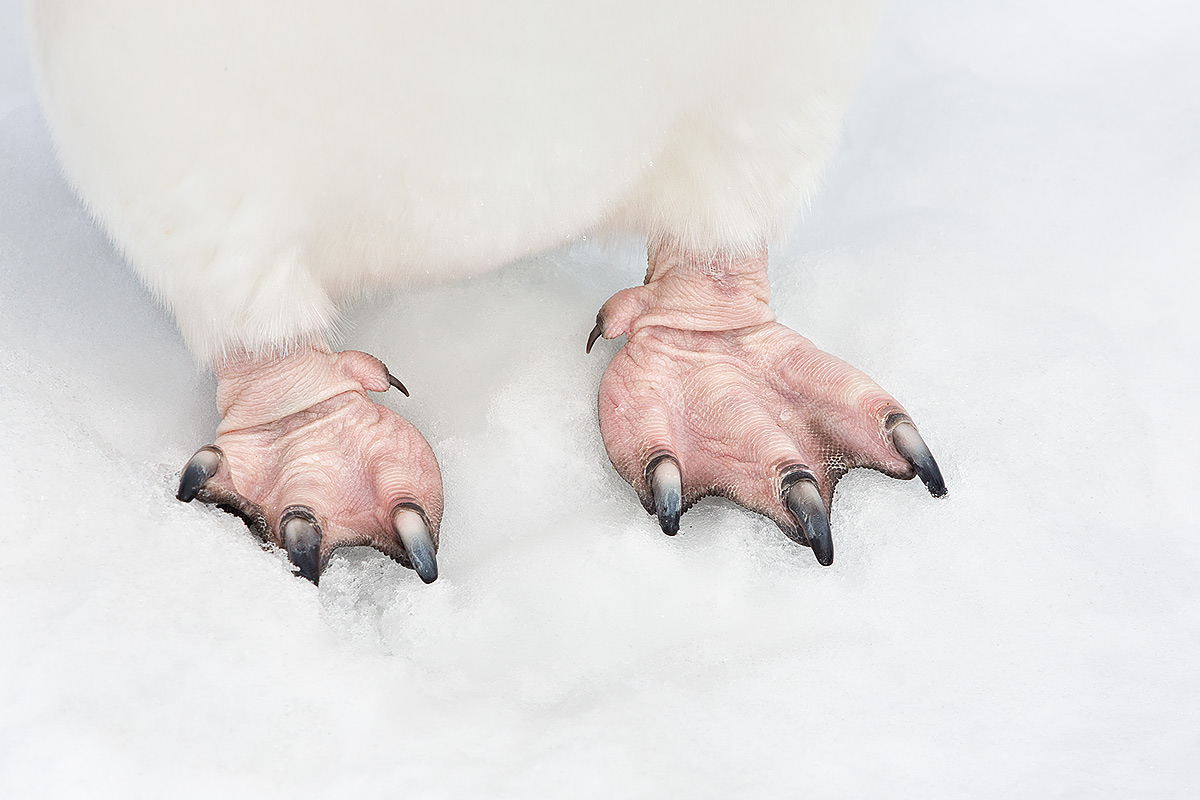
|
|
This image was created with the Sigma 50-500mm f/4.5-6.3 APO DG OS HSM lens for Canon EOS (this one hand held at 500mm) and the Canon EOS 5D Mark III. ISO 400: 1/320 sec. at f/16 in Manual mode.
Central sensor/AI Servo/Surround Rear Focus AF behind the base of the long toe on the bird’s left foot and re-compose. Click here to see the latest version of the Rear Focus Tutorial. Click on the image to see a larger version.
Image #5: Chinstrap Penguin, close-up of feet. Penguin Island, South Shetland Islands, Antarctica. Image courtesy of and copyright 2013 Clemens Van der Werf.
|
Image #5
This was another very close call. I hemmed and hawed when trying to decide between Clemens’ +2 1/3 stops and the +2 2/3 stops that I eventually went with. Why so much plus compensation? The light is soft and the scene averages nearly to pure white. Note that at point-blank range Clemens went with a small aperture to ensure that the feet were sharp from front to back.
|
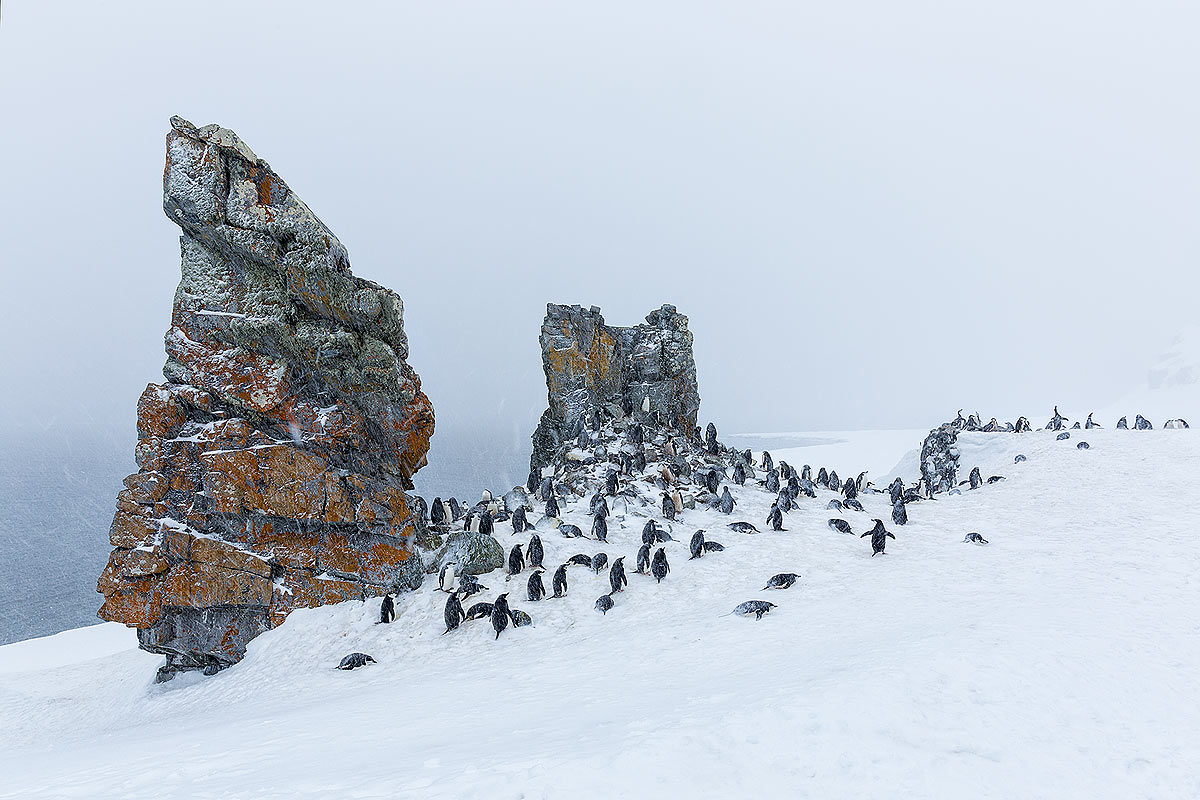
|
|
This image was also created with the Canon EF 24-70mm f/2.8L II USM lens (hand held again at 24mm) and the Canon EOS 5D Mark III. ISO 400: 1/60 sec. at f/14 in Manual mode.
Central sensor/AI Servo/Surround Rear Focus AF on the second closest penguin and re-compose. Click here to see the latest version of the Rear Focus Tutorial. Click on the image to see a larger version.
Image #6: Chinstrap Penguins & rock formations. Half Moon Island, South Shetland Islands, Antarctica. Image courtesy of and copyright 2013 Clemens Van der Werf.
|
Image #6
Both Clemens and I knew that +1 1/3 stop would be perfect here. Why not +2 or more stops here? Because the dark rock formation that occupied a good portion of the frame would influence the meter toward over-exposure.
Kudos to Tom Lamb whose suggested Exposure Compensations matched either Clemens’ or mine in five of the six cases. His sixth one (Image #3) missed by only 1/3 stop. Art Buesing was a close second.
|

|
|
Fort DeSoto in fall is rich with tame birds. All of the images in this card were created at Fort DeSoto in either late September or early October. I hope that you can join me there this October. Click on the composite to enjoy a larger version.
|
First-ever BIRDS AS ART In-the-Field/Meetup Workshop Session (ITF/MWS): $50
Join me on the afternoon of October 10, 2014 for 3-hours of photographic instruction at Fort DeSoto Park. Beginners are welcome. Lenses of 300mm or longer are recommended but even those with 70-200s should get to make some nice images. Teleconverters are always a plus.
You will learn the basics of digital exposure and image design, autofocus basics, and how to get close to free and wild birds. We should get to photograph a variety of wading birds, shorebirds, terns, and gulls. This inexpensive afternoon workshop is designed to give folks a taste of the level and the quality of instruction that is provided on BIRDS AS ART Instructional Photo-tours. I hope to meet you there.
To register please call Jim or Jennifer during weekday business hours with a credit card in hand to pay the nominal registration fee. Your registration fee is non-refundable. You will receive a short e-mail with instructions, gear advice, and meeting place at least two weeks before the event.
|

|
|
Obviously folks attending the IPT will be out in the field early and stay late to take advantage of sunrise and sunset colors. The good news is that the days are relatively short in October. Click on the composite to enjoy a larger version.
|
Fort DeSoto Fall IPT/October 11-13, 2014. 3 FULL DAYs: $1099. Limit 8.
Fort DeSoto, located just south of St. Petersburg, FL, is a mecca for migrant shorebirds in fall. There they join hundreds of egrets, herons, night-herons, gulls, and terns who winter on the T-shaped peninsula that serves as their wintering grounds. With any luck, we should get to photograph two of Florida’s most desirable shorebird species: Marbled Godwit and the spectacular Long-billed Curlew. Black-bellied Plover and Willet are easy, American Oystercatcher likely. Great Egret, Snowy Egret, Great Blue Heron, and Tricolored Heron are easy as well and we will almost surely come up with a tame Yellow-crowned Night-Heron or two. We should get to do some Brown Pelican flight photography. And Royal, Sandwich, Forster’s, and Caspian Terns will likely provide us with some good flight opportunities as well. Though not guaranteed Roseate Spoonbill and Wood Stork would not be unexpected.
Folks who sign up for the IPT are welcome to join us on the ITF/MWS on Friday afternoon as my guest. See above for details on that.
On the IPT you will learn basics and fine points of digital exposure and to get the right exposure every time after making a single test exposure, how to approach free and wild birds without disturbing them, to understand and predict bird behavior, to identify many species of shorebirds, to spot the good situations, to choose the best perspective, to see and understand the light, to, and to design pleasing images by mastering your camera’s AF system. And you will learn learn how and why to work in Manual mode (even if you’re scared of it).
At lunch (included) we will review my images–folks learn a ton watching me edit–why keep this one and delete that one. If you opt to bring your laptop, we will take a look at five of your best images from the morning session. We will process a few of my images in Photoshop after converting them in DPP. That followed by Instructor Nap Time.
If you decide to register and are traveling to attend this IPT, please make your reservations at the Beachcomber Beach Resort, 6200 Gulf Blvd, St. Petersburg (St. Pete Beach), FL 33706 (727-367-1902) as soon as possible as rooms for the weekend days are scarce: ARR: 10 OCT/DEP 14 OCT. I stayed there on my last DeSoto visit and was quite happy with it. Lodging is tough in Florida at this season…. The best airport is Tampa (TPA). It is always best if IPT folks stay in the same hotel so if you are interested it would be a good idea to register now and make your hotel reservations as well. We can, however, coordinate easily with local folks who opt to stay at home either by cell phone or e-mail.
Because of the relatively late date, payment is full is due upon registration either by check or credit card. If the former, please e-mail us immediately so that we can save you a spot. If the latter, please call Jim or Jennifer during weekday business hours at 863-692-0906 with a credit card in hand to register . Your registration fee is non-refundable unless the IPT sells out with eight so please check your plans carefully before committing. You will receive a confirmation e-mail with detailed instructions, gear advice, and first morning meeting place about one month before this IPT.
|

|
|
BAA Site Guides are the next best thing to being on an IPT.
|
Fort DeSoto Site Guide
Can’t make the IPT? Get yourself a copy of the Fort DeSoto Site Guide. Learn the best spots, where to be when in what season in what weather. Learn the best wind directions for the various locations. BAA Site Guides are the next best thing to being on an IPT. You can see all of them here.
Facebook
Be sure to like and follow BAA on Facebook by clicking on the logo link upper right. Tanks a stack!
Support the BAA Blog. Support the BAA Bulletins: Shop B&H here!
We want and need to keep providing you with the latest free information, photography and Photoshop lessons, and all manner of related information. Show your appreciation by making your purchases immediately after clicking on any of our B&H or Amazon Affiliate links in this blog post. Remember, B&H ain’t just photography!
…..
Amazon.com
Those who prefer to support BAA by shopping with Amazon may use this link:
Amazon Canada
Many kind folks from north of the border, ay, have e-mailed stating that they would love to help us out by using one of our affiliate links but that living in Canada and doing so presents numerous problems. Now, they can help us out by using our Amazon Canada affiliate link by starting their searches by clicking here. Many thanks to those who have written.
Typos
In all blog posts and Bulletins, feel free to e-mail or to leave a comment regarding any typos, wrong words, misspellings, omissions, or grammatical errors. Just be right. 🙂
September 14th, 2014 The Streak Continues: 288
Sleeping till after 6:00am was a rare treat. I guess that I needed it. I did spend lots more time yesterday working on the DPP 4.0 RAW Conversion eGuide and enjoyed a short, easy swim of about 2/3 mile. That and a short afternoon nap. This post, published at about 7:45am, took me about 1 3/4 hours to prepare and makes 288 in a row.
As always, I would appreciate your using the BIRDS AS ART B&H affiliate links for all of your major gear, video, and electronic purchases, using our Amazon logo-link for all of your household purchases, and visiting the BAA Online Store for your tripod, tripod head, LensCoat, miscellaneous, accessories, and eGuide purchases as well. Please remember, web orders only. 🙂
|
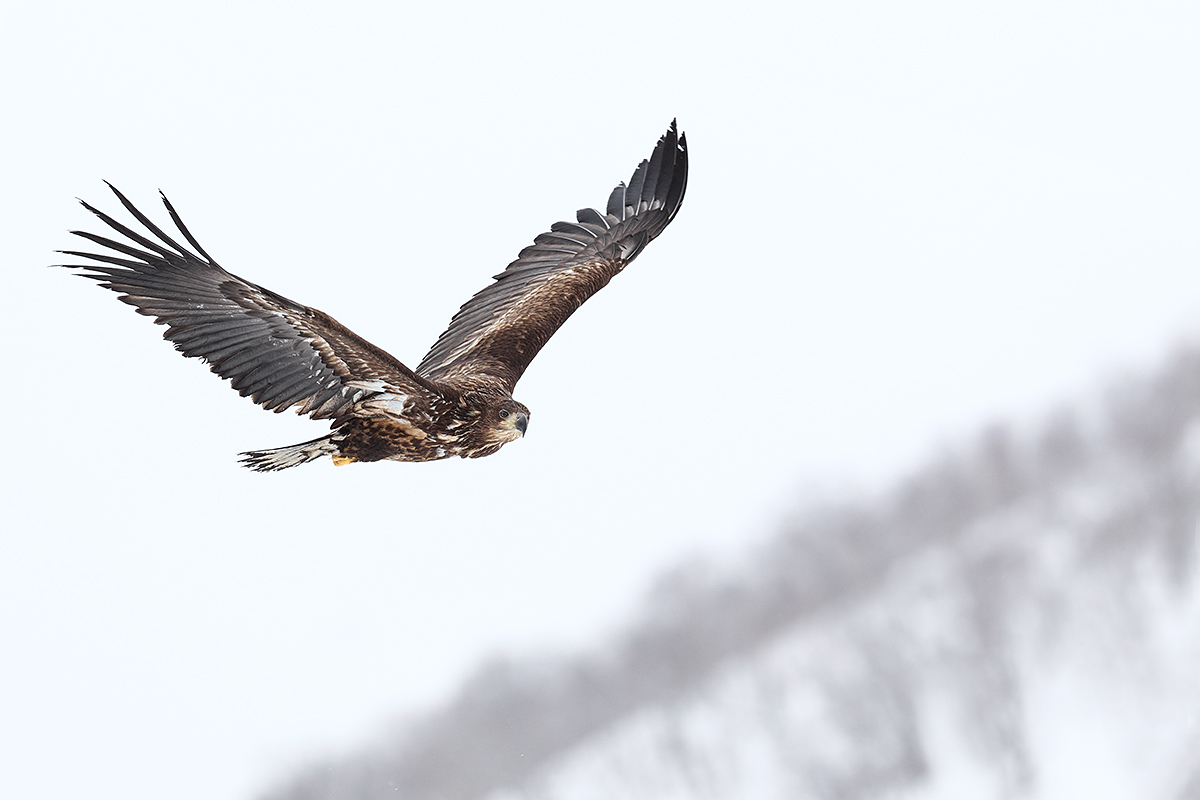
|
|
This image was created at 8:19am on February 27, on one of what I call the sea-eagle tourist boats in Rausu on the 2012 Japan in winter IPT, my first. I used the hand held Canon EF 300mm f/2.8L IS II USM lens and the EOS-1D Mark IV (now replaced by the Canon EOS-1D X). ISO 400. Evaluative metering +2 2/3 stop off the sky in cloudy conditions: 1/1250 sec. at f/4 in Manual mode. AWB.
Central sensor/AI Servo-Surround/Rear Focus AF as framed squarely on the bird’s face was active at the moment of exposure. Click here to see the latest version of the Rear Focus Tutorial. Click on the image to see a larger version.
Immature White-tailed Sea-eagle
|
The EF 300mm f2.8L IS II in Japan
As we have been seeing here for well more than a year, and contrary to my prior opinion of about three decades, the 300mm f/2.8L IS (and VR) lenses can be extremely valuable for bird photography in a variety of situations including and especially hand held flight. Please do not ask me how I got three super-telephoto lenses on my 2014 trip to Japan: the Canon EF 300mm f/2.8L IS II, the Canon EF 200-400mm f/4L IS USM lens with Internal 1.4x Extender, and the Canon EF 600mm f/4L IS II.
In any case I did, and I was glad that I did. The 300 II was great for hand held flight with several species, the 600 II for the Red-crowned Cranes, and the 200-400 for the sea-eagles and the Snow Monkeys.
White-tailed Sea-eagles
White-taileds larger, showier cousin, the Steller’s Sea-Eagle, is the prime target of most photographers visiting Japan. I have to admit it but at times I have to force myself to photograph the white-taileds…. IAC, you need to remember to go two or three clicks lighter for the juvies of this species as they do not have any of the bright patches of white that the adult Steller’s have. One or two clicks lighter is perfect for the adult white-taileds as the white on their tails is nowhere near as bright as the whites on the adult Steller’s
|
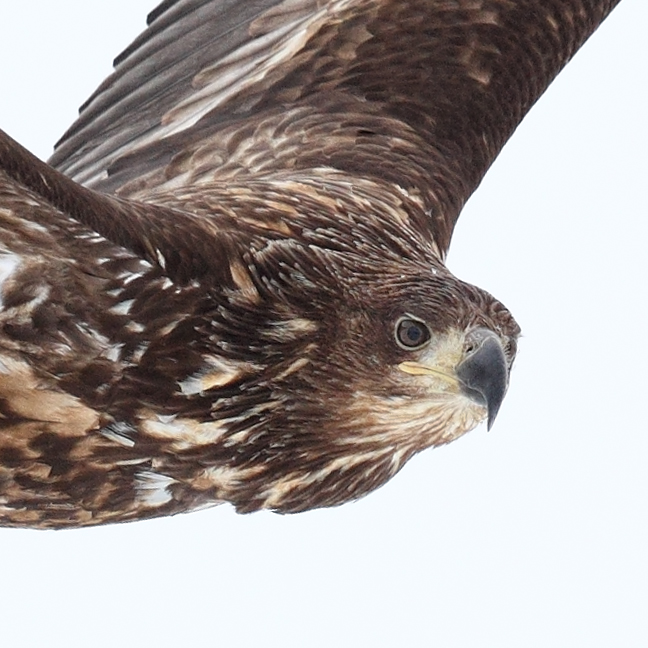
|
|
This is a tight crop of the unsharpened optimized TIFF file. Click on the image to enjoy a large version.
|
How Sharp is Sharp?
How sharp is sharp? Take a close look at the unsharpened image above and you be the judge.
|
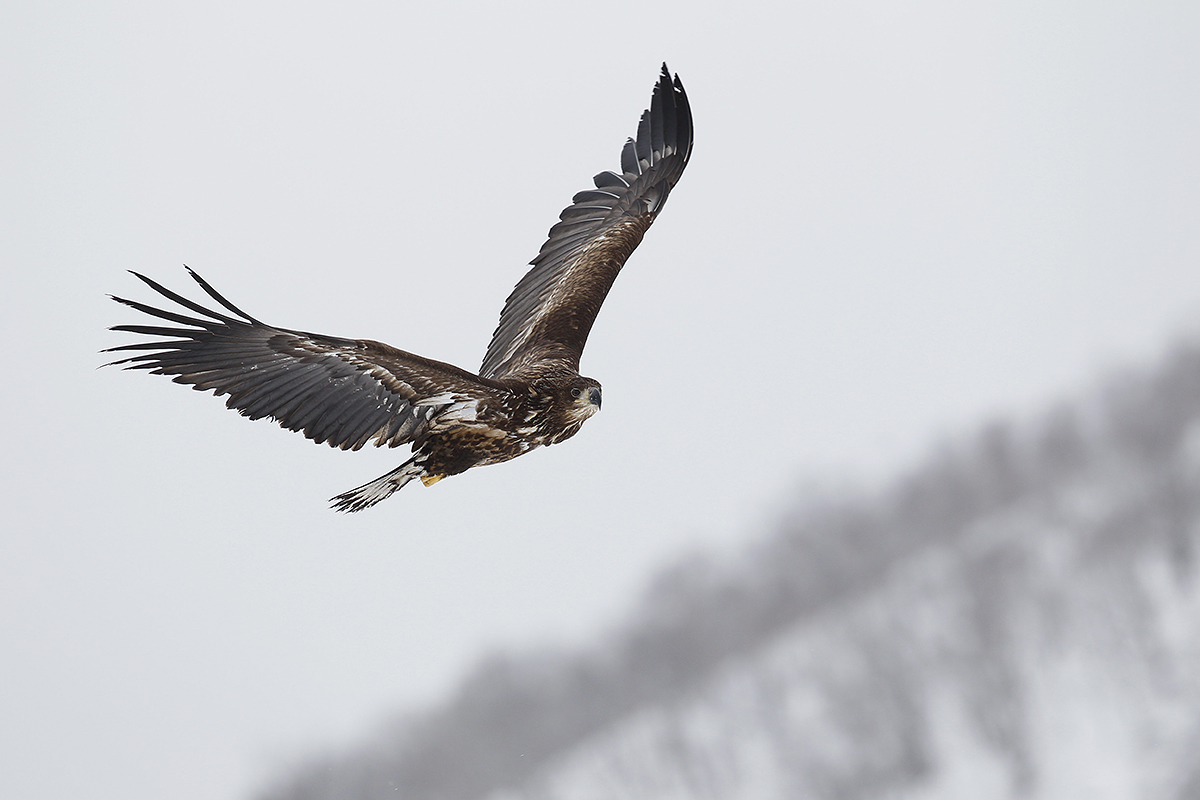
|
|
This JPEG, created from the embedded JPEG, represents the original RAW capture as it came out of the camera.
|
The Image Optimization
I did the RAW conversion in DPP 3.4.0.0. DPP 4.0 does not at present support EOS-1D Mark IV images. I did open up the dark tones during the RAW conversion with both the Brightness and the Shadow sliders.
Once I got the image into Adobe Photoshop CS-6, I had two main concerns. Since the bird appeared to be flying uphill, I wanted to level the bird in flight. I did that by duplicating the entire image (Ctrl J), rotating the bird to level using the love handles on the transform command box, and then bringing back the original slope of the big hill with the addition of a Regular Layer Mask. Lastly in that department I moved the bird back in the frame just a bit using techniques from APTATS II.
Next I applied my NIK Color EFEX Pro 4.0 50-50 recipe to the bird only. And finally I lightened only the dark tones of the head by selecting them, putting them on a layer, and pulling up the curve. All selections were made using the Quick Selection Tool (my keyboard shortcut W.) I saved the master file and then created my 1200 pixel wide JPEG optimized to less than 395kb for use on both the blog and on BPN.
The DPP RAW Conversion Guide
To learn why I use Canon’s Digital Photo Professional (DPP) to convert every image that I work on, click here. Coming soon: The DPP 4.0 RAW Conversion Guide by Arash Hazeghi and Arthur Morris. The more that I use DPP 4.0 for my RAW conversions the more I am impressed with it. I will be putting in several more hours of work today editing and adding to our new eGuide. Note: at present, DPP 4.0 will work only with 1D X, 5D Mark III, and 6D images.
Digital Basics
Everything that I did to optimize today’s image is covered in detail in my Digital Basics File–written in my easy-to-follow, easy-to-understand style. Are you tired of making your images look worse in Photoshop? Digital Basics File is an instructional PDF that is sent via e-mail. It includes my complete digital workflow, dozens of great Photoshop tips, details on using all of my killer image clean-up tools, the use of Contrast Masks, several different ways of expanding and filling in canvas, all of my time-saving Keyboard Shortcuts, Quick Masking, Layer Masking, and NIK Color Efex Pro basics, Digital Eye Doctor, Tim Grey Dodge and Burn, how to create time-saving actions, and tons more.
APTATS I & II
Learn the details of advanced Quick Masking techniques in APTATS I. Learn Advanced Layer Masking Techniques in APTATS II. Mention this blog post and apply a $5 discount to either with phone orders only. Buy both APTATS I and APTATS II and we will be glad to apply at $15 discount with phone orders only. Please call Jim or Jennifer at 863-692-0906 weekdays to order.
|
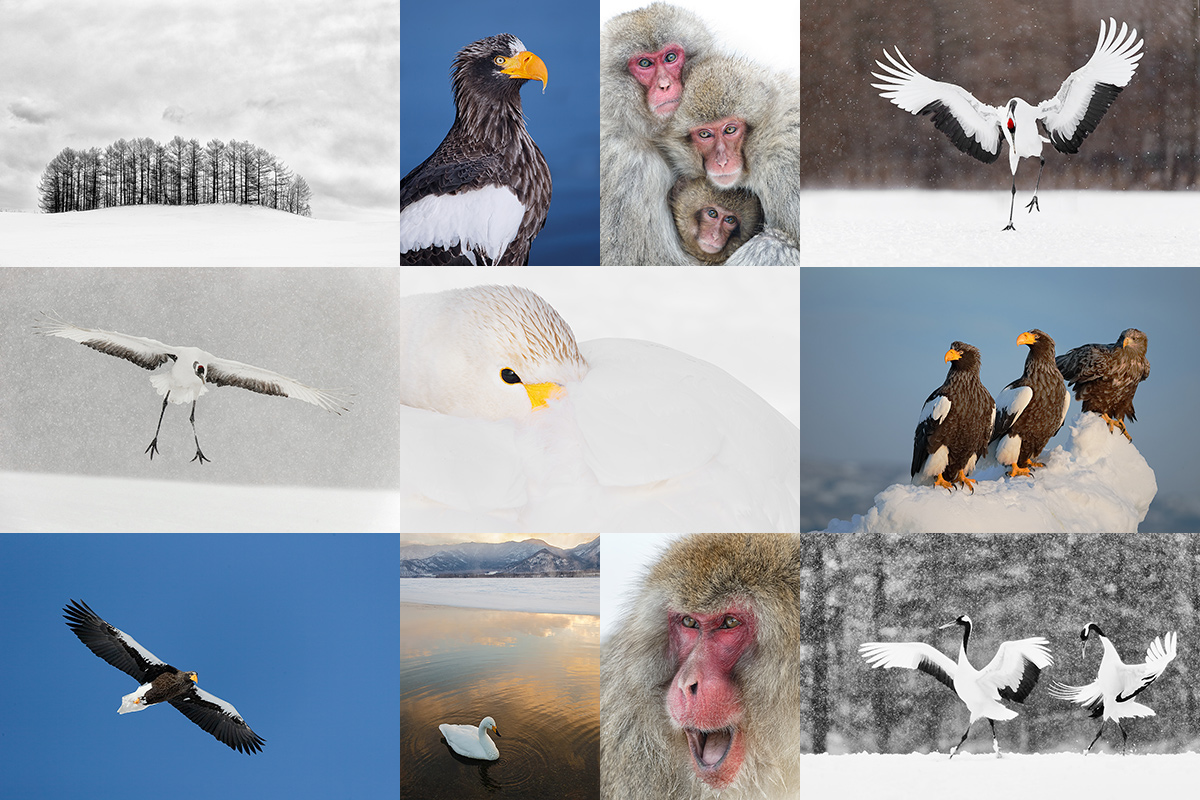
|
|
Consider joining us in Japan in February, 2016; the world’s best Japan in Winter workshop. Click on the card to enjoy a larger more spectacular version.
|
Japan In Winter IPT. February 9-24, 2016: $13,999/double occupancy. Limit 7: Openings: 5.
Needs five to run; just 3 more to go. All lodging including Tokyo hotel on 9 FEB, all breakfasts & dinners, ground transport and transfers including bus to the monkey park hotel, and all entrance fees and in-country flights are included. Not included: international flights, all lunches–most are on the run, and alcoholic beverages.
This trip is one day longer than the 2014 trip to allow for more flexibility, more time with the cranes, and most importantly, more time for landscape photography. Hokkaido is gorgeous. Three great leaders plus the world’s best Japan in winter Japanese photography guide: the amazingly creative Denise Ippolito, multiple award winning photographer Paul McKenzie and yours truly. Tons of trip planning and gear advice, in-the-field instruction and guidance, at-the-lodge Photoshop and image review sessions in addition to short introductory slide programs for each of the amazing locations.
|
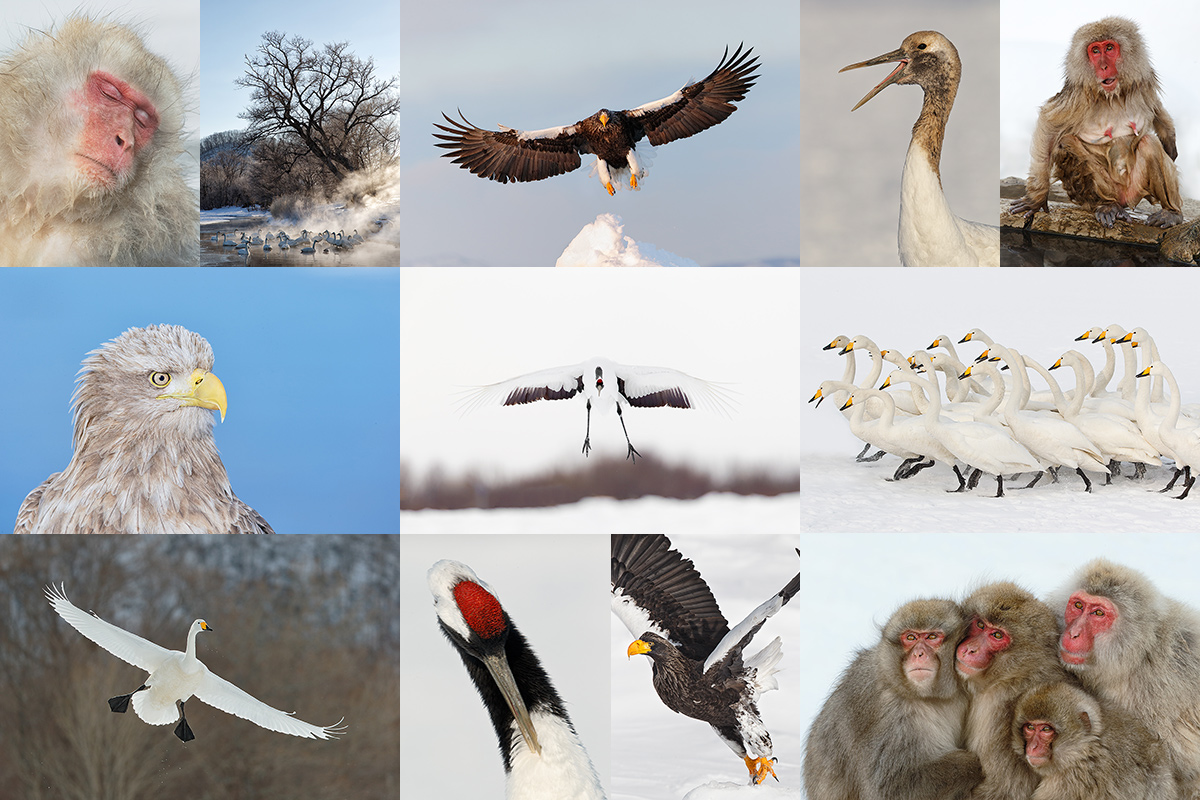
|
|
Amazing subjects. Beautiful settings. Nonstop action and unlimited opportunities. Join us. Click on the card to enjoy a larger more spectacular version.
|
The Itinerary
Arrive Tokyo: 9 FEB 2016 the latest. 8 FEB is safer and gives you a day to get acclimated to the time change. Your hotel room for the night of the 9th is covered.
Travel to Monkey Park Hotel: 10 FEB: Short 1/2 DAY of Monkey photography possible depending on our travel time….
Full Day snow monkeys: FEB 11.
Full Day snow monkeys: FEB 12.
13 FEB: Full travel day to Hokkaido/arrive at our lodge in the late afternoon. The lodge is wonderful. All the rooms at the lodge have beds. Bring your warm pajamas. Local onsen (hot springs bath and tubs) is available for $5 each day before dinner–when you are cold, it is the best thing since sliced bread. Smile emoticon The home cooked meals at the lodge are to die for.
FEB 14-23: Red-crowned Crane, raptors in flight, Whooper Swans, and scenic photography. Ural Owl possible. One 2-night trip to Rausu for Steller’s and White Tailed Sea Eagles on the tourists boats dependent on sea ice conditions. Only our trip offers complete flexibility in this area. It saved us this year. One afternoon of duck photography in the harbor is a strong possibility in Rausu. 2-3 boat trips. In addition, few if any tours offer at least one afternoon boat trip….
Lodging notes: bring your long johns for sleeping in the lodge. In Rausu and the snow monkey park, the hotel the rooms are Japanese-style. You sleep on comfortable mats on the floor. Wi-fi is available every day of the trip.
FEB 24. Fly back to Tokyo for transfer to your airport if you are flying home that night, or, to your hotel if you are overnighting. If you need that room it is on you.
To save your spot, please send your $5,000 non-refundable deposit check made out to “Arthur Morris to Arthur Morris/BIRDS AS ART, PO Box 7245, Indian Lake Estates, FL 33855. We do hope that you can join us for this trip of a lifetime. If you have any questions for would like to discuss alternate financing for this trip please shoot me an e-mail or give me a buzz at 863-692-2806.
|
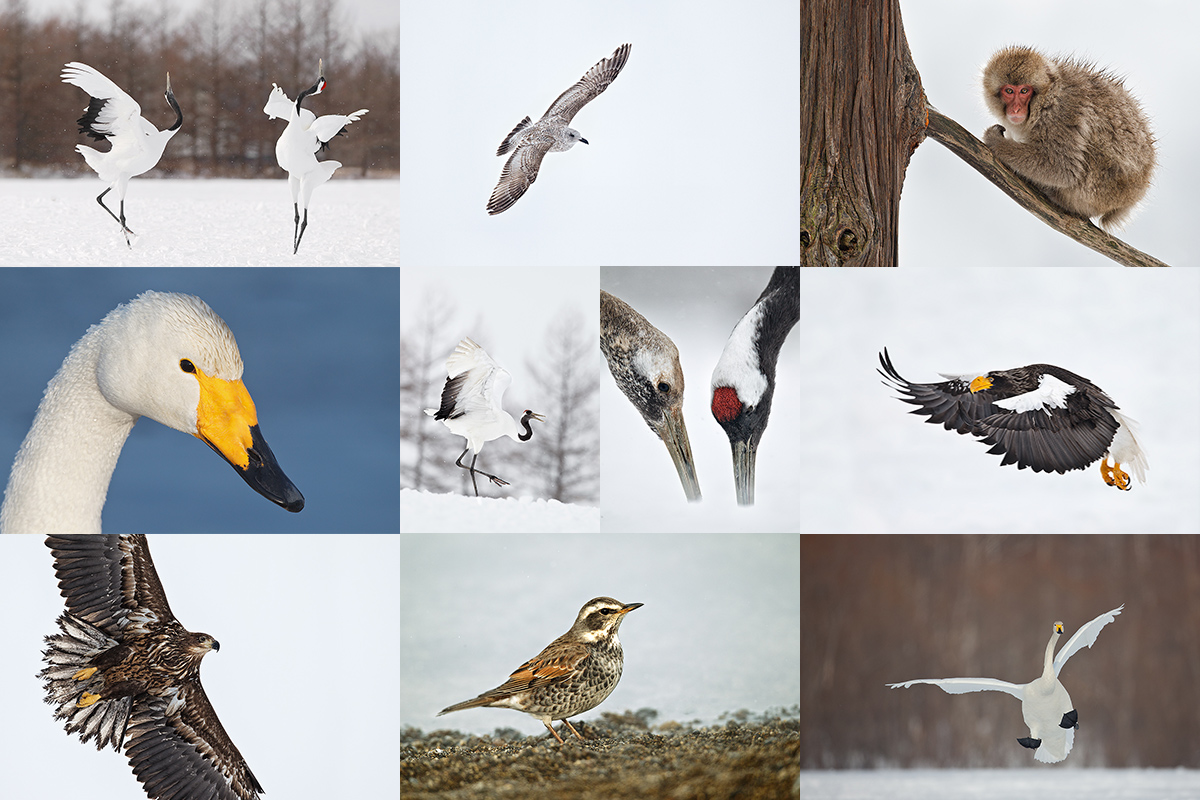
|
|
Life is short. Hop on the merry-go-round. Click on the card to enjoy a larger more spectacular version.
|
The Leader’s Favorites
Paul McKenzie’s great love is for the Whooper Swans. Like me, Denise’s favorites are the Red-crowned Cranes and the sea eagles–there are two species, the huge Steller’s and the smaller white-tailed. And all three of us love the adorable Snow Monkeys. It is not too soon for you to join this trip of a lifetime and choose your favorite. If you want to hone your flight photography skills, this is the trip for you Everything flies but the Snow Monkeys. But come to think of it we did photograph them jumping across the stream on our last trip…. And do know that images from Hokkaido have been honored in most every BBC Wildlife Photographer of the Year Competition for several decades. Three great leaders, the best lodge, the best guide, great food, superb organization, and a wealth of incredible subjects in awe-inspiring settings. What more could you ask for?
Facebook
Be sure to like and follow BAA on Facebook by clicking on the logo link upper right. Tanks a stack!
Support the BAA Blog. Support the BAA Bulletins: Shop B&H here!
We want and need to keep providing you with the latest free information, photography and Photoshop lessons, and all manner of related information. Show your appreciation by making your purchases immediately after clicking on any of our B&H or Amazon Affiliate links in this blog post. Remember, B&H ain’t just photography!
…..
Amazon.com
Those who prefer to support BAA by shopping with Amazon may use this link:
Amazon Canada
Many kind folks from north of the border, ay, have e-mailed stating that they would love to help us out by using one of our affiliate links but that living in Canada and doing so presents numerous problems. Now, they can help us out by using our Amazon Canada affiliate link by starting their searches by clicking here. Many thanks to those who have written.
Typos
In all blog posts and Bulletins, feel free to e-mail or to leave a comment regarding any typos, wrong words, misspellings, omissions, or grammatical errors. Just be right. 🙂
September 13th, 2014 The Streak Continues: 287
After spending lots of time on Friday working on the DPP 4.0 RAW Conversion eGuide,I got inspired at about 4:00pm and just about finished Saturday morning’s blog post. A rare occurrence. After a great night’s sleep of more than 8 hours, today’s offering was published at 5:45am from my home in Indian Lake Estates, FL; it took me about 2 1/2 hours to prepare and makes 287 in a row. 365 is well within reach….
As always, I would appreciate your using the BIRDS AS ART B&H affiliate links for all of your major gear, video, and electronic purchases, using our Amazon logo-link for all of your household purchases, and visiting the BAA Online Store for your tripod, tripod head, LensCoat, miscellaneous, accessories, and eGuide purchases as well. Please remember, web orders only. 🙂
You can find the following items in the Store: Gitzo tripods, Mongoose M3.6 and Wimberley heads, plates, low feet, and accessories, flash brackets, , Delkin e-film Pro Compact Flash Cards, LensCoat products, and our unique line-up of educational materials including ABP I & II, Digital Basics, Site and Set-up e-Guides, Canon and Nikon Camera Users and AF e-Guides, and MP-4 Photoshop video tutorials among others.
For the photographic stuff mentioned in the paragraph above we, meaning BAA, would of course greatly appreciate your business. Purchasing the items listed above from B&H actually hurts us :). Here is a huge thank you to the many who have been using our links on a regular basis and visiting the BAA Online store as well.
Rare Bird in NJ
A Whiskered Tern was present on and off at Bunker Pond in Cape May State Park on Friday, September 12, 2014. Click here for details.
|
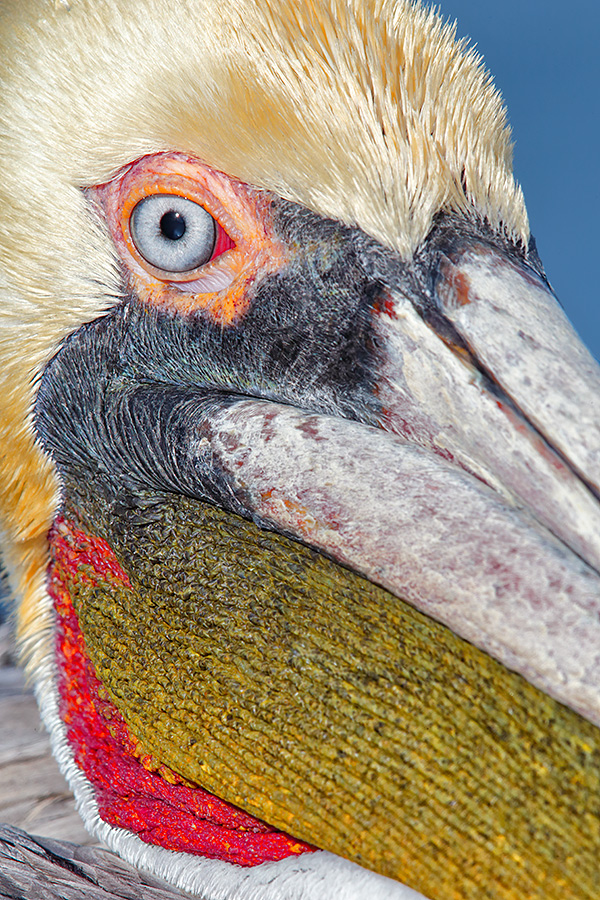
|
|
This image was created at 9:27am on January 15, 2014 at LaJolla, CA with the Gitzo 3532 LS carbon fiber tripod, the Mongoose M3.6 head, the Canon EF 600mm f/4L IS II USM lens, the Canon Extender EF 2X III, and the Canon EOS-1D X. ISO 400. Evaluative metering -1/3 stop as framed: 1/200 sec. at f/22 in Manual mode.
Central Sensor (by necessity)/AI Servo-Expand/Rear Focus AF on the gape, the spot where the upper and lower mandible meet, where the black of the lores meets the flesh color of the lower mandible, in front of an below the bird’s eye and re-compose slightly. Click here to see the latest version of the Rear Focus Tutorial. Click on the image to see a larger version.
|
Getting Close
I am a pretty big guy. Was 6 foot, 264 pounds once. Now 5 10 1/2 inches, 186, up from a low of 170 about 4 years ago but down from a recent high of 190 1/2. My balance is nowhere what it was a decade or two or three ago. Many would describe me as bull-in-a-china-shop clumsy. I am often my own worst enemy, cracking my elbow on a door frame or opening my scalp after having left the laundry-detergent, hanging cabinet door open and not realizing it as I loaded the washing machine :).
There is however one thing that requires some degree of maneuverability and stealth that I can do better than most folks: get very close to free and wild birds without disturbing them. I know how to move around birds; usually low, slow, and aware. Many folks enjoy shooting with me just to watch me in action on silly close approaches. I am sure that at times there are folks on the scene who do not know me who are wondering, “What the heck is that idiot doing trying to get so close? He’s going to scare all the birds.” Ten minutes later they are almost always amazed when I back out of the situation with the bird or birds exactly where they were when I approached. Though there is not a lot of physical skill involved, not everyone can learn to get really close. You need to learn their signs and signals that tell you “stay away,” “slow down” or “I am cool with you;” the huge advantage that I have over most folks is 37 years of closely observing birds.
Join us in San Diego and I will surely help you develop the skills that you need to get ridiculously close to fee and wild birds.
Texture City
At the “Head Throw Photography & Word Association” blog post here (and see image next), Gary Axten left a comment on September 10, 2014 at 9:46am and wrote, “The patterns of the skin folds are very interesting. Do you have a close up taken with a longer lens?”
The image above is for Gary.
Depth-of-field Question
Today’s image was created at f/22. How is it that the depth-of-field and therefore the sharpness of the bill pouch falls off so drastically as it approaches the lower right corner of the frame?
Word Association
Thanks to the few who chimed in. They had some good ones that I missed, like “pitcher plant.” You can see the comments here.
This is my list:
Patterned, corrugated, rough, abstract, diagonal, pelican, feathers, soft parts, brown, yellow, cliffs, red, La Jolla, head throw, intra-flock communication, Pacific, colorful, pointy, stretching, scoop, bill, bill pouch, bill tip, mandibles, yawn, yakking, wide open, breeding plumage, bottom, hormones, and yes, texture.
Feel free to suggest a few more here by leaving a comment.
|
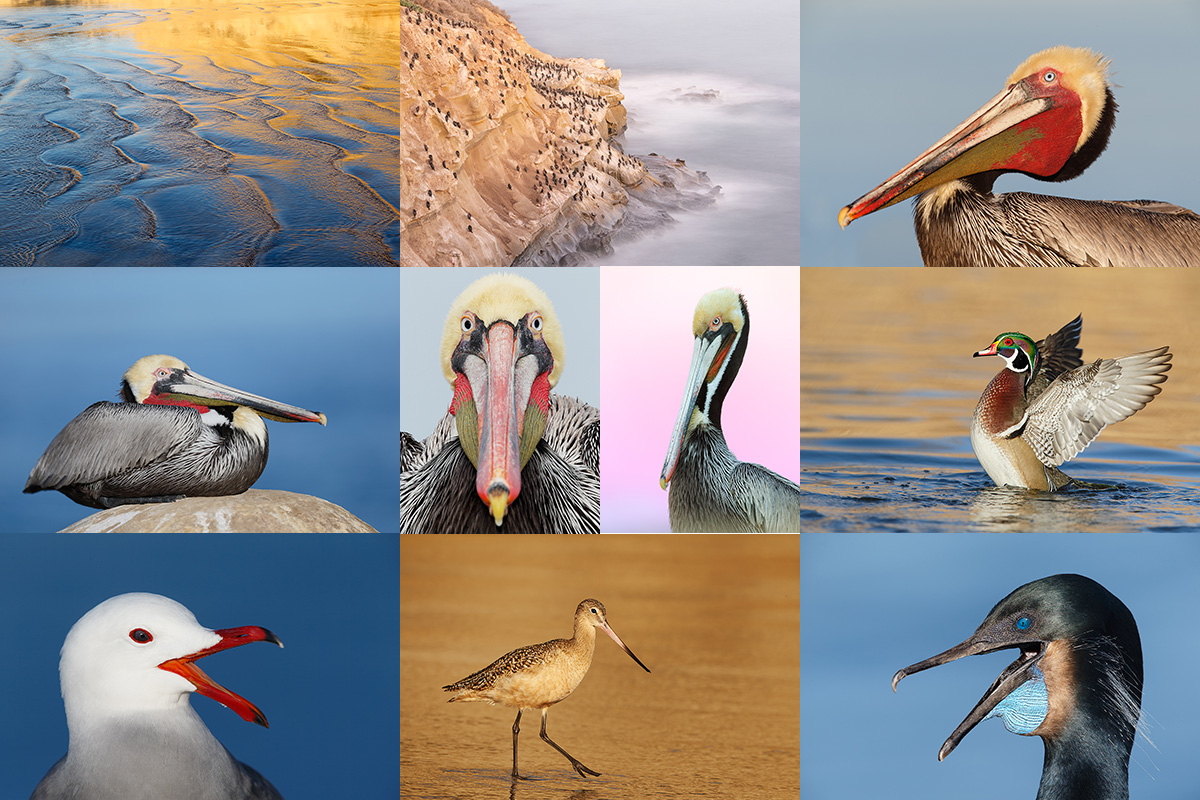
|
|
San Diego offers a wealth of very attractive natural history subjects. With annual visits spanning more than three decades I have lot of experience there….
|
2015 San Diego 4 1/2-DAY BIRDS AS ART Instructional Photo-Tour (IPT): FEB 1 thru the morning of FEB 5, 2015: $1799 (Limit: 8/Openings: 4)
Meet and Greet after dinner on your own at 7:00pm on JAN 31
Join me in San Diego to photograph the spectacular breeding plumage Brown Pelicans with their fire-engine red bill pouches; Brandt’s and Double-crested Cormorants in breeding plumage with their amazing crests; breeding plumage Wood and Ring-necked Duck; other species possible inluding Lesser Scaup, Redhead, and Surf Scoter; a variety of gulls including Western, California, and the gorgeous Heerman’s, all in full breeding plumage; shorebirds including Marbled Godwit, Willet, Sanderling and Black-bellied Plover; many others possible including Least, Western, and Spotted Sandpiper, Whimbrel, Black and Ruddy Turnstone, Semiplamated Plover, and Surfbird; Harbor Seals (depending on the current regulations) and California Sea Lions likely; and Bird of Paradise flowers. And as you can see by studying the two IPT cards there are some nice landscape opportunities as well.
Did I mention that there are wealth of great birds and natural history subjects in San Diego in winter?
This IPT will include five 3 1/2 hour morning photo sessions, four 2 1/2 hour afternoon photo sessions, five lunches, after-lunch image review and Photoshop sessions, and two fine dinners. To ensure early starts, breakfasts will be your responsibility.
A $499 non-refundable deposit is required to hold your slot for this IPT. You can send a check (made out to “Arthur Morris) to use at BIRDS AS ART, PO Box 7245, Indian Lake Estates, FL, 33855. Or call Jim or Jennifer at the office with a credit card at 863-692-0906. Your balance, payable only by check, will be due on 12/1//2014. If the trip fills, we will be glad to apply a credit applicable to a future IPT for the full amount less a $100 processing fee. If we do not receive your check for the balance on or before the due date we will try to fill your spot from the waiting list. If your spot is filled, you will lose your deposit. If not, you can secure your spot by paying your balance. Please print, complete, and sign the form that is linked to here and shoot it to us along with your deposit check. If you register by phone, please print, complete and sign the form as noted above and either mail it to us or e-mail the scan. If you have any questions, please feel free to contact me via e-mail.
|
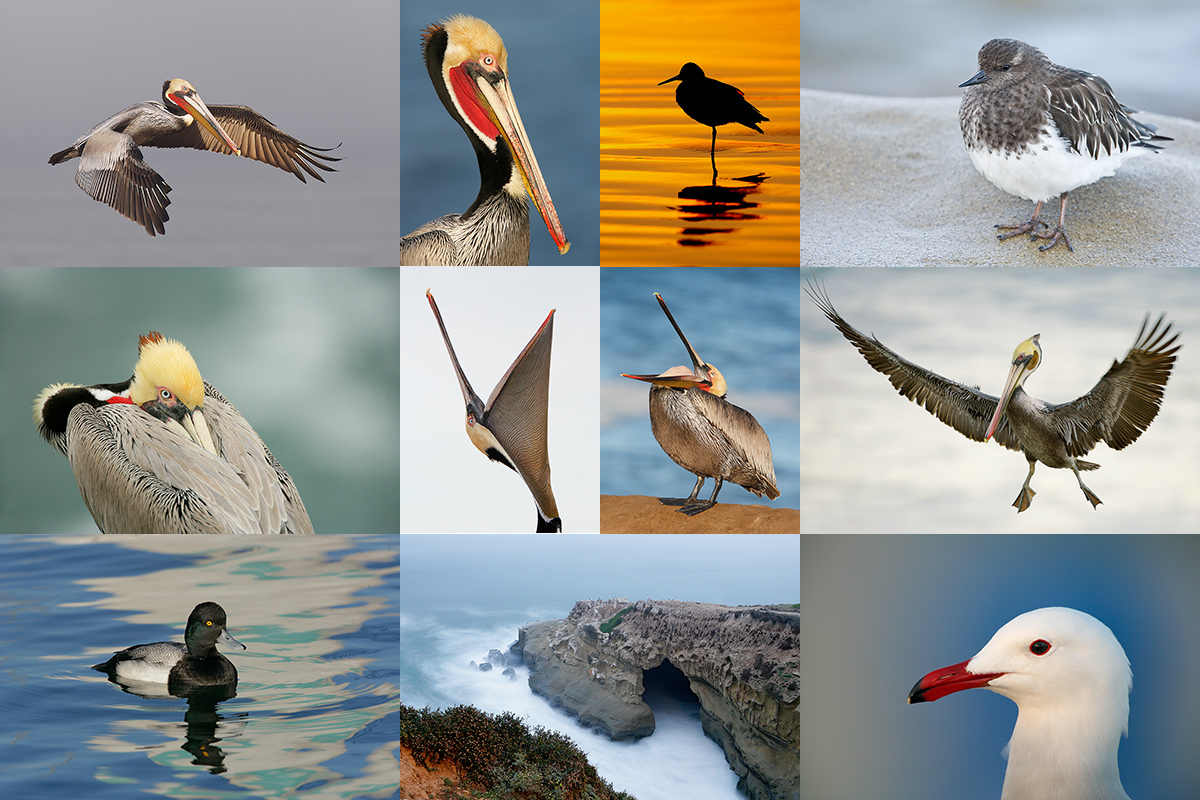
|
|
Though the pelicans will be the stars of the show on this IPT there will be many other handsome and captivating subjects in wonderful settings.
|
San Diego Natural History Museum Program & The Birds of the World Exhibit
On Saturday morning, February 7, 2015 I will be presenting “A Bird Photographer’s Story” at the San Diego Natural History Museum to kick off the Birds of the World photographic exhibit that will feature the images of about a dozen of the world’s top avian photographers. This program,which is being generously sponsored by the Canon Explorers of Light program, will be free and open to the public. I am proud to say that both Denise Ippolito and I will have images hanging in the show. The exhibit opening is scheduled for later that same day, February 7, 2015. (Times TBA).
Folks on the IPT who wish to stay over and attend the program and the exhibit opening on Saturday are invited to join me for a photo session on Friday morning as follows:
Friday Morning Add-on Photo Session: February 6, 2015: $299.
This workshop includes 3 hours of in-the-field pelican photography instruction and brunch with image review and Photoshop instruction. For now, this session is open only to folks attending the IPT.
The San Diego Site Guide
The San Diego Site Guide is, as all of our Site Guides are, the next best thing to being on an IPT. I share all the hard-earned secrets learned over three decades of birding and bird photography in and around America’s Finest City. Learn more or purchase here.
Facebook
Be sure to like and follow BAA on Facebook by clicking on the logo link upper right. Tanks a stack!
Support the BAA Blog. Support the BAA Bulletins: Shop B&H here!
We want and need to keep providing you with the latest free information, photography and Photoshop lessons, and all manner of related information. Show your appreciation by making your purchases immediately after clicking on any of our B&H or Amazon Affiliate links in this blog post. Remember, B&H ain’t just photography!
…..
Amazon.com
Those who prefer to support BAA by shopping with Amazon may use this link:
Amazon Canada
Many kind folks from north of the border, ay, have e-mailed stating that they would love to help us out by using one of our affiliate links but that living in Canada and doing so presents numerous problems. Now, they can help us out by using our Amazon Canada affiliate link by starting their searches by clicking here. Many thanks to those who have written.
Typos
In all blog posts and Bulletins, feel free to e-mail or to leave a comment regarding any typos, wrong words, misspellings, omissions, or grammatical errors. Just be right. 🙂
September 12th, 2014 The Streak Continues: 286
After falling asleep early on the couch last night I was up and working just after 4:00am this morning, just a bit earlier than average. This blog was published at about 5:45am from my home in Indian Lake Estates, FL. Yesterday I enjoyed another long swim of just under a mile and another short nap. I spent four more solid hours working on the DPP 4.0 RAW Conversion eGuide, learning a ton as I go. This post, which took me about 3 hours to prepare, makes 286 in a row. 365 is well within sight….
As always, I would appreciate your using the BIRDS AS ART B&H affiliate links for all of your major gear, video, and electronic purchases, using our Amazon logo-link for all of your household purchases, and visiting the BAA Online Store for your tripod, tripod head, LensCoat, miscellaneous, accessories, and eGuide purchases as well. Please remember, web orders only. 🙂
You can find the following items in the Store: Gitzo tripods, Mongoose M3.6 and Wimberley heads, plates, low feet, and accessories, flash brackets, , Delkin e-film Pro Compact Flash Cards, LensCoat products, and our unique line-up of educational materials including ABP I & II, Digital Basics, Site and Set-up e-Guides, Canon and Nikon Camera Users and AF e-Guides, and MP-4 Photoshop video tutorials among others.
For the photographic stuff mentioned in the paragraph above we, meaning BAA, would of course greatly appreciate your business. Purchasing the items listed above from B&H actually hurts us :). Here is a huge thank you to the many who have been using our links on a regular basis and visiting the BAA Online store as well.
Used Photography Gear Sales Updates
Mike Gotthelf’s 800mm f/5.6L IS and Walt Anderson’s EOS-1D Mark IV both sold this week. And amazingly, Brent Bridges sold his old 500 within two hours of publication of the blog. And then he sold his two Series II TCs that afternoon. Talk about effective….
Selling Your Used Photo Gear Through BIRDS AS ART
Selling your used (or like-new) photo gear through the BAA Blog or via a BAA Online Bulletin is a great idea. We charge only a 5% commission. One of the more popular used gear for sale sites charges a minimum of 20% plus assorted fees! Yikes. The minimum item price here is $500 (or less for a $25 fee). If you are interested please e-mail with the words Items for Sale Info Request cut and pasted into the Subject line :). Stuff that is priced fairly–I offer free pricing advice, usually sells in no time flat. In the past few months, we have sold just about everything in sight. Click here to see all the current listings.
Used Gear Cautions
Though I am not in a position to post images of gear for sale here or elsewhere, prospective buyers are encouraged to request for photos of the gear that they are interested in purchasing via e-mail. Doing so will help to avoid any misunderstandings as to the condition of the gear. Sellers are advised to take care to photograph their used gear with care against clean backgrounds so that the stuff is represented accurately and in the best light; please pardon the pun :).
|
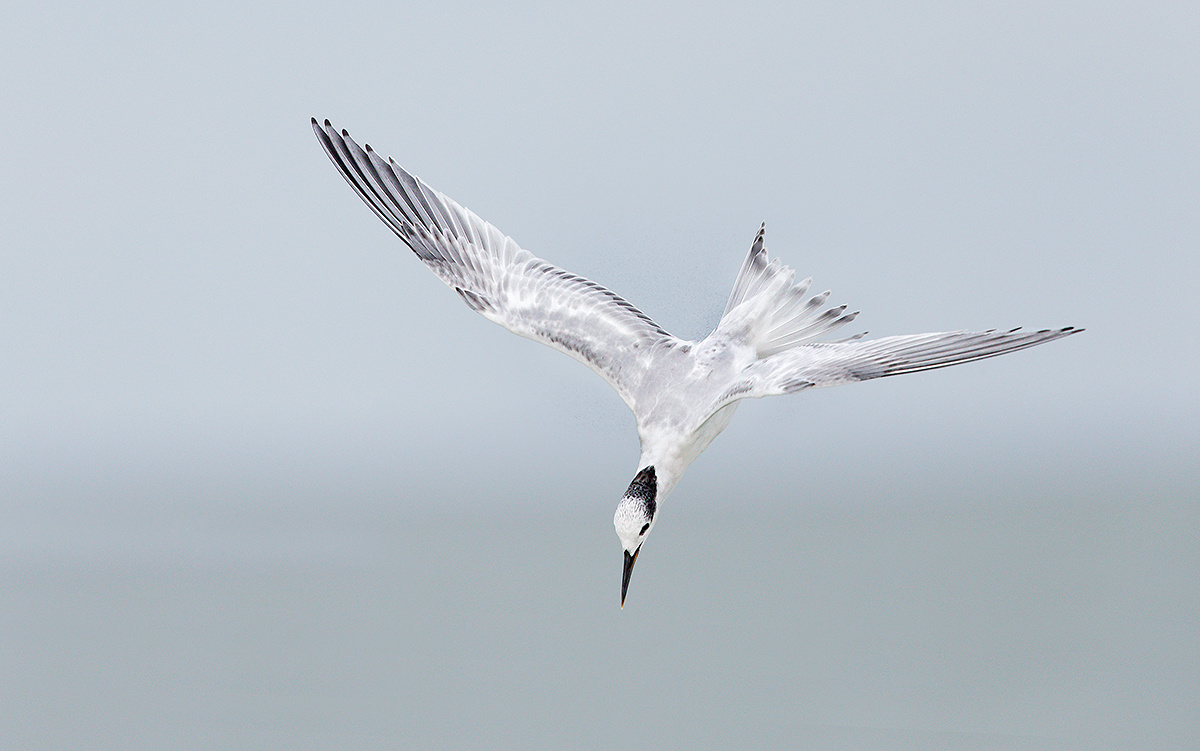
|
|
This winter plumage Sandwich Tern was photographed on September 16, 2012 at Fort DeSoto Park with the hand held Canon 500mm f/4L EF IS II lens, the Canon 1.4x EF tele-extender III, and the Canon EOS-1D X. ISO 3200. Evaluative metering +2 stops off the sky: 1/2000 sec. at f/6.3 in Manual mode.
Central Sensor Surround/AI Servo Rear Focus AF active at the moment of exposure just caught the trailing edge of the bird’s right wing as originally framed. Click here to see the latest version of the Rear Focus Tutorial. Click on the image for a larger version.
|
More Fort DeSoto in Fall
Fort DeSoto in fall can be a paradise for photographing terns in flight. Mornings are usually best as are south winds or any wind with an easterly component. You can position yourself upwind from a rooting flock and wait for other birds to land. Better yet is to find them feeding on baitfish close to shore as was the case for the image above. In addition to the Sandwich Terns (seen on both of today’s images), there are always Royal Terns and Ring-billed Gulls along with adult and first winter Laughing Gulls in the mix.
Click here for more on hand holding the 500 II at DeSoto.
|
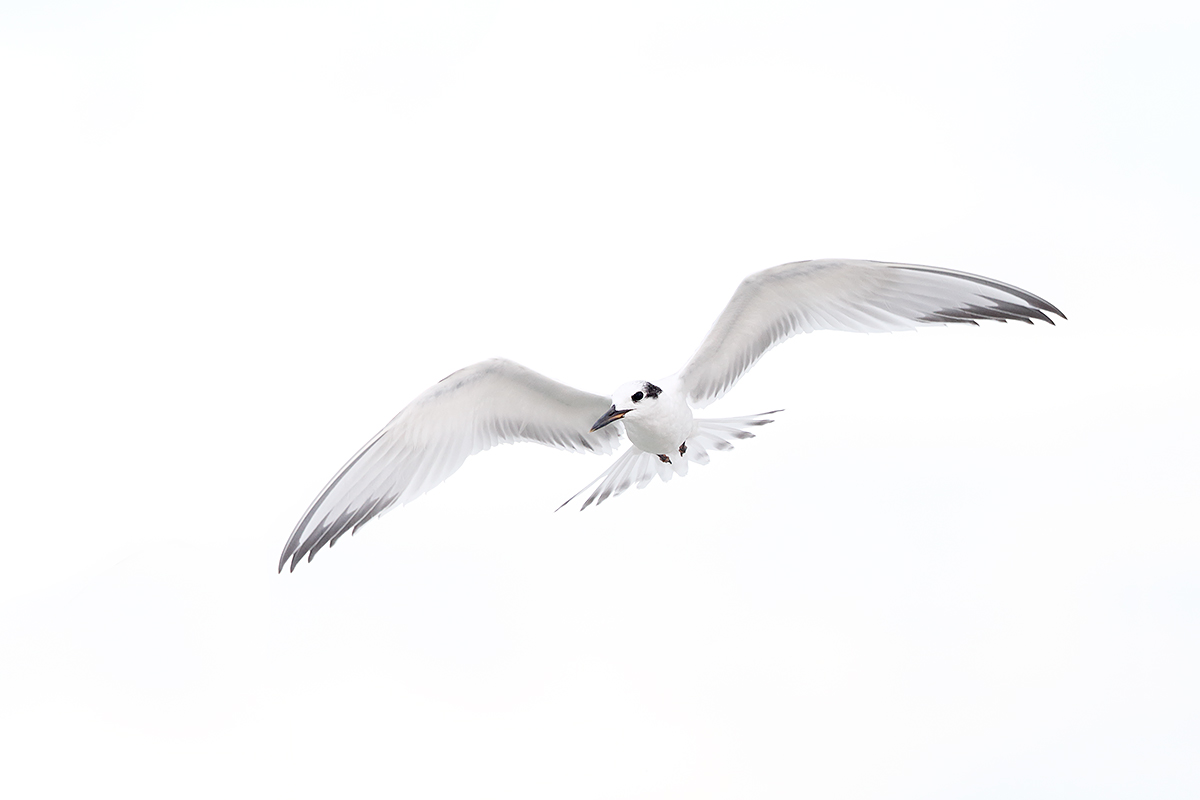
|
|
This winter plumage Sandwich Tern was also photographed on September 16, 2012 at Fort DeSoto Park with the hand held Canon 500mm f/4L EF IS II lens, the Canon 1.4x EF tele-extender III, and the Canon EOS-1D X. ISO 3200. Evaluative metering +3 stops off the sky: 1/2000 sec. at f/6.3 in Manual mode.
Central Sensor Surround/AI Servo Rear Focus AF active at the moment of exposure just caught the trailing edge of the bird’s left wing as originally framed. Click here to see the latest version of the Rear Focus Tutorial. Click on the image for a larger version.
|
Ladies, and Make Your Hotel Reservations Now or Forever Hold Your Peace
So far, two very nice ladies have signed up for the Fort DeSoto IPT. Scroll down in this blog post for details. St Augustine IPT veteran Catherine Costolo is coming down from Atlanta. And Deirdre Sheerr-Gross, who lives in New London, NH, about 1½ hours northwest of Boston, will be visiting Florida in October and joining the IPT. Deirde is a multiple IPT veteran; she has been on more than half a dozen in the very few years that she has been photographing.
Come on guys, whatcha waiting for?
Last night I made my reservations at the Beachcomber Beach Resort, 6200 Gulf Blvd, St. Petersburg (St. Pete Beach), FL 33706 (727-367-1902). The very nice Ava told me that they expect to sell out on the weekend quite soon so if you are thinking of joining us for some great bird photography and tons of learning and fun, please do not wait too long to register.
|
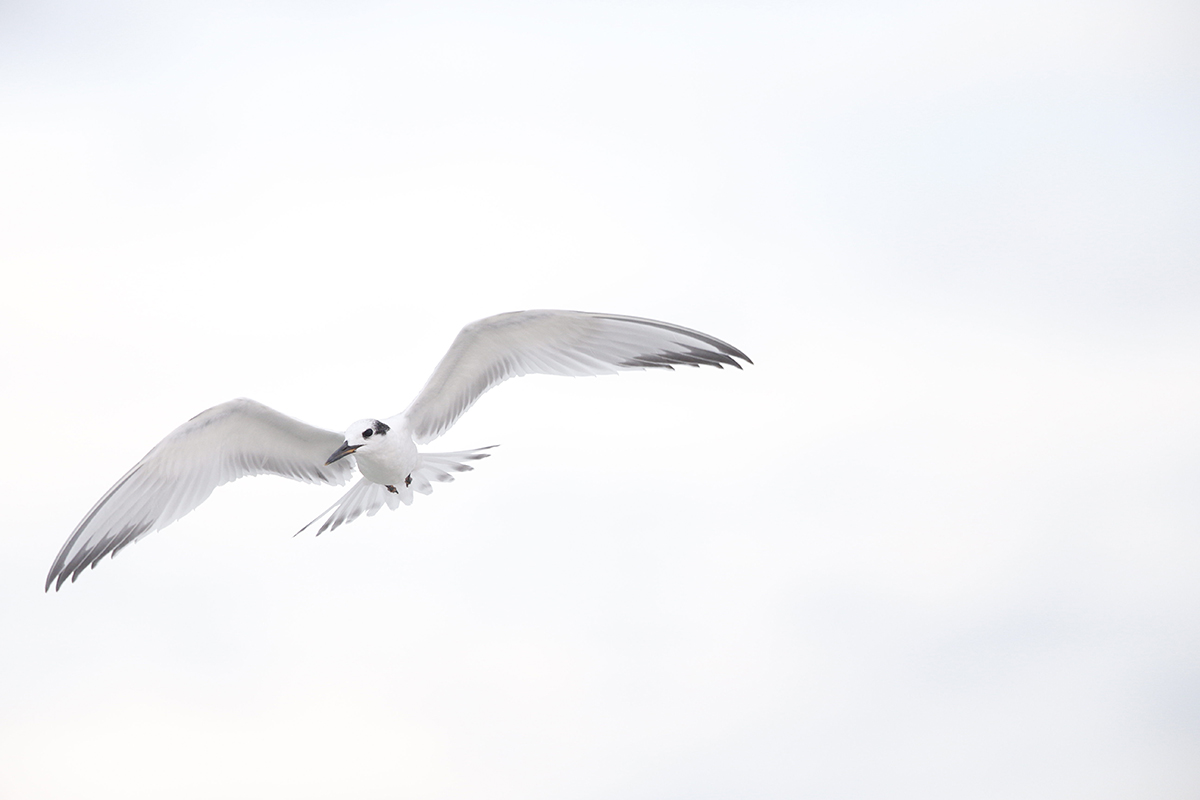
|
|
This was the original image from which the previous image was created.
|
The Image Optimization
I did the RAW conversion in DPP 4.0. As you can see by checking the before and after optimization images above, the Peripheral illumination adjustment does a great job with vignetting. And Arash’s customized settings for the 1D X for both Luminance and Chrominance Noise nailed the dark tones. Then, as always, the image was brought into Adobe Photoshop CS-6. I selected the dark tones with the Quick Selection Tool, applied a Contrast Mask (to add selective sharpening to that layer only), and then lightened the selection by pulling up the curve. Then, using techniques from APTATS I & II the bird was re-positioned in the frame, fine tuned first by adding a Regular Layer Mask and then with a single large Quick Mask, also fine-tuned with the addition of a Regular Layer Mask. After the crop to increase the subject size I saved my master TIFF file and then created my 1200 pixel wide JPEG optimized to less than 395kb for use on both the blog and on BPN.
The DPP RAW Conversion Guide
To learn why I use Canon’s Digital Photo Professional (DPP) to convert every image that I work on, click here. Coming soon: The DPP 4.0 RAW Conversion Guide by Arash Hazeghi and Arthur Morris. The more that I use DPP 4.0 for my RAW conversions the more I am impressed with it. I will be putting in several more hours of work today editing and adding to our new eGuide. Note: at present, DPP 4.0 will work only with 1D X and 5D III images.
Digital Basics
Everything that I did to optimize today’s image is covered in detail in my Digital Basics File–written in my easy-to-follow, easy-to-understand style. Are you tired of making your images look worse in Photoshop? Digital Basics File is an instructional PDF that is sent via e-mail. It includes my complete digital workflow, dozens of great Photoshop tips, details on using all of my killer image clean-up tools, the use of Contrast Masks, several different ways of expanding and filling in canvas, all of my time-saving Keyboard Shortcuts, Quick Masking, Layer Masking, and NIK Color Efex Pro basics, Digital Eye Doctor, Tim Grey Dodge and Burn, how to create time-saving actions, and tons more.
APTATS I & II
Learn the details of advanced Quick Masking techniques in APTATS I. Learn Advanced Layer Masking Techniques in APTATS I. Mention this blog post and apply a $5 discount to either with phone orders only. Buy both APTATS I and APTATS II and we will be glad to apply at $15 discount with phone orders only. Please call Jim or Jennifer at 863-692-0906 weekdays to order.
|

|
|
Fort DeSoto in fall is rich with tame birds. All of the images in this card were created at Fort DeSoto in either late September or early October. I hope that you can join me there this October. Click on the composite to enjoy a larger version.
|
First-ever BIRDS AS ART In-the-Field/Meetup Workshop Session (ITF/MWS): $50
Join me on the afternoon of October 10, 2014 for 3-hours of photographic instruction at Fort DeSoto Park. Beginners are welcome. Lenses of 300mm or longer are recommended but even those with 70-200s should get to make some nice images. Teleconverters are always a plus.
You will learn the basics of digital exposure and image design, autofocus basics, and how to get close to free and wild birds. We should get to photograph a variety of wading birds, shorebirds, terns, and gulls. This inexpensive afternoon workshop is designed to give folks a taste of the level and the quality of instruction that is provided on BIRDS AS ART Instructional Photo-tours. I hope to meet you there.
To register please call Jim or Jennifer during weekday business hours with a credit card in hand to pay the nominal registration fee. Your registration fee is non-refundable. You will receive a short e-mail with instructions, gear advice, and meeting place at least two weeks before the event.
|

|
|
Obviously folks attending the IPT will be out in the field early and stay late to take advantage of sunrise and sunset colors. The good news is that the days are relatively short in October. Click on the composite to enjoy a larger version.
|
Fort DeSoto Fall IPT/October 11-13, 2014. 3 FULL DAYs: $1099. Limit 8.
Fort DeSoto, located just south of St. Petersburg, FL, is a mecca for migrant shorebirds in fall. There they join hundreds of egrets, herons, night-herons, gulls, and terns who winter on the T-shaped peninsula that serves as their wintering grounds. With any luck, we should get to photograph two of Florida’s most desirable shorebird species: Marbled Godwit and the spectacular Long-billed Curlew. Black-bellied Plover and Willet are easy, American Oystercatcher likely. Great Egret, Snowy Egret, Great Blue Heron, and Tricolored Heron are easy as well and we will almost surely come up with a tame Yellow-crowned Night-Heron or two. We should get to do some Brown Pelican flight photography. And Royal, Sandwich, Forster’s, and Caspian Terns will likely provide us with some good flight opportunities as well. Though not guaranteed Roseate Spoonbill and Wood Stork would not be unexpected.
Folks who sign up for the IPT are welcome to join us on the ITF/MWS on Friday afternoon as my guest. See above for details on that.
On the IPT you will learn basics and fine points of digital exposure and to get the right exposure every time after making a single test exposure, how to approach free and wild birds without disturbing them, to understand and predict bird behavior, to identify many species of shorebirds, to spot the good situations, to choose the best perspective, to see and understand the light, to, and to design pleasing images by mastering your camera’s AF system. And you will learn learn how and why to work in Manual mode (even if you’re scared of it).
At lunch (included) we will review my images–folks learn a ton watching me edit–why keep this one and delete that one. If you opt to bring your laptop, we will take a look at five of your best images from the morning session. We will process a few of my images in Photoshop after converting them in DPP. That followed by Instructor Nap Time.
If you decide to register and are traveling to attend this IPT, please make your reservations at the Beachcomber Beach Resort, 6200 Gulf Blvd, St. Petersburg (St. Pete Beach), FL 33706 (727-367-1902) as soon as possible as rooms for the weekend days are scarce: ARR: 10 OCT/DEP 14 OCT. I stayed there on my last DeSoto visit and was quite happy with it. Lodging is tough in Florida at this season…. The best airport is Tampa (TPA). It is always best if IPT folks stay in the same hotel so if you are interested it would be a good idea to register now and make your hotel reservations as well. We can, however, coordinate easily with local folks who opt to stay at home either by cell phone or e-mail.
Because of the relatively late date, payment is full is due upon registration either by check or credit card. If the former, please e-mail us immediately so that we can save you a spot. If the latter, please call Jim or Jennifer during weekday business hours at 863-692-0906 with a credit card in hand to register . Your registration fee is non-refundable unless the IPT sells out with eight so please check your plans carefully before committing. You will receive a confirmation e-mail with detailed instructions, gear advice, and first morning meeting place about one month before this IPT.
|

|
|
BAA Site Guides are the next best thing to being on an IPT.
|
Fort DeSoto Site Guide
Can’t make the IPT? Get yourself a copy of the Fort DeSoto Site Guide. Learn the best spots, where to be when in what season in what weather. Learn the best wind directions for the various locations. BAA Site Guides are the next best thing to being on an IPT. You can see all of them here.
Important Bosque Festival of the Cranes Event Registration Notice
Registration for all Festival of the Cranes workshops, seminars and programs is open. Please click here and read carefully to avoid missing out on several wonderful and inexpensive educational opportunities. Please do not tarry as we expect all of the BAA/A Creative Adventure sessions to sell out quickly, especially the early morning In-the-Field Workshops. You can click http://www.festivalofthecranes.com“>here to register.
There is still lots of room in the seminar and the free program. With just a single opening the Thursday In-the-Field Workshop (ITF-W) is almost sold out. Friday and Sunday are close to a sell-out. Somewhat inexplicably Saturday has only 2 folks signed up…. The seminar and the ITF-Workshops represent a chance to learn a ton cheap.
Bosque del Apache Photography Two-Part Seminar
Bosque del Apache Photography Two-Part Seminar. Thursday, NOV 20, 2014. 2:00-4:30 pm at the refuge visitor center with Arthur Morris and Denise Ippolito: $50.00. Click here to register.
Part I: Bosque del Apache Photography Basics
Artie and Denise will cover the basics of lens selection, tripod and head selection, image design, getting the right exposure, autofocus options, and the relationship between light direction and wind direction, and will give an overview of the best photographic opportunities at the refuge. Artie and Denise have more than 26 years of experience photographing Bosque and count it high on their list of soul places.
Part II: Creative Photography at Bosque del Apache
Artie and Denise will teach you to think outside the box when photographing at the refuge (and elsewhere!). You will learn to create a variety of pleasingly blurred images by using slow shutter speeds, by photographing moving subjects, and by zooming or by panning with the lens during the exposure. They will teach you to take advantage of spectacular lighting and weather conditions. They will also cover post processing creative techniques.
Facebook
Be sure to like and follow BAA on Facebook by clicking on the logo link upper right. Tanks a stack!
Support the BAA Blog. Support the BAA Bulletins: Shop B&H here!
We want and need to keep providing you with the latest free information, photography and Photoshop lessons, and all manner of related information. Show your appreciation by making your purchases immediately after clicking on any of our B&H or Amazon Affiliate links in this blog post. Remember, B&H ain’t just photography!
…..
Amazon.com
Those who prefer to support BAA by shopping with Amazon may use this link:
Amazon Canada
Many kind folks from north of the border, ay, have e-mailed stating that they would love to help us out by using one of our affiliate links but that living in Canada and doing so presents numerous problems. Now, they can help us out by using our Amazon Canada affiliate link by starting their searches by clicking here. Many thanks to those who have written.
Typos
In all blog posts and Bulletins, feel free to e-mail or to leave a comment regarding any typos, wrong words, misspellings, omissions, or grammatical errors. Just be right. 🙂
September 11th, 2014 The Streak Continues: 285
This blog was published just before 7:00am from my home in Indian Lake Estates, FL. Yesterday I enjoyed another long, easy swim of just under a mile and another short nap. I spent another four solid hours working on the DPP 4.0 RAW Conversion eGuide, learning a ton as I go. This post, which took me about 4 hours to prepare, makes 285 in a row. 365 is well within sight….
As always, I would appreciate your using the BIRDS AS ART B&H affiliate links for all of your major gear, video, and electronic purchases, using our Amazon logo-link for all of your household purchases, and visiting the BAA Online Store for your tripod, tripod head, LensCoat, miscellaneous, accessories, and eGuide purchases as well. Please remember, web orders only. 🙂
You can find the following items in the Store: Gitzo tripods, Mongoose M3.6 and Wimberley heads, plates, low feet, and accessories, flash brackets, , Delkin e-film Pro Compact Flash Cards, LensCoat products, and our unique line-up of educational materials including ABP I & II, Digital Basics, Site and Set-up e-Guides, Canon and Nikon Camera Users and AF e-Guides, and MP-4 Photoshop video tutorials among others.
For the photographic stuff mentioned in the paragraph above we, meaning BAA, would of course greatly appreciate your business. Purchasing the items listed above from B&H actually hurts us :). Here is a huge thank you to the many who have been using our links on a regular basis and visiting the BAA Online store as well.
Great Used Photography Gear for Sale News
Mike Gotthelf’s 800mm f/5.6L IS and Walt Anderson’s EOS-1D Mark IV both sold this week. See more on selling your used photo gear through BAA below.
|
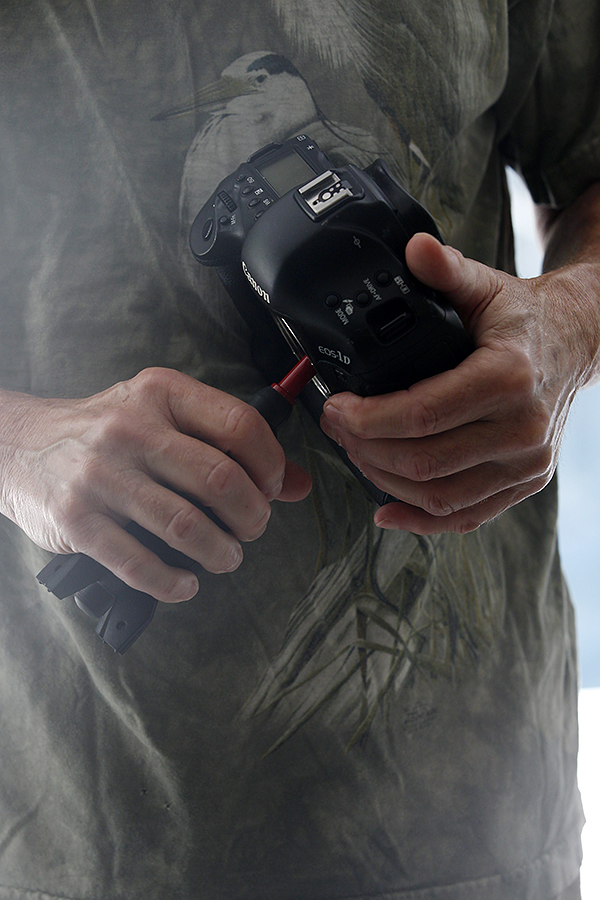
|
|
This image was created on the pool deck just outside my office door with the Gitzo 3532 LS carbon fiber tripod, the Mongoose M3.6 head, the Canon EF 70-200mm f/2.8L IS II USM lens (tripod-mounted at 90mm) and the Canon EOS-1D X. ISO 800. Evaluative metering +1/3 stop as framed: 1/125 sec. at f/5.6 in Manual mode.
Central sensor/AI Servo-Surround/Rear Focus on the top of the camera and re-compose. Click here if you missed the Rear Focus Tutorial. Click on the image to see a larger version.
Image courtesy of and copyright 2014: Jim Litzenberg.
|
Blower Brush Sensor Cleaning Tip Before Position
A powerful blower brush like the Giottos Rocket-Air Super Blower Brush that we carry (in the BAA Online Store) and that I use on a regular basis can often be used to remove loose visible dust from the sensor. You are always better off removing as much dust as possible with a blower brush than you are having to use your Lens Pen Mini Pro. Most visible dust can by eliminated with a good blower brush and good technique. Note: small blower brushes that are 4-5 inches long are not powerful enough to be effective. My Delkin Sensor Scope is an integral part of my sensor cleaning ritual; it allows me to see all but the microscopic dust on the sensors of my two 1D-X and my just-repaired 5D Mark III camera bodies.
Once you have raised the mirror, steady the camera by holding gripping it as you normally would and firmly pressing the left side of the body firmly against the lower part of your sternum (as in the image above). Note: with perfect technique the camera will be facing straight down, with the camera body pretty much parallel to the floor. Now insert the tip of the blower brush well into the mirror box being careful not to touch anything. You are now good to go.
Giottos Rocket-Air SuperBlower Brush
After last week’s onslaught of Lens Pen Mini Pro orders, the Giottos Rocket-Air SuperBlower Brush are currently out of stock. We expect a large shipment very soon. To beat the coming $2.00 price increase, order yours now here. Once we take delivery we will fill all orders and then raise the price.
|
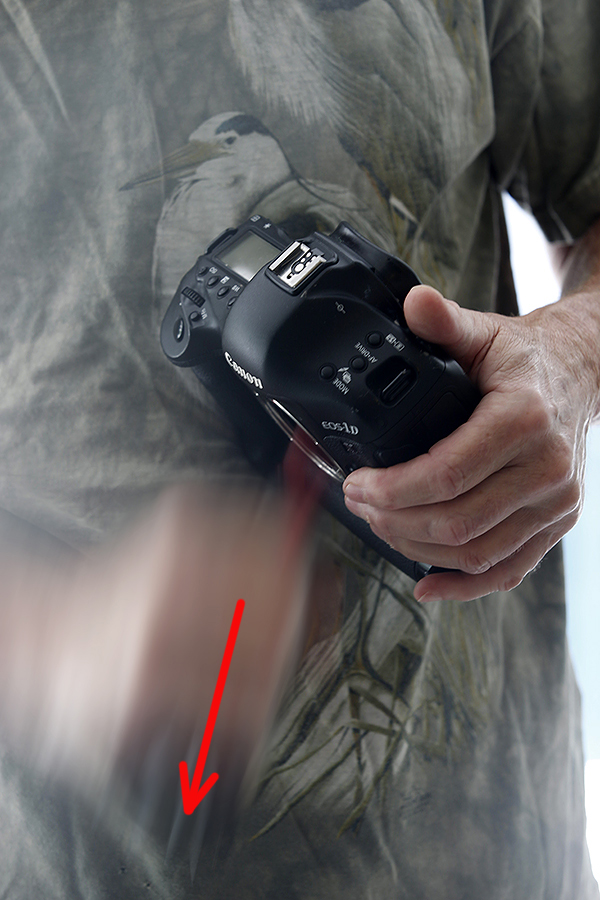
|
|
This image was also created on the pool deck just outside my office door with the Gitzo 3532 LS carbon fiber tripod, the Mongoose M3.6 head, the Canon EF 70-200mm f/2.8L IS II USM lens (tripod-mounted at 90mm) and the Canon EOS-1D X. ISO 200. Evaluative metering +1/3 stop as framed: 1/15 sec. at f/5.6 in Manual mode.
Central sensor/AI Servo-Surround/Rear Focus on the top of the camera and re-compose. Click here if you missed the Rear Focus Tutorial. Click on the image to see a larger version.
Image courtesy of and copyright 2014: Jim Litzenberg.
It took us a few tries to get the timing of the shutter release right to get the blurred effect that I was looking for. Jim did a great job. I brought the best blur into Photoshop, created a Quick Mask of my blurred hand, and accentuated the blur with a diagonal Filter > Blur > Motion Blur layer. As I learned in Denise Ippolito’s A Guide to Creative Filters and Effects.
|
The Blower Brush Sensor Cleaning Tip
Here is the tip that was taught to me by sensor cleaning expert Curt Fargo on last year’s Bosque del Apache Canon Destination Workshop (led by yours truly). Rather than simply holding the tip of the blower brush near the exposed sensor and squeezing the bulb firmly and repeatedly, perfect technique involves squeezing the bulb forcefully while violently pulling the blower brush down and away from the sensor. This action–it takes a bit of practice for some folks to get it down pat, actually sucks the dust off the sensor and out of the mirror box. That is much better option than simply blowing the dust around on the sensor…. I will usually execute this action 3-4 times before examining the sensor again with my sensor scope. Repeat as needed.
If, after several attempts, there is still a particle or two of visible dust stuck to the sensor (actually to the anti-aliasing filter that protects the sensor), then and only then do I go to my Lens Pen Mini Pro. You can learn more about the return of the Lens Pen by clicking here and scrolling down.
Please note that the purchase of a Lens Pen Mini Pro or one of our two Sensor Cleaning Bundles includes a detailed sensor cleaning tutorial that is sent via e-mail. You will learn to safely clean your camera’s sensor just as I have done thousands of times for the last decade.
First-ever BIRDS AS ART In-the-Field/Meetup Workshop Session (ITF/MWS): $50
Join me on the afternoon of October 10, 2014 for 3-hours of photographic instruction at Fort DeSoto Park. Beginners are welcome. Lenses of 300mm or longer are recommended but even those with 70-200s should get to make some nice images. Teleconverters are always a plus. Scroll down here for complete info.
Fort DeSoto Fall IPT/October 11-13, 2014. 3 FULL DAYs: $1099. Limit 8.
Tame shorebirds, herons, egrets, night-herons, terns and gulls plus tons of great instruction. Scroll down here for complete info. With one registrant, this trip is now a go. Join us.
Important Bosque Festival of the Cranes Event Registration Notice
Registration for all Festival of the Cranes workshops, seminars and programs is open. Please click here and read carefully to avoid missing out on several wonderful and inexpensive educational opportunities. Please do not tarry as we expect all of the BAA/A Creative Adventure sessions to sell out quickly, especially the early morning In-the-Field Workshops. You can click http://www.festivalofthecranes.com“>here to register.
There is still lots of room in the seminar and the free program. With just a single opening the Thursday In-the-Field Workshop (ITF-W) is almost sold out. Friday and Sunday are close to a sell-out. Somewhat inexplicably Saturday has only 2 folks signed up…. The seminar and the ITF-Workshops represent a chance to learn a ton cheap.
2015 San Diego 4 1/2-DAY BIRDS AS ART Instructional Photo-Tour (IPT): FEB 1 thru the morning of FEB 5, 2015: $1799 (Limit: 8/Openings: 4)
Meet and Greet after dinner on your own at 7:00pm on JAN 31
Just 4 slots left on this great IPT. Old friend, oft-published, and skilled hawk-in-flight photographer Ned Harris will be joining us.
Selling Your Used Photo Gear Through BIRDS AS ART
Selling your used (or like-new) photo gear through the BAA Blog or via a BAA Online Bulletin is a great idea. We charge only a 5% commission. One of the more popular used gear for sale sites charges a minimum of 20% plus assorted fees! Yikes. The minimum item price here is $500 (or less for a $25 fee). If you are interested please e-mail with the words Items for Sale Info Request cut and pasted into the Subject line :). Stuff that is priced fairly–I offer free pricing advice, usually sells in no time flat. In the past few months, we have sold just about everything in sight.
Used Gear Caution
Though I am not in a position to post images of gear for sale here or elsewhere, prospective buyers are encouraged to request for photos of the gear that they are interested in purchasing via e-mail. Doing so will help to avoid any misunderstandings as to the condition of the gear.
New Listings
Used Canon EF 500mm f/4L IS Lens
This Lens Sold in Two Hours!
BAA friend and multiple IPT veteran Brent Bridges is offering a used Canon EF 500mm f/4L IS lens in very good to excellent condition for $4900. The sale includes: the original lens trunk, the lens hood, carrying case, the front lens cover, the rear dust cap, the lens instructions, the original Canon USA Warranty Card, the original foot, a Mongoose 3.6-compatible low foot, a LensCoat, and insured shipping via UPS Ground to US addresses only. Your gear will be shipped only after your check clears.
Please contact Brent via e-mail or by phone at 1-770-565-5012.
The 500 f/4s have long been the world’s most popular super-telephotos for folks who photograph birds and wildlife. Brent recently upgraded to the Canon EF 600mm f/4L IS II USM /Canon EF 300mm f/2.8L IS II USM combo.
Used Canon EF 1.4XII and 2XII Teleconverters
BAA friend and multiple IPT veteran Brent Bridges is also offering, no, actually he is practically giving away a used Canon EF 1.4XII Teleconverter and a used 2XII Teleconverter, both in excellent condition with original box for $100 each. Nuf said. The sale includes both the front and rear dust caps and insured shipping via UPS Ground to US addresses only. Your gear will be shipped only after your check clears.
Please contact Brent via e-mail or by phone at 1-770-565-5012.
The 1.4XII TC is optically identical to the 1.4X III TC. The 2X II TC is slightly less sharp in the corners than the 2X III TC. I used both my 1.4X II and my 2X II TCs for years to produce hundreds of professionally sharp, saleable images.
Used Gitzo GT3450XLS 6X Carbon Fiber Tripod
Erik Hagstrom is offering a Gitzo GT3450XLS 6X carbon tripod (without adjustable center column as artie recommends) for $549. The tripod is in good condition, very clean with no major gouges or chips. There are as expected some normal use marks on the rubber feet. The sale includes a security plate, the fabric tripod sack, and the original box. Shipping terms: the buyer pays for shipping. Calculated at time of sale. Shipping weight is 6lbs. The tripod will ship in the original Gitzo box (6x6x29″).
Please contact Erik via e-mail or by phone at 1-206-999-1507 (9am – 5pm Pacific time).
The Gitzo GT3450XLS 6X Carbon Fiber Tripod is ideal for tall folks. It has been replaced by the virtually identical Gitzo GT3542XLS Tripod that sells new for $999.
Existing Listings
Used Canon EF 100-400 f 4.5-5.6 L IS Lens
Bruce Boswell is offering a used Canon EF 100-400 f 4.5-5.6 L IS lens in very good condition for $999 plus insured shipping via UPS Ground to US Continental addresses only. The tripod and zoom rings have a few minor blemishes. The sale includes: the original case, the front and rear caps, the lens hood, and the lens manual. Your gear will be shipped only after your check clears.
Please contact Bruce via e-mail or by phone at (309) 451-1506 or (309) 530-8493 (cell) (Central).
The 100-400 is a versatile intermediate telephoto zoom lens with 1,000+ uses. It makes a great starter lens especially for folks who do general nature and wildlife in addition to birds. I’ve sold 100s of images made with a 1-4 and denise loved hers for many years forsaking it only recently for the Canon EF 70-200mm f/2.8L IS II USM lens. Bruce’s 100-400 is priced to sell.
Used Canon 300mm f/4L IS USM Lens
Chris Callahan is offering a used Canon 300mm f/4L IS USM Lens in good to very good condition for $900. There is some wear on the finish. The sale includes the heavy duty fabric carrying case that is moderately worn, the tripod ring (tripod collar), and the rear cap. The seller will pay insured UPS shipping within continental US. The lens will ship after the check clears.
Please contact Chris via e-mail or by phone at 1-850-516-7155 (eastern time).
The Canon EF 300mm f/4L IS USM lens is still in production; it sells for $1449 new from B&H; buy Chris’s lens today and save $549! I have long recommended this lens as the best Canon bird photography starter lens, a clear choice over my old “toy lens,” the Canon EF 400mm f/5.6L. Why? It is faster at f/4. It has IS. And it autofocuses with a 7D (or other pro-sumer body) and a 1.4X teleconverter. The 300 f/4 L IS offers a minimum focusing distance of only 1.5 meters (less than 5 feet). This makes it a great lens for for frogs, butterflies, medium-sized and large flowers, and large insects like dragonflies. It is a great flight lens either alone or with the 1.4X TC. It is deadly sharp and great on a tripod with the Mongoose M3.6.
Used Canon EOS-1D Mark III
Michael Zajac is offering a Canon EOS-1D Mark III professional digital camera body in Excellent condition for $1250. The sale includes the battery charger, one battery, the original paperwork, the camera strap, the original box, and shipping to the continental US.
Please contact Michael via e-mail or by phone at 732-979 -6644. Photos are available upon request.
Some EOS-1D Mark III bodies originally had AF problems. Michael’s did not. I have seen his great flight images made with this camera. This body features a 1.3X crop factor sensor and is a great step-up for someone who wants to take a big step up from a 7D. It’s powerful battery drives AF much faster than the pro-sumer bodies especially with either a 1.4X or 2X teleconverter in place.
Facebook
Be sure to like and follow BAA on Facebook by clicking on the logo link upper right. And please do send a Friend Request. Tanks a stack!
Support the BAA Blog. Support the BAA Bulletins: Shop B&H here!
We want and need to keep providing you with the latest free information, photography and Photoshop lessons, and all manner of related information. Show your appreciation by making your purchases immediately after clicking on any of our B&H or Amazon Affiliate links in this blog post. Remember, B&H ain’t just photography!
…..
Amazon Canada
Many kind folks from north of the border, ay, have e-mailed stating that they would love to help us out by using one of our affiliate links but that living in Canada and doing so presents numerous problems. Now, they can help us out by using our Amazon Canada affiliate link by starting their searches by clicking here. Many thanks to those who have written.
Typos
In all blog posts and Bulletins, feel free to e-mail or to leave a comment regarding any typos, wrong words, misspellings, omissions, or grammatical errors. Just be right. 🙂
September 10th, 2014 The Streak Continues: 284
This blog was published at about 5:15am from my home in Indian Lake Estates, FL. Yesterday I enjoyed another long, easy swim of just under a mile and a short nap. I spent four solid hours working on the DPP 4.0 RAW Conversion eGuide. This post, which took me about 2 1/2 hours to prepare, makes 284 in a row. 365 is well within sight….
As always, I would appreciate your using the BIRDS AS ART B&H affiliate links for all of your major gear, video, and electronic purchases, using our Amazon logo-link for all of your household purchases, and visiting the BAA Online Store for your tripod, tripod head, LensCoat, miscellaneous, accessories, and eGuide purchases as well. Please remember, web orders only. 🙂


First-ever BIRDS AS ART In-the-Field/Meetup Workshop Session (ITF/MWS): $50
Join me on the afternoon of October 10, 2014 for 3-hours of photographic instruction at Fort DeSoto Park. Beginners are welcome. Lenses of 300mm or longer are recommended but even those with 70-200s should get to make some nice images. Teleconverters are always a plus. Scroll down here for complete info.
Fort DeSoto Fall IPT/October 11-13, 2014. 3 FULL DAYs: $1099. Limit 8.
Tame shorebirds, herons, egrets, night-herons, terns and gulls plus tons of great instruction. Scroll down here for complete info.
Important Bosque Festival of the Cranes Event Registration Notice
Registration for all Festival of the Cranes workshops, seminars and programs is open. Please click here and read carefully to avoid missing out on several wonderful and inexpensive educational opportunities. Please do not tarry as we expect all of the BAA/A Creative Adventure sessions to sell out quickly, especially the early morning In-the-Field Workshops. You can click http://www.festivalofthecranes.com to register.
Head Throw Photography
Head throws, usually part of the bill cleaning ritual of Pacific Brown Pelican are thought to be a form of intra-flock communication: one pelican talking to another. It is exceedingly rare to see a Brown Pelican of the Atlantic race do a head throw. On the other hand, the Pacific birds do them quite often. Head throw photography can be quite exciting and quite rewarding; one of my earliest BBC Wildlife Photographer of the Year Competition-honored images (I have eight in all), was a full frame vertical of Pacific Brown Pelican at the height of a head throw. You can see that image, cropped a bit too tightly by the original designer, on page 86 as a chapter opener and on the back cover of the original The Art of Bird Photography.
Head throw photography is a huge challenge. You might have as many as 20-30 or more pelicans sitting right in front of you at relatively close range; which one will be the next to execute a head throw? Are there any clues to which bird will be the next to show off? How do you position yourself to try to isolate your subject and come up with a clean background? What is the best lens? Should you use a fixed focal length lens or a zoom lens? Should you be in horizontal or vertical format? Should you include the whole bird in the frame, go for a head and shoulder vertical, or try for a tight bill portrait shot as in today’s featured image? Should you be on a tripod or hand holding? What sort of shutter speed should I be using? Is one time of day better than another for head portrait photography? Should you specifically try to create head throw images or do you have a chance to get a great one in the course of a given morning of general pelican photography?
Please note the answers to some of these questions can be ascertained by carefully reading the image caption above…. A good part of each morning on a San Diego IPT is spent considering all of the above questions…. And answering them. And lots more. If you would like to join us please scroll down for info on this great workshop.
Head Throw Word Association
Click on the image to enlarge it. What words and phrases come to mind? Please take a moment to leave a comment with your list. Right now I have more than 20 on my list. I will share my list with you here on Friday morning.
|

|
|
San Diego offers a wealth of very attractive natural history subjects. With annual visits spanning more than three decades I have lot of experience there….
|
2015 San Diego 4 1/2-DAY BIRDS AS ART Instructional Photo-Tour (IPT): FEB 1 thru the morning of FEB 5, 2015: $1799 (Limit: 8/Openings: 5)
Meet and Greet after dinner on your own at 7:00pm on JAN 31
Join me in San Diego to photograph the spectacular breeding plumage Brown Pelicans with their fire-engine red bill pouches; Brandt’s and Double-crested Cormorants in breeding plumage with their amazing crests; breeding plumage Wood and Ring-necked Duck; other species possible inluding Lesser Scaup, Redhead, and Surf Scoter; a variety of gulls including Western, California, and the gorgeous Heerman’s, all in full breeding plumage; shorebirds including Marbled Godwit, Willet, Sanderling and Black-bellied Plover; many others possible including Least, Western, and Spotted Sandpiper, Whimbrel, Black and Ruddy Turnstone, Semiplamated Plover, and Surfbird; Harbor Seals (depending on the current regulations) and California Sea Lions likely; and Bird of Paradise flowers. And as you can see by studying the two IPT cards there are some nice landscape opportunities as well.
Did I mention that there are wealth of great birds and natural history subjects in San Diego in winter?
This IPT will include five 3 1/2 hour morning photo sessions, four 2 1/2 hour afternoon photo sessions, five lunches, after-lunch image review and Photoshop sessions, and two fine dinners. To ensure early starts, breakfasts will be your responsibility.
A $499 non-refundable deposit is required to hold your slot for this IPT. You can send a check (made out to “Arthur Morris) to use at BIRDS AS ART, PO Box 7245, Indian Lake Estates, FL, 33855. Or call Jim or Jennifer at the office with a credit card at 863-692-0906. Your balance, payable only by check, will be due on 12/1//2014. If the trip fills, we will be glad to apply a credit applicable to a future IPT for the full amount less a $100 processing fee. If we do not receive your check for the balance on or before the due date we will try to fill your spot from the waiting list. If your spot is filled, you will lose your deposit. If not, you can secure your spot by paying your balance. Please print, complete, and sign the form that is linked to here and shoot it to us along with your deposit check. If you register by phone, please print, complete and sign the form as noted above and either mail it to us or e-mail the scan. If you have any questions, please feel free to contact me via e-mail.
|

|
|
Though the pelicans will be the stars of the show on this IPT there will be many other handsome and captivating subjects in wonderful settings.
|
San Diego Natural History Museum Program & The Birds of the World Exhibit
On Saturday morning, February 7, 2015 I will be presenting “A Bird Photographer’s Story” at the San Diego Natural History Museum to kick off the Birds of the World photographic exhibit that will feature the images of about a dozen of the world’s top avian photographers. This program,which is being generously sponsored by the Canon Explorers of Light program, will be free and open to the public. I am proud to say that both Denise Ippolito and I will have images hanging in the show. The exhibit opening is scheduled for later that same day, February 7, 2015. (Times TBA).
Folks on the IPT who wish to stay over and attend the program and the exhibit opening on Saturday are invited to join me for a photo session on Friday morning as follows:
Friday Morning Add-on Photo Session: February 6, 2015: $299.
This workshop includes 3 hours of in-the-field pelican photography instruction and brunch with image review and Photoshop instruction. For now, this session is open only to folks attending the IPT.
Facebook
Be sure to like and follow BAA on Facebook by clicking on the logo link upper right. Tanks a stack!
Support the BAA Blog. Support the BAA Bulletins: Shop B&H here!
We want and need to keep providing you with the latest free information, photography and Photoshop lessons, and all manner of related information. Show your appreciation by making your purchases immediately after clicking on any of our B&H or Amazon Affiliate links in this blog post. Remember, B&H ain’t just photography!
…..
Amazon.com
Those who prefer to support BAA by shopping with Amazon may use this link:
Amazon Canada
Many kind folks from north of the border, ay, have e-mailed stating that they would love to help us out by using one of our affiliate links but that living in Canada and doing so presents numerous problems. Now, they can help us out by using our Amazon Canada affiliate link by starting their searches by clicking here. Many thanks to those who have written.
Typos
In all blog posts and Bulletins, feel free to e-mail or to leave a comment regarding any typos, wrong words, misspellings, omissions, or grammatical errors. Just be right. 🙂
September 9th, 2014 The Streak Continues: 283
This blog was published just after 7:15am from my home in Indian Lake Estates, FL. Yesterday I enjoyed another long, easy swim of just under a mile and another too-long nap. This post, which took me about 2 1/2 hours to prepare, makes 283 in a row. 365 is well within sight….
As always, I would appreciate your using the BIRDS AS ART B&H affiliate links for all of your major gear, video, and electronic purchases, using our Amazon logo-link for all of your household purchases, and visiting the BAA Online Store for your tripod, tripod head, LensCoat, miscellaneous, accessories, and eGuide purchases as well. Please remember, web orders only. 🙂


2015 San Diego 4 1/2-DAY BIRDS AS ART Instructional Photo-Tour (IPT): FEB 1 thru the morning of FEB 5, 2015: $1799 (Limit: 8/Openings: 5)
Meet and Greet after dinner on your own at 7:00pm on JAN 31
Just 5 slots left on this great IPT. Click here and scroll down for complete details.
Important Bosque Festival of the Cranes Event Registration Notice
Registration for all Festival of the Cranes workshops, seminars and programs is open. Please click here and read carefully to avoid missing out on several wonderful and inexpensive educational opportunities. Please do not tarry as we expect all of the BAA/A Creative Adventure sessions to sell out quickly, especially the early morning In-the-Field Workshops. You can click http://www.festivalofthecranes.com to register.
|

|
|
Fort DeSoto in fall is rich with tame birds. All of the images in this card were created at Fort DeSoto in either late September or early October. I hope that you can join me there this October. Click on the composite to enjoy a larger version.
|
First-ever BIRDS AS ART In-the-Field/Meetup Workshop Session (ITF/MWS): $50
Join me on the afternoon of October 10, 2014 for 3-hours of photographic instruction at Fort DeSoto Park. Beginners are welcome. Lenses of 300mm or longer are recommended but even those with 70-200s should get to make some nice images. Teleconverters are always a plus.
You will learn the basics of digital exposure and image design, autofocus basics, and how to get close to free and wild birds. We should get to photograph a variety of wading birds, shorebirds, terns, and gulls. This inexpensive afternoon workshop is designed to give folks a taste of the level and the quality of instruction that is provided on BIRDS AS ART Instructional Photo-tours. I hope to meet you there.
To register please call Jim or Jennifer during weekday business hours with a credit card in hand to pay the nominal registration fee. Your registration fee is non-refundable. You will receive a short e-mail with instructions, gear advice, and meeting place at least two weeks before the event.
|

|
|
Obviously folks attending the IPT will be out in the field early and stay late to take advantage of sunrise and sunset colors. The good news is that the days are relatively short in October. Click on the composite to enjoy a larger version.
|
Fort DeSoto Fall IPT/October 11-13, 2014. 3 FULL DAYs: $1099. Limit 8.
Fort DeSoto, located just south of St. Petersburg, FL, is a mecca for migrant shorebirds in fall. There they join hundreds of egrets, herons, night-herons, gulls, and terns who winter on the T-shaped peninsula that serves as their wintering grounds. With any luck, we should get to photograph two of Florida’s most desirable shorebird species: Marbled Godwit and the spectacular Long-billed Curlew. Black-bellied Plover and Willet are easy, American Oystercatcher likely. Great Egret, Snowy Egret, Great Blue Heron, and Tricolored Heron are easy as well and we will almost surely come up with a tame Yellow-crowned Night-Heron or two. We should get to do some Brown Pelican flight photography. And Royal, Sandwich, Forster’s, and Caspian Terns will likely provide us with some good flight opportunities as well. Though not guaranteed Roseate Spoonbill and Wood Stork would not be unexpected.
Folks who sign up for the IPT are welcome to join us on the ITF/MWS on Friday afternoon as my guest. See above for details on that.
On the IPT you will learn basics and fine points of digital exposure and to get the right exposure every time after making a single test exposure, how to approach free and wild birds without disturbing them, to understand and predict bird behavior, to identify many species of shorebirds, to spot the good situations, to choose the best perspective, to see and understand the light, to, and to design pleasing images by mastering your camera’s AF system. And you will learn learn how and why to work in Manual mode (even if you’re scared of it).
At lunch (included) we will review my images–folks learn a ton watching me edit–why keep this one and delete that one. If you opt to bring your laptop, we will take a look at five of your best images from the morning session. We will process a few of my images in Photoshop after converting them in DPP. That followed by Instructor Nap Time.
As soon as I have a single sign-up for the IPT–as always I will go with one–I will make my reservations at the Beachcomber Beach Resort, 6200 Gulf Blvd, St. Petersburg (St. Pete Beach), FL 33706 (727-367-1902). I stayed at the Beachcomber Beach Resort on my last DeSoto visit and was quite happy with it. Lodging is tough in Florida at this season…. The best airport is Tampa (TPA). It is always best if IPT folks stay in the same hotel so if you are interested it would be a good idea to register now and make your hotel reservations as well. We can easily coordinate with local folks who opt to stay at home.
Because of the relatively late date, payment is full is due upon registration either by check or credit card. If the former, please e-mail us immediately so that we can save you a spot. If the latter, please call Jim or Jennifer during weekday business hours at 863-692-0906 with a credit card in hand to register . Your registration fee is non-refundable unless the IPT sells out with eight so please check your plans carefully before committing. You will receive a confirmation e-mail with detailed instructions, gear advice, and first morning meeting place about one month before this IPT.
|

|
|
BAA Site Guides are the next best thing to being on an IPT.
|
Fort DeSoto Site Guide
Can’t make the IPT? Get yourself a copy of the Fort DeSoto Site Guide. Learn the best spots, where to be when in what season in what weather. Learn the best wind directions for the various locations. BAA Site Guides are the next best thing to being on an IPT. You can see all of them here.
Facebook
Be sure to like and follow BAA on Facebook by clicking on the logo link upper right. Tanks a stack!
Support the BAA Blog. Support the BAA Bulletins: Shop B&H here!
We want and need to keep providing you with the latest free information, photography and Photoshop lessons, and all manner of related information. Show your appreciation by making your purchases immediately after clicking on any of our B&H or Amazon Affiliate links in this blog post. Remember, B&H ain’t just photography!
…..
Amazon.com
Those who prefer to support BAA by shopping with Amazon may use this link:
Amazon Canada
Many kind folks from north of the border, ay, have e-mailed stating that they would love to help us out by using one of our affiliate links but that living in Canada and doing so presents numerous problems. Now, they can help us out by using our Amazon Canada affiliate link by starting their searches by clicking here. Many thanks to those who have written.
Typos
In all blog posts and Bulletins, feel free to e-mail or to leave a comment regarding any typos, wrong words, misspellings, omissions, or grammatical errors. Just be right. 🙂
September 8th, 2014 The Streak Continues: 282
This blog was published just after 6:45am from my home in Indian Lake Estates, FL. Yesterday I enjoyed a long, easy swim of just under a mile and a too-long nap. Plus lots of golf, tennis, and the NFL on the big flat screen TV. I was in bed early at 9:00pm, up at 3:00am, and at my desk hard at work by 3:30am. This post, which took me about 3 1/2 hours to prepare, makes 282 in a row. 365 is well within sight….
As always, I would appreciate your using the BIRDS AS ART B&H affiliate links for all of your major gear, video, and electronic purchases, using our Amazon logo-link for all of your household purchases, and visiting the BAA Online Store for your tripod, tripod head, LensCoat, miscellaneous, accessories, and eGuide purchases as well. Please remember, web orders only. 🙂
Ask and Ye Shall Receive
In the “Despicable Tales, 1D X Frame Rate, & Matters of Opinion” blog post here, I wrote under the heading of Blog Interactivity: While it is great that an average of more than 2,000 folks visit and learn from the blog each day it would be wonderful if more than a handful of folks tackled the questions that are designed to make the blog more interactive and less static. And I could have added, “more interesting for all as well.”
With 14 comments, folks really rose to the occasion. Such participation is greatly appreciated.
Lens Pen News
The Lens Pen sale will continue for one more day. The price increase will go into effect on Tuesday morning at 9am. We were overwhelmed by orders yesterday. You can read the whole story by scrolling down here. Or order one or more Lens Pen Mini Pros here for just $9.99 each plus shipping. As always, and ridiculous excess shipping charges will of course be refunded.
Click here to learn about all of our sensor cleaning supplies.
Coming Tomorrow (for sure!)
In tomorrow’s blog post I will share a great new Giottos Rocket-Air Super AIR Blower sensor cleaning tip.
|

|
|
This image was created with the Canon 24-105mm f/4L IS EF USM AF lens hand held at 28mm with the Canon EOS 5D Mark III Digital camera body. ISO 400: 1/1600 sec. at f/13 in Manual mode.
Central sensor Surround/AI Servo/Rear Focus AF and recompose. Click here if you missed the Rear Focus Tutorial. Click on the image to see a larger, sharper version.
Image #1: A Happy Photographer… Detaille Island, Antarctica, south of the antarctic circle. Image courtesy of Clemens Van der Werf.
|
Thanks Clemens!
Clemens Van der Werf is unquestionably one of my two most talented students with only Todd Gustafson giving him a run for the money. Thanks to Clemens for letting me use six of his Southern Ocean images in this blog post. Clemens has been on several Southern Ocean expeditions, several with me and most with Cheesemans’ Ecology Safaris.
Please note: all of the images here were created by Clemens Van der Werf. Comments praising me for my great images will be deleted as a matter of course and without comment.
|

|
|
This image was created with the Canon EF 24-70mm f/2.8L II USM lens (hand held at 24mm) and the Canon EOS 5D Mark III. ISO 400: 1/80 sec. at f/8 in Manual mode.
Central sensor/AI Servo/Surround Rear Focus AF on the nearest penguin and re-compose. Click here to see the latest version of the Rear Focus Tutorial. Click on the image to see a larger version.
Image #2: Gentoo Penguins & full moon with a pink/purple/blue sky. Petermann Island, Antarctica , looking towards the south entrance of the Lemaire Channel. Image courtesy of and copyright 2013 Clemens Van der Werf.
|
Compositional Skills
Note Clemens’ superb compositional skills in each of the images presented here. Interestingly enough, when Clemens came on his first IPT he had no interest in bird photography. He just wanted to learn photography. Canon Explorer of Light Onne van der Wal recommended that Clemens study with me. He has done that in spades. He has attended well more than a dozen IPTs, Photo Cruises and Expeditions, and Bear Boat trips in all.
|

|
|
This image was created with the Canon EF 500mm f/4L IS II USM lens, a Canon Extender EF 1.4X III, and the Canon EOS 5D Mark III. ISO 400: 1/80 sec. at f/8 in Manual mode.
One sensor to the left of the central sensor/AI Servo/Surround Rear Focus AF on the neck of the nearest penguin was active at the moment of exposure. Click here to see the latest version of the Rear Focus Tutorial. Click on the image to see a larger version.
Image #3: Gentoo Penguin March. 3rd image: Yankee Harbor, South Shetlands Islands, Antarctica. Image courtesy of and copyright 2013 Clemens Van der Werf.
|
AF Tip
In soft light/low contrast situations like the one above it is important to choose an AF point that falls on an area of contrast. Here Clemens activated a sensor that fell right on the spot where black hood of the front bird met the white breast. AF acquired and held focus easily resulting in a series of sharp images.
|

|
|
This image was created with the Sigma 50-500mm f/4.5-6.3 APO DG OS HSM lens for Canon EOS (hand held at 203mm) and the Canon EOS-1D X. ISO 500: 1/320 sec. at f/11 in Manual mode.
Central sensor/AI Servo/Surround Rear Focus AF on the nearest penguin and re-compose. Click here to see the latest version of the Rear Focus Tutorial. Click on the image to see a larger version.
Image #4: Chinstrap Penguin at nest with grown chick. Bailey Head, South Shetland Islands, Antarctica. Image courtesy of and copyright 2013 Clemens Van der Werf.
|
Local Knowledge…
Even in wildlife-rich paradises like the Southern Ocean, each landing rife with almost unlimited photographic opportunities, a little bit of local knowledge goes a long way. On my first landing at Bailey Head, long-time CES leader Tom Murphy alerted me to the single hillside that would be best for photographing chinstraps with chicks at the nest with pleasingly distant backgrounds….
|

|
|
This image was created with the Sigma 50-500mm f/4.5-6.3 APO DG OS HSM lens for Canon EOS (this one hand held at 500mm) and the Canon EOS 5D Mark III. ISO 400: 1/320 sec. at f/16 in Manual mode.
Central sensor/AI Servo/Surround Rear Focus AF behind the base of the long toe on the bird’s left foot and re-compose. Click here to see the latest version of the Rear Focus Tutorial. Click on the image to see a larger version.
Image #5: Chinstrap Penguin, close-up of feet. Penguin Island, South Shetland Islands, Antarctica. Image courtesy of and copyright 2013 Clemens Van der Werf.
|
Sigma 50-500mm f/4.5-6.3 APO DG OS HSM Lens Versatility
By simply looking at this image and the one above it is easy to tell that the Sigma 50-500mm f/4.5-6.3 APO DG OS HSM lens is amazingly versatile. With it 10X zoom range and remarkable close focus abilities it really is a one-size fits all hand holdable lens for wildlife. The only drawback? For decent sharpness, you need to work at f/8 or smaller. Nikon users need not despair; a Nikon mount version is available.
|

|
|
This image was also created with the Canon EF 24-70mm f/2.8L II USM lens (hand held again at 24mm) and the Canon EOS 5D Mark III. ISO 400: 1/60 sec. at f/14 in Manual mode.
Central sensor/AI Servo/Surround Rear Focus AF on the second closest penguin and re-compose. Click here to see the latest version of the Rear Focus Tutorial. Click on the image to see a larger version.
Image #6: Chinstrap Penguins & rock formations. Half Moon Island, South Shetland Islands, Antarctica. Image courtesy of and copyright 2013 Clemens Van der Werf.
|
Exposure Quiz
OK boys and girls, here is your chance to shine and show how much you have learned here. List the images by number like this:
#1:
#2:
#3:
#4:
#5:
#6: +1 1/3 stops.
and then type in what you think was the correct exposure compensation for each image. I have given you my best guess for #6. Nikon folks will on average need to add 2/3 stop to their Nikon exposure compensations. When we follow up I will share my thoughts on each exposure and we will have Clemens chime in with his best recollections.
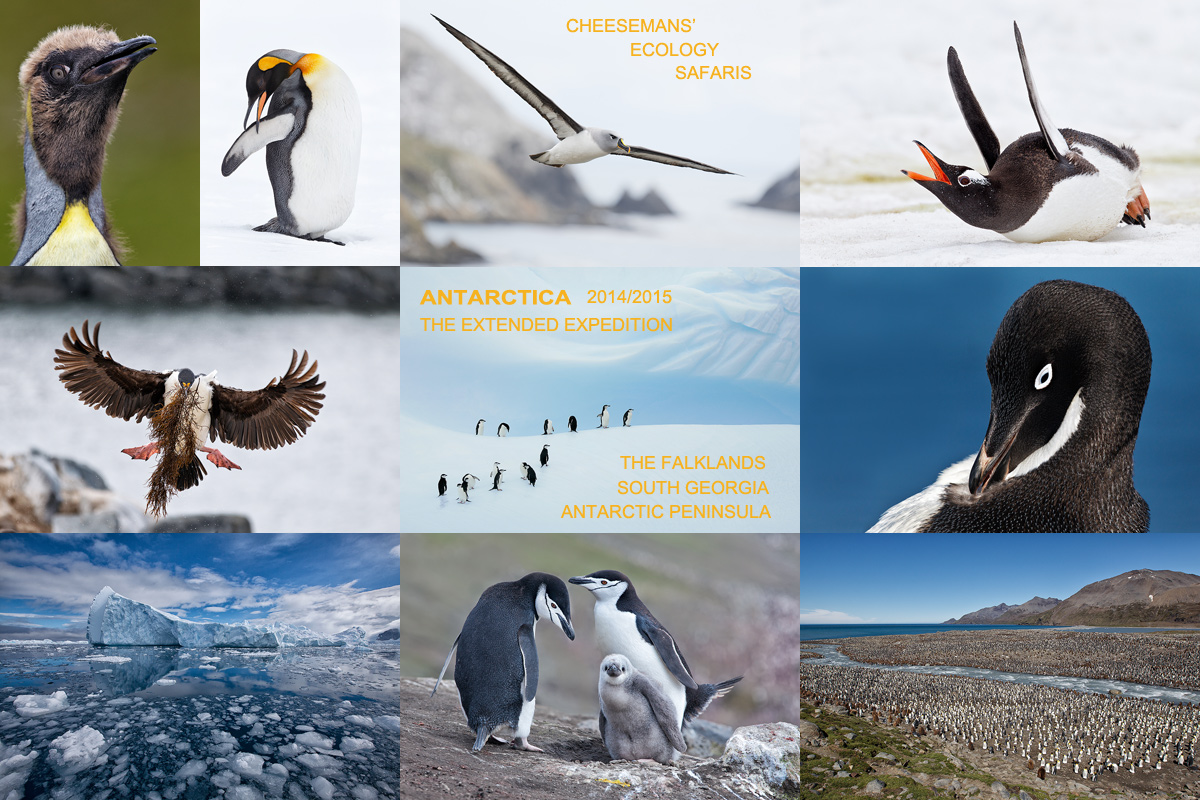
|
|
Breathe deeply, bite the bullet, and live life to its fullest; we all get only one ride on the merry-go-round… Join me on this great trip.
Click on the image to enjoy a larger version.
|
This Could Be You in the Southern Ocean!
I’ve been blessed. I’ve made three trips to the Southern Ocean, two extended trips that visited the Falklands, South Georgia, and the Antarctic Peninsula, and one to the Falklands and South Georgia. Each was a truly amazing experience. With three trips under my belt, I have a pretty good idea about how to make great images at each of the iconic landings. And I would love the chance to share my knowledge with you.
And I know from personal experience that if you are a photographer who is going to invest in Southern Ocean voyage that you will want to put your money on Cheesemans’. No other tour company goes so far out of their way to ensure making every possible safe landing. And no other tour company will have you spending more time on land. Here, from the” Way to Go CES! (Cheeseman’s Ecology Safaris)” blog post here, is one of my favorite Cheesemans’ stories:
The landing at Bailey Head, Antarctica, was especially rewarding to me as I had been sitting in a zodiac 100 yards off shore on my 2007 trip when the zodiac in front of mine swamped and the captain of the ship called off the landing…. Early that day it looked as if my weather Karma might not be working. Ted’s “Good morning shipmates” was followed by the news that we would not be able to land at Bailey Head that morning as the swell was too big. The beach there is sloped tremendously and the sea strives to pull the zodiacs back into the ocean before folks have gotten off with their gear. Tom Murphy had said to me several days before, “We will get you on the beach at Bailey Head.” Ted concluded his morning greetings by saying, “We are sending out a scout team to see if landing is possible.”
After breakfast I was thrilled to hear Ted’s voice again on the PA, “We will be landing at 8am.” Afterwards folks noted that it was the calmest landing ever at this amazingly beautiful spot. My good weather Karma (courtesy of late-wife Elaine) had come through one last time. Along with St. Andrews Bay, it was one of my two favorite super-great once-in-a-lifetime days of the trip. And we even got to enjoy three additional hours at Hannah Point, Antarctica before calling it a wrap and heading for the feared Drake Passage. All thanks to Cheesemans’ Ecology Safaris.
Why Sign Up Through BIRDS AS ART?
If you have been thinking and dreaming of finally visiting South Georgia and Antarctica, this is the trip for you. Quit dreaming and act now. Though I will not be an official leader on this trip, those who have traveled with me know that I cannot help but teach. I will make pre-trip gear recommendations. I will hold informal pre-landing briefings. In the same vein, everyone will receive a free copy of our Antarctica Site Guide once they are paid in full (August 15, 2014). I will be available on the ship to review your images,, answer questions, and conduct informal over-the shoulder Photoshop sessions. And best of all everyone who signs up under the auspices of BAA are invited to tag along with me on the landings where I will be glad to offer invaluable in-the-field advice. And the same goes for the ship-board birds in flight and marine mammal photography opportunities.
Do join us. To learn how to be part of the BAA group please e-mail me with the words Antarctica/Extended Expedition BAA Info Please cut and pasted into the Subject line.
The Cheesemans’ Ecology Safaris Antarctica/The Extended Expedition Voyage
Antarctic Peninsula, South Georgia and Falkland Islands: December 13, 2014 to January 10, 2015
From the CES website:
Join us on a voyage of discovery to an awe-inspiring world devoted to nature, wildlife, science, and peace. This expedition will have you completely captivated, from the stunning vistas of Tierra del Fuego to the busy penguin rookeries of the Falklands, from the dramatic landscapes of South Georgia to the ice-covered terrain of the Antarctic. Board the comfortable, safe and newly upgraded Ortelius for an expedition offering an unparalleled 17 landing days in the Southern Ocean. Our voyage includes three days in the Falklands with a huge diversity of species, six days at South Georgia Island, the all but undiscovered rugged land of towering mountains and thriving colonies of penguins, seals, and albatross, one day at the South Orkneys with nesting Snow Petrels, and seven days along the Antarctic Peninsula, the wonderland of ice and inconceivably vibrant polar wildlife. During days at sea, our naturalists on the ship’s bridge and stern share sightings of whales and seabirds, including many of the world’s species of albatross. Maximum time both on shore and Zodiac cruising will be available for photography, wildlife experiences, and exploring the landscapes of the great Southern Ocean. Our priority is assuring the most in-depth wildlife experience in the Antarctic, an experience made possible by our excellent itinerary and committed expedition staff.
I can personally attest to the accuracy of everything above. 🙂
Additional Links
Learn about the global ocean here.
Antarctic Inspiration from Paul Mckenzie here.
Way to Go CES! (Cheeseman’s Ecology Safaris) here.
Or simply type any of the following words or phrases in the little white search box on the top right of this page, hit Search, and follow the links: penguin; Antarctica; South Georgia; Falklands. Have fun.
The Pull is Too Strong…
The pull is too strong. I need to go back. And I am. Do join me for an unparalleled wildlife and scenic photography experience. Please e-mail or leave a comment if you’d like to learn more.
Facebook
Be sure to like and follow BAA on Facebook by clicking on the logo link upper right. Tanks a stack!
Support the BAA Blog. Support the BAA Bulletins: Shop B&H here!
We want and need to keep providing you with the latest free information, photography and Photoshop lessons, and all manner of related information. Show your appreciation by making your purchases immediately after clicking on any of our B&H or Amazon Affiliate links in this blog post. Remember, B&H ain’t just photography!
…..
Amazon.com
Those who prefer to support BAA by shopping with Amazon may use this link:
Amazon Canada
Many kind folks from north of the border, ay, have e-mailed stating that they would love to help us out by using one of our affiliate links but that living in Canada and doing so presents numerous problems. Now, they can help us out by using our Amazon Canada affiliate link by starting their searches by clicking here. Many thanks to those who have written.
Typos
In all blog posts and Bulletins, feel free to e-mail or to leave a comment regarding any typos, wrong words, misspellings, omissions, or grammatical errors. Just be right. 🙂
September 7th, 2014 The Streak Continues: 281
This blog was published at about 6:30am from my home in Indian Lake Estates, FL after a strange night’s sleep. I was in bed by 10:00pm, a bit on the late side for me. I awoke at midnight to persistent but strong dull aches in both my right shoulder and my left knee, surely the body’s response to Wednesday’s stem cell/PRP/Prolozone injections. PRP stands for platelet rich plasma. My understanding is the the injections, especially the PRP, inflame the joint tissue which then heals by re-growing new tissue, the end result being a stronger pain-free joint. Thus last night’s pain–a small price to pay for healing.
I slept well for more than five hours until I woke from a traveler’s nightmare. I got to the airport for a bit photo trip aghast to see only my tripod and my hiking boots in the trunk. Zero checked bags. I do not know if I made it home and back in time to make my flight as I awoke feeling quite unsettled :).
This post, which took me about 2 1/2 hours to prepare, makes 281 in a row. 365 is well within sight….
As always, I would appreciate your using the BIRDS AS ART B&H affiliate links for all of your major gear, video, and electronic purchases, using our Amazon logo-link for all of your household purchases, and visiting the BAA Online Store for your tripod, tripod head, LensCoat, miscellaneous, accessories, and eGuide purchases as well. Please remember, web orders only. 🙂
Worth a Second Look…
While looking through various trip folders on Saturday evening in search of an image or two for Sunday’s blog post I came across the image above and thought, “How did I miss this one?”
I remember the situation. I was walking back from the Beatrix Pavilion towards the car park in search of a lost couple from the group. I learned later that they had inadvertently walked across the whole of the gardens following signs to the wrong exit. 🙂 When I saw this single tulip I added the 2X TC to the tripod-mounted 70-200 to take advantage of the isolating power of the 400mm focal length and set up the gorgeous red background. I never shy away from adding the 2X III TC to any of my L series Canon lenses; many folks do over concerns with image sharpness….
In retrospect it is possible that the late afternoon back light is what steered me away from optimizing this image long ago.
There is a section on using long lenses for flower photography in The Art of Flower Photography eGuide; scroll down for details. And of course folks who join us in Holland will get daily doses of the same. And tons more. Again, scroll down here for dates, rates, and details. You only live once 🙂
Speaking of the Image Optimization…
The key to the success of this image was managing the incredible REDs while at the same time controlling noise during the RAW conversion. DPP 4.0 to the rescue. I made lots of small changes to Hue, Saturation, and Luminance in the RED, YELLOW, and ORANGE channels on the Adjust image colors tab. I used the incredible Chromiance and Luminance Noise Reduction tables that Arash painstakingly developed for our new DPP RAW Conversion Guide. His suggested values worked like a charm.
The New DPP RAW Conversion Guide
To learn why I use Canon’s Digital Photo Professional (DPP) to convert every image that I work on, click here. Coming soon: The DPP 4.0 RAW Conversion Guide by Arash Hazeghi and Arthur Morris. The more that I use DPP 4.0 for my RAW conversions the more I am impressed with it. I put in several more hours of work on the guide on Saturday editing and adding to the new eGuide and augmented that with two lengthy phone sessions with Arash. My time-consuming, meticulous work on the guide has proven to be a great way to master DPP 4.0. We hope to have the guide finished before the end of the month if not sooner.
Note: at present, DPP 4.0 works only with 1D X, 5D III, and 6D images.
Lens Pen News
Lens Pen offers several types of small pens that can be used effectively to clean the sensors of digital cameras safely and efficiently. For almost a decade we offered the Lens Pen combo kit for $20 recommending that folks use the smaller of the two Lens Pens to clean their sensors and keep the larger one in their photo vests or fanny packs to clean the front and rear elements of their teleconverters and to remove troublesome thumbprints or spots of unidentified gunk from the front elements of their lenses.
About a year ago I learned that the Lens Pen combo kit had been discontinued and that the manufacturing of the small Lens Pens had been discontinued as well. I told Jim to take the Combo Kit out of the store and save the last 20 kits for my personal use. One of the two major Camera manufacturers purchases 30,000 Lens Pens each year to be used by their repair centers to clean the sensors of folks who send their cameras in for service….
About two months ago I was working with the Lens Pen rep to see if I could come up with an adequate replacement to the small Lens Pens that I loved, valued, and depended on for a decade. I do not like the Lens Pens with the tiny triangular cleaning surfaces. The next thing that I know Gary tells me that his brother-in-law recently discovered that he had 5,000 small Lens Pens in stock. We ordered 1,000 of them immediately. Jim has been after me for several weeks to mention this in the blog….
If you visit the BAA Online Store you can purchase one or more of my favorite Lens Pen Mini Pros here for $9.99 today only, Sunday, September 7, 2014. There will be a price increase of $2.00 as soon as Jim gets to work on Monday morning.
The Lens Pen Mini Pro
- Will not scratch or damage your sensor.
- Outperforms all other sensor cleaning devices.
- The unique LENS PEN tip is self-replenishing.
- The cleaning compound will not spill or dry.
- It is safe for all optical lens surfaces including multi-coated ones.
- NOTE: You will need more than one Lens Pen if you plan to use one on your lenses and teleconverters; you must set aside one Lens Pen for sensor cleaning only.
- Your purchase includes a detailed Sensor Cleaning tutorial that will be sent via e-mail.
- For best results, use in conjunction with the Delkin Sensor Scope.
Click here to learn about all of our sensor cleaning supplies.
Coming Tomorrow
In tomorrow’s blog post I will share a great new Giottos Rocket-Air Super AIR Blower sensor cleaning tip.
Your Help Is Needed
Sales for the August, 2014 via our BIRDS AS ART B&H affiliate links have been microscopically abysmal at best. If you need to purchase some new camera gear, please remember to use either our B&H logo link below or one of the product-specific links in the blog or the Bulletins. All should feel free to write me via e-mail for gear advice.
The Art of Flower Photography
Click here if you missed the recent eBook announcement.
Ken Kovak: I have been working my way through the “Art of Flower Photography” and it is both a feast for the eyes and quite informative.
Art Buesing: Artie and Denise have outdone themselves with “The Art of Flower Photography.” Gorgeous photos with careful explanations of the production techniques for camera and computer. A valuable addition to my photography library!
|
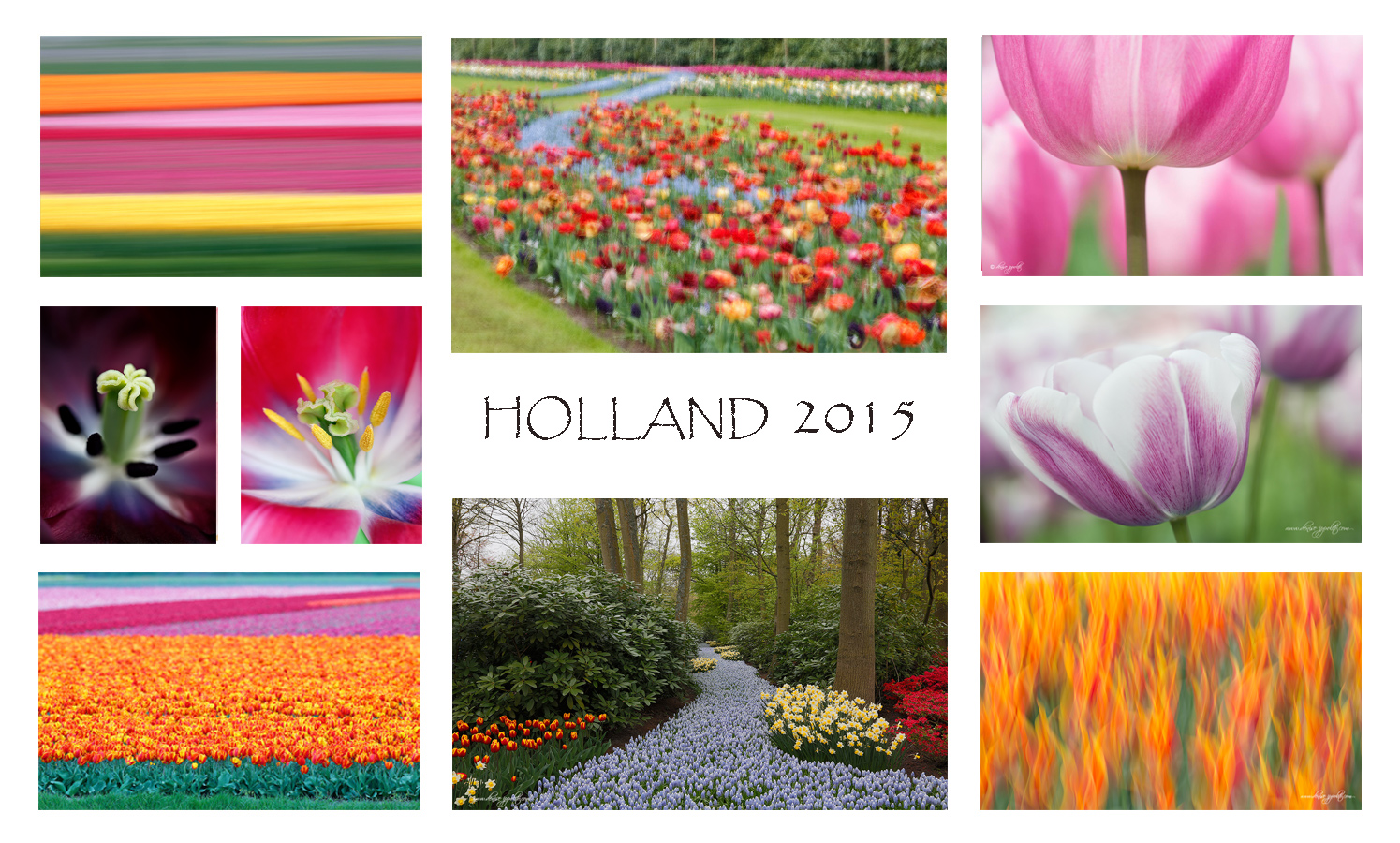
|
|
Denise and artie hope that you can join them next spring in Holland and learn to improve both the technical and creative aspects of your flower (and street) photography.
|
7 1/2-Day/8-Night: A Creative Adventure/BIRDS AS ART/Tulips & A Touch of Holland Instructional Photo-Tour (IPT)
Keukenhof—Delft—Amsterdam–Flower Fields—Kinderdijk
April 9 -April 16, 2015: $4995. Limit: 12 photographers/Openings 10. Four more to make the trip a go.
This trip needs 6 registrants to run so please do not purchase your plane tickets until you hear from us that the trip is a go.
Join Denise Ippolito, the author of “Bloomin’ Ideas,” and Arthur Morris, Canon Explorer of Light Emeritus, for a great trip to Holland in mid-April 2015. Day 1 of the IPT will be April 9, 2015. We will have a short afternoon get-together and then our first photographic session at the justly-famed Keukenhof. Our last day, Day 8, April 16 will be a full day of photography.
The primary subjects will be tulips and orchids at Keukenhof and the spectacularly amazing tulip, hyacinth, and daffodil bulb fields around Lisse and points north. We will spend one full day in Amsterdam. There will be optional visits to the Van Gogh Museum, the Anne Frank House and/or the Rijk’s Museum. Street photography and sightseeing will be other options. We will spend a half day at Kinderdijk where we will be photographing the windmills and doing some creative photography. We will spend an afternoon in the lovely Dutch town of Delft where we will do some street photography and shopping. There is an optional church tower tour/climb. We will also enjoy a superb fine dining experience in a traditional restaurant.
Other than the arrival date: April 9, Day 1, and the date of our last day of photography on April 16, Day 8, there is no set itinerary. We will check the weather and play everything by ear to maximize the photographic opportunities. We will try to do Amsterdam, Delft, and especially Kinderdijik, on cloudy days.
There are several huge pluses to this trip. First off, denise is an amazingly skilled and caring instructor. Both her creativity and her willingness to share and to help beginning and intermediate photographers are unmatched. And though artie has learned a ton about flower photography from denise, their styles and techniques do vary considerably. You will have a chance to be counseled by and to learn from both of them. While denise will hunt you down to help you, artie’s teaching style is more “the closer you stay to me, the more you will learn.” Both leaders consistently inspire the participants. And each other. The sky, of course, is the limit.
You will learn to create tight abstracts, how best to use depth-of-field (or the lack thereof) to improve your flower photography, how to get the right exposure and make sharp images every time, how to see the best shot, and how to choose the best perspective for a given situation. And you will of course learn to create a variety of pleasingly blurred flower images. If you bring a long lens, you will learn to use it effectively for flower photography. Denise’s two favorite flower lenses are the Canon EF 100mm f/2.8L Macro IS USM lens and the Canon EF 24-105mm f/4L IS USM lens. Mine are the Canon 100mm f/2.8L IS macro , the Canon EF 180mm f/3.5L Macro USM lens ,and the Canon EF 300mm f/2.8L IS II USM lens, all almost always on a tripod. Often with extension tubes and/or either the 1.4X or the 2X (with the 300 II) teleconverters. Denise hand holds a great deal of the time. For flower field blurs denise uses the same lenses mentioned above along with her new 70-200mm f/2.8L IS III lens. Artie’s favorite is that same 70-200 often with a 1.4X TC but he uses both the new Canon EF 24-70mm f/2.8L II USM lens and the 300 II as well. Both of us use and love the Canon EOS 5D Mark III for all of our flower photography. The in-camera HDR and Multiple Exposure features are a blast.
One of the great advantages of our trip is that we will be staying in a single, strategically located hotel that is quite excellent. Do note that all ground transfers to and from Schipol Airport will be via the free hotel shuttle bus.
What’s included: Eight hotel nights. All ground transportation except for airport transfers as noted above. In-the-field instruction and small group image review and Photoshop sessions. All meals from dinner on Day 1 through dinner on Day 8. There is good food at the hotel and we will be dining there on occasion; whenever you order off the menu be it at the hotel or at another restaurant only the cost of your main course is included. On these occasions the cost of soups, appetizers, salads, sodas and other beverages, alcoholic drinks and wine, bottled water, and desserts are not included. Snacks, personal items, phone calls, etc. are also not included. The cost of bus or train transportation to and from Amsterdam (about $20 US), museum entry, and tower and church entry fees (optional) are likewise not included.
Beware of seemingly longer, slightly less expensive tours that include travel days and days sitting in the hotel doing nothing as part of the tour. In addition, other similar trips have you changing hotels often and needlessly. One final note on other similar trips: the instructors on this trip actually instruct. On other similar trips the instructors, though usually imminently qualified, serve for the most part as van drivers and van door openers.
A non-refundable deposit of $1,000 per person is required to hold your spot. The second payment of $2,000 due by October 30, 2014. The balance is due on January 15, 2015. Payments in full are of course welcome at any time. All payments including the deposit must be by check made out to “Arthur Morris.” As life has a way of throwing an occasional curve ball our way, you are urged to purchase travel insurance within 15 days of our cashing your check. Artie uses and recommends Travel Insurance Services. All payments are non-refundable unless the trip fills to capacity. In that case, all payments but your deposit will be refunded. If the trip does not run every penny will of course be refunded. Again, please do not purchase your air tickets until you hear from us that the trip is a go. We are very confident that it will.
All checks should be made out to “Arthur Morris” and sent to: Arthur Morris, PO Box 7245, Indian Lake Estates, FL 33855. Call Jim or Jen in the BAA office with any additional registration questions: 863-692-0906.
For couples or friends signing up at the same time for the tulip trip, a $200/duo discount will be applied to the final payment.
When you send your deposit check, please print, sign, and include the paperwork here.
If you have any questions on the trip please contact artie by e-mail or denise by e-mail.
Facebook
Be sure to like and follow BAA on Facebook by clicking on the logo link upper right. Tanks a stack!
Support the BAA Blog. Support the BAA Bulletins: Shop B&H here!
We want and need to keep providing you with the latest free information, photography and Photoshop lessons, and all manner of related information. Show your appreciation by making your purchases immediately after clicking on any of our B&H or Amazon Affiliate links in this blog post. Remember, B&H ain’t just photography!
…..
Amazon.com
Those who prefer to support BAA by shopping with Amazon may use this link:
Amazon Canada
Many kind folks from north of the border, ay, have e-mailed stating that they would love to help us out by using one of our affiliate links but that living in Canada and doing so presents numerous problems. Now, they can help us out by using our Amazon Canada affiliate link by starting their searches by clicking here. Many thanks to those who have written.
Typos
In all blog posts and Bulletins, feel free to e-mail or to leave a comment regarding any typos, wrong words, misspellings, omissions, or grammatical errors. Just be right. 🙂
September 6th, 2014 The Streak Continues: 280
This blog was published at about 6:15am from my home in Indian Lake Estates, FL after another good night’s sleep. I enjoyed a nice swim again yesterday and a rather lazy day. Though both the left shoulder and right knee are feeling pretty darned good this morning, only time will reveal the effects of the recent stem cell/PRP/Prolozine injections. Healing takes time. This post, which took me about 2 1/2 hours to prepare, makes 280 in a row. 365 is well within sight….
As always, I would appreciate your using the BIRDS AS ART B&H affiliate links for all of your major gear, video, and electronic purchases, using our Amazon logo-link for all of your household purchases, and visiting the BAA Online Store for your tripod, tripod head, LensCoat, miscellaneous, accessories, and eGuide purchases as well. Please remember, web orders only. 🙂
You can find the following items in the store: Gitzo tripods, Mongoose M3.6 and Wimberley heads, plates, low feet, and accessories, flash brackets, , Delkin e-film Pro Compact Flash Cards, LensCoat products, and our unique line-up of educational materials including ABP I & II, Digital Basics, Site and Set-up e-Guides, Canon and Nikon Camera Users and AF e-Guides, and MP-4 Photoshop video tutorials among others.
For the photographic stuff mentioned in the paragraph above we, meaning BAA, would of course greatly appreciate your business. Purchasing the items listed above actually hurts us :). Here is a huge thank you to the many who have been using our links on a regular basis and visiting the BAA Online store as well.
Despicable Tales
If you hear a despicable tale about someone please take a moment to consider both the source and the source’s motives….
|
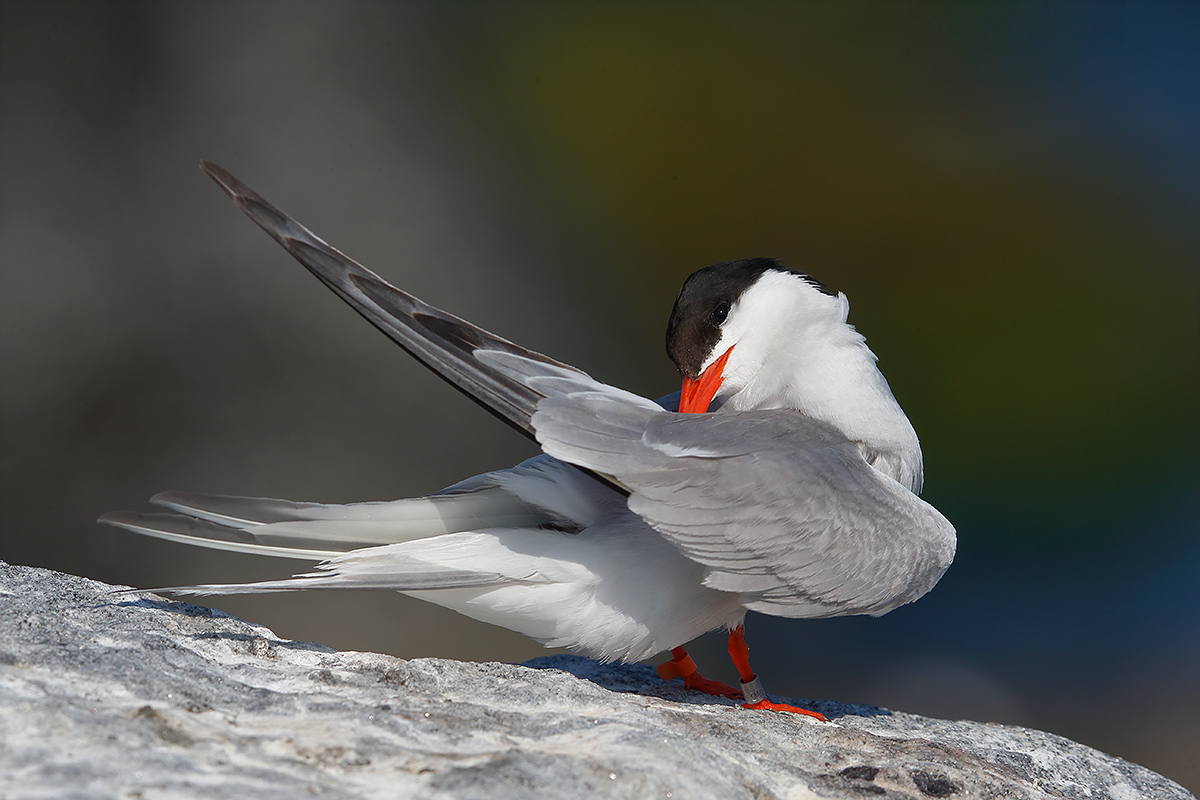
|
|
This image was created at 9:03:55am on July 25, 2014 at Great Gull Island with the Gitzo 3532 LS carbon fiber tripod, the Mongoose M3.6 head, the Canon EF 600mm f/4L IS II USM lens, the Canon Extender EF 2X III, and the Canon EOS-1D X. ISO 400. Evaluative metering -1/3 stop as framed: 1/1250 sec. at f/11 in Manual mode. With brilliant WHITEs in full sun you will never be far off the right exposure at 1/2500 sec. at f/8 or, as here, an equivalent exposure.
Central Sensor (by necessity)/AI Servo-Expand/Rear Focus AF on the base of the tern’s neck and re-compose. Click here to see the latest version of the Rear Focus Tutorial. Click on the image to see a larger version.
Image #1: Common Tern/Perfect Preening Head Angle
|
1D X Frame Rate
Eighty-one frames in 20 seconds. Seven keepers, the three best of those presented here. While the frame rate sounds impressive, it is but a fraction of what the Canon EOS-1D X is capable of. I could have created well more than 200 images in those 20 seconds but I fired only when there was a chance that the tern’s head would be in a decent position relative to its body. And I paused several times to re-focus.
That said, the speed of the 1D X enables bird photographers to capture instants in time that they may not have been able to see with the human eye. If you see the tern grab ones of its primaries in its bill while preening, it is too late to press the shutter button. Folks need to learn to anticipate the best potential positions and then hold the shutter button down for short rapid fire bursts of three to six or more frames. Remember however that if you are working with a shutter speed of 1/1000 sec. with a camera that fires 10 fps and you hold the shutter button down for exactly one second you will still be missing 99% of the action….
None-the-less, the Canon EOS-1D X is by far the best camera that I have ever owned or used for creating images of birds in flight or in action. On many occasions it has enabled me to capture special moments that I never saw or envisioned.
If reading this post has convinced you to finally purchase a 1D X please consider using the B&H BAA affiliate logo link below. And please remember, web orders only. E-mail us a copy of your B&H receipt and we will be glad to send along a free copy of my EOS-1D X AF Guide.
|
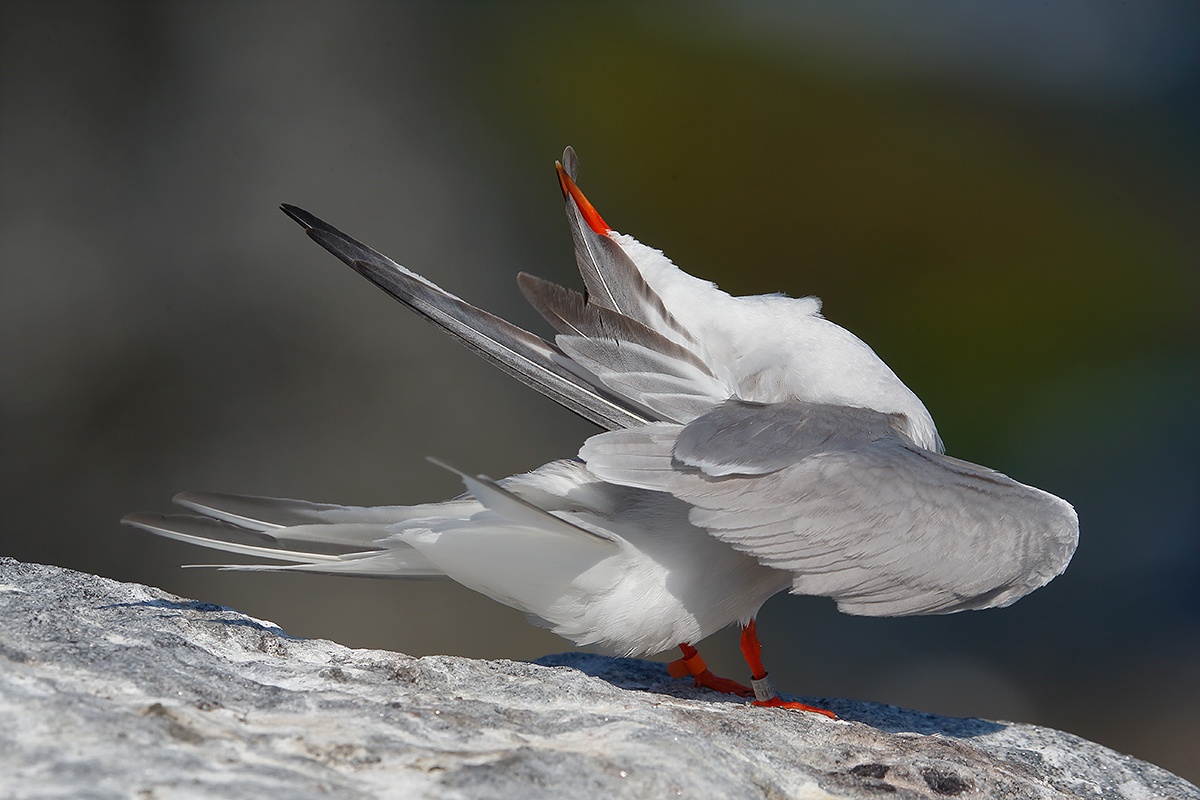
|
|
This image was created at 9:03:56am on July 25, 2014 at Great Gull Island with the Gitzo 3532 LS carbon fiber tripod, the Mongoose M3.6 head, the Canon EF 600mm f/4L IS II USM lens, the Canon Extender EF 2X III, and the Canon EOS-1D X. ISO 400. Evaluative metering -1/3 stop as framed: 1/1250 sec. at f/11 in Manual mode. With brilliant WHITEs in full you will never be far off the right exposure at 1/2500 sec. at f/8 or, as here, an equivalent exposure.
Central Sensor (by necessity)/AI Servo-Expand/Rear Focus AF on the base of the tern’s neck and re-compose. Click here to see the latest version of the Rear Focus Tutorial. Click on the image to see a larger version.
Image #2: Common Tern/Where’s the Eye?
|
Image Optimization Questions
Would you have chosen to remove the metal band and the orange plastic leg flag (where visible)? Why or why not?
Photoshop Trickery Question
After enlarging each image let us know if you see any absolute evidence of a major change or changes made in Photoshop.
|
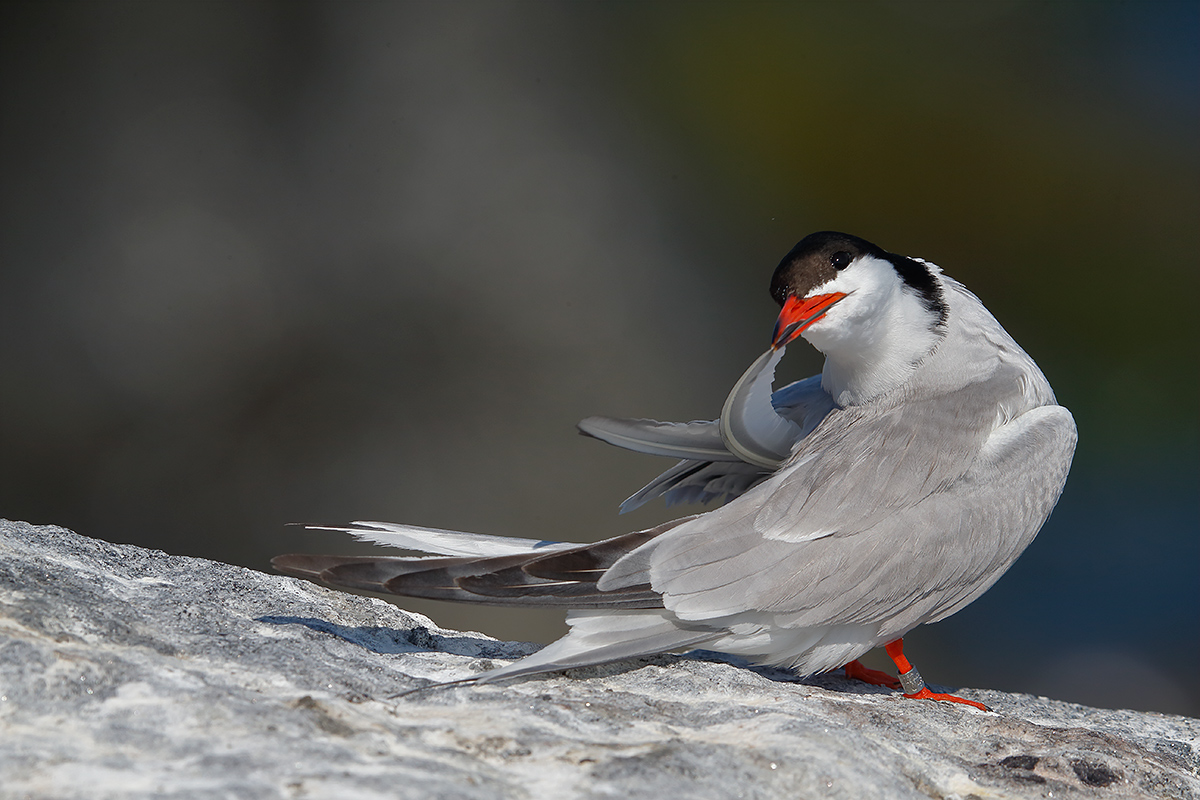
|
|
This image was created at 9:03:59am on July 25, 2014 at Great Gull Island with the Gitzo 3532 LS carbon fiber tripod, the Mongoose M3.6 head, the Canon EF 600mm f/4L IS II USM lens, the Canon Extender EF 2X III, and the Canon EOS-1D X. ISO 400. Evaluative metering -1/3 stop as framed: 1/1250 sec. at f/11 in Manual mode. With brilliant WHITEs in full you will never be far off the right exposure at 1/2500 sec. at f/8 or, as here, an equivalent exposure.
Central Sensor (by necessity)/AI Servo-Expand/Rear Focus AF on the base of the tern’s neck and re-compose. Click here to see the latest version of the Rear Focus Tutorial. Click on the image to see a larger version.
Image #3: Common Tern/”The Curve”
|
The Best Image
Please take a moment to let us know which of the 3 images you feel is the strongest. And why. Feel free to let us know what you like or don’t like about each of the three images.
Image Flaw Question
Images #1 and #2 each have a similar flaw that is not seen in Image #3. What is it?
Blog Interactivity
While it is great that an average of more than 2,000 folks visit and learn from the blog each day it would be wonderful if more than a handful of folks tackled the questions that are designed to make the blog more interactive and less static.
Important Bosque Festival of the Cranes Event Registration Notice
Registration for all Festival of the Cranes workshops, seminars and programs is open. Please click here and read carefully to avoid missing out on several wonderful and inexpensive educational opportunities. Please do not tarry as we expect all of the BAA/A Creative Adventure sessions to sell out quickly, especially the early morning In-the-Field Workshops. You can click http://www.festivalofthecranes.com“>here to register.


Facebook
Be sure to like and follow BAA on Facebook by clicking on the logo link upper right. Tanks a stack!
Support the BAA Blog. Support the BAA Bulletins: Shop B&H here!
We want and need to keep providing you with the latest free information, photography and Photoshop lessons, and all manner of related information. Show your appreciation by making your purchases immediately after clicking on any of our B&H or Amazon Affiliate links in this blog post. Remember, B&H ain’t just photography!
…..
Amazon Canada
Many kind folks from north of the border, ay, have e-mailed stating that they would love to help us out by using one of our affiliate links but that living in Canada and doing so presents numerous problems. Now, they can help us out by using our Amazon Canada affiliate link by starting their searches by clicking here. Many thanks to those who have written.
Typos
In all blog posts and Bulletins, feel free to e-mail or to leave a comment regarding any typos, wrong words, misspellings, omissions, or grammatical errors. Just be right. 🙂
September 5th, 2014 The Streak Continues: 279
This blog was published at 7:45am from my home in Indian Lake Estates, FL after another good night’s sleep. I enjoyed an easy swim yesterday; only time will reveal the effects of the stem cell/PRP/Prolozine injections in my right shoulder (the 2nd set) and left knee. Healing takes time. This post, which took me about 3 hours to prepare, makes 279 in a row.
As always, I would appreciate your using the BIRDS AS ART B&H affiliate links for all of your major gear, video, and electronic purchases, using our Amazon logo-link for all of your household purchases, and visiting the BAA Online Store for your tripod, tripod head, LensCoat, miscellaneous, accessories, and eGuide purchases as well. Please remember, web orders only. 🙂
You can find the following items in the store: Gitzo tripods, Mongoose M3.6 and Wimberley heads, plates, low feet, and accessories, flash brackets, , Delkin e-film Pro Compact Flash Cards, LensCoat products, and our unique line-up of educational materials including ABP I & II, Digital Basics, Site and Set-up e-Guides, Canon and Nikon Camera Users and AF e-Guides, and MP-4 Photoshop video tutorials among others.


I would of course appreciate your using our B&H affiliate links for all of your major gear, video, and electronic purchases. For the photographic stuff mentioned in the paragraph above we, meaning BAA, would of course greatly appreciate your business. Here is a huge thank you to the many who have been using our links on a regular basis and visiting the BAA Online store as well.
|
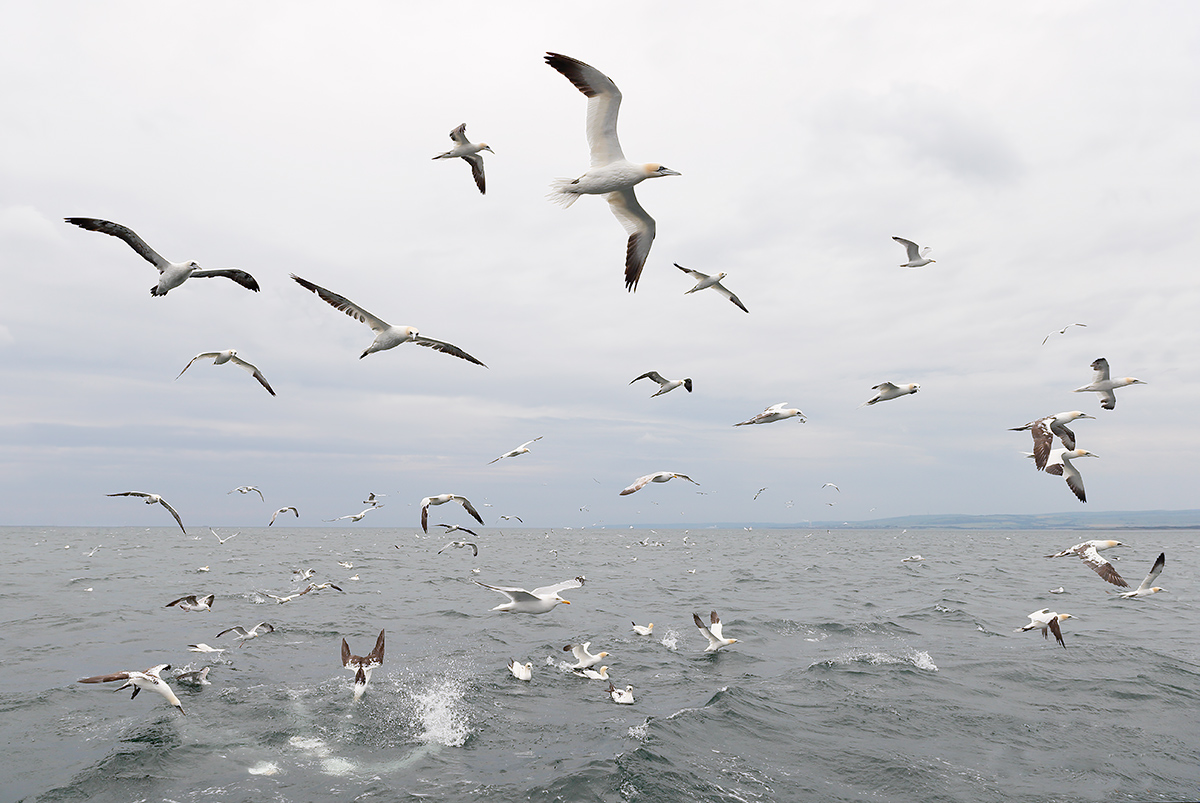
|
|
This image was created on last July’s UK Puffins and Gannets IPT with the Canon EF 24-70mm f/2.8L II USM lens (hand held at 24mm) and the Canon EOS-1D X. ISO 800. Evaluative metering +1 2/3 stops off the sky: 1/2000 sec. at f/4.5 in Manual mode. Color temperature: Cloudy.
Central sensor/AI Servo/Surround Rear Focus AF on the closest gannets hitting the water and re-compose. Click here to see the latest version of the Rear Focus Tutorial. Click on the image to see a larger version.
|
Ah, The Insanity Of It…
Once the mate began tossing fish and the gannets came, it was pure chaos. Within the hour, folks began taking extended rests, too exhausted even to lift their 70-200s. Once in a while I would take short “break” by going for some wide stuff with the 24-70. It is a lot lighter than the 70-200 f/2.8L IS II.
As you might surmise, the big key to creating pleasing images of single birds like the one immediately below is being able to isolate your chosen subject. Going to a longer focal length, a tactic that usually works well when you have problems isolating a single bird in a flock, did not help on the gannet boat because the birds were simply too close. In fact, pretty much everyone in the group removed their 1.4X teleconverters from their 70-200s….
So how do you go about isolating a single gannet? Study and anticipation. I urged the group to simply quit photographing the birds for a minute, to see how they were flying, to note the direction of the wind and the quality and direction of the light. Bird behavior tends to be repetitive.
In the situation pictured above, I might have counseled the group in my loudest voice something like this, “Watch for the birds coming in from our left. Get on one that looks to be in a bit of relatively clear sky and wait until it turns to its right and starts to dive. Then push and hold the shutter button. Be sure to follow through.”
|
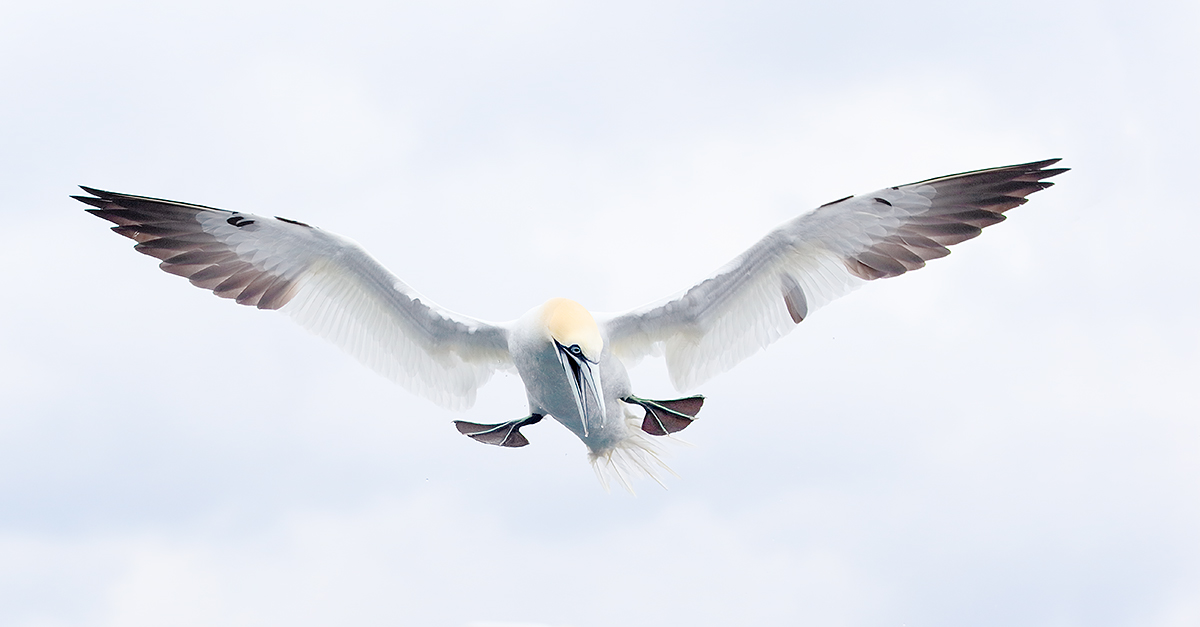
|
|
This image was also created on the gannet boat on the UK Puffins and Gannets IPT, this one with the Canon EF 70-200mm f/2.8L IS II USM lens (hand held at 140mm) and the and the Canon EOS-1D X. ISO 800. Evaluative metering +2 stops off the dreary grey sky was still a significant under-exposure: 1/2000 sec. at f/4 in Manual mode. AWB
Central sensor Surround/AI Servo Rear Focus AF on the bird’s right foot was active at the moment of exposure. Click here to see the latest version of the Rear Focus Tutorial. Click on the image to see a larger version.
Image #2: Spotting the Fish
|
Isolating a Single Bird
In addition to figuring out the flight and diving patterns, isolating a single gannet in the mayhem takes a great deal of determination and some degree of stamina. I still have probably 200 very good images of single gannets in flight to process….
The Image Optimization
First off, I will say that I realize that there are a few of you out there who prefer the original chaotic image to the cleaner more balanced look of the optimized image. I am fine with that but much prefer the optimized version.
Here is an easy multiple choice question: How much time did I spend on the image optimization?
a-about 30 minutes
b-about one hour
c-about 90 minutes
d-very close to two hours
After the conversion in DPP 4.0, the clean-up–as always–was done with a combination of the Clone Stamp Tool, the Spot Healing Brush, the Patch Tool, and many small Quick Masks that were refined via the addition of a Regular Layer Mask. I used both the “Divide and Conquer” and the “Denise Ippolito Protective Cloning on a Layer” techniques. And I used them often. I applied a heavy layer of Image> Blur> Surface Blur and painted that onto the sky via an Inverse or Hide-All Layer Mask to smooth out the bird removal and bird relocation repairs. Near the end I move the whole flock a bit back in the frame using techniques from APTATS II. Lastly I noticed that the image needed to be leveled; that resulted in the need for a small crop.
The DPP RAW Conversion Guide
To learn why I use Canon’s Digital Photo Professional (DPP) to convert every image that I work on, click here. Coming soon: The DPP 4.0 RAW Conversion Guide by Arash Hazeghi and Arthur Morris. The more that I use DPP 4.0 for my RAW conversions the more I am impressed with it. I will be putting in several more hours of work today editing and adding to our new eGuide. Note: at present, DPP 4.0 will work only with 1D X and 5D III images.
Digital Basics
Everything that I did to optimize today’s image is detailed in my Digital Basics File–written in my easy-to-follow, easy-to-understand style. Are you tired of making your images look worse in Photoshop? Digital Basics File is an instructional PDF that is sent via e-mail. It includes my complete digital workflow, dozens of great Photoshop tips, details on using all of my killer image clean-up tools, the use of Contrast Masks, several different ways of expanding and filling in canvas, all of my time-saving Keyboard Shortcuts, Quick Masking, Layer Masking, and NIK Color Efex Pro basics, Digital Eye Doctor, Tim Grey Dodge and Burn, how to create time-saving actions, and tons more.
APTATS I & II
Learn the details of advanced Quick Masking techniques in APTATS I. Learn Advanced Layer Masking Techniques in APTATS I. Mention this blog post and apply a $5 discount to either with phone orders only. Buy both APTATS I and APTATS II and we will be glad to apply at $15 discount with phone orders only. Please call Jim or Jennifer at 863-692-0906 weekdays to order.
|
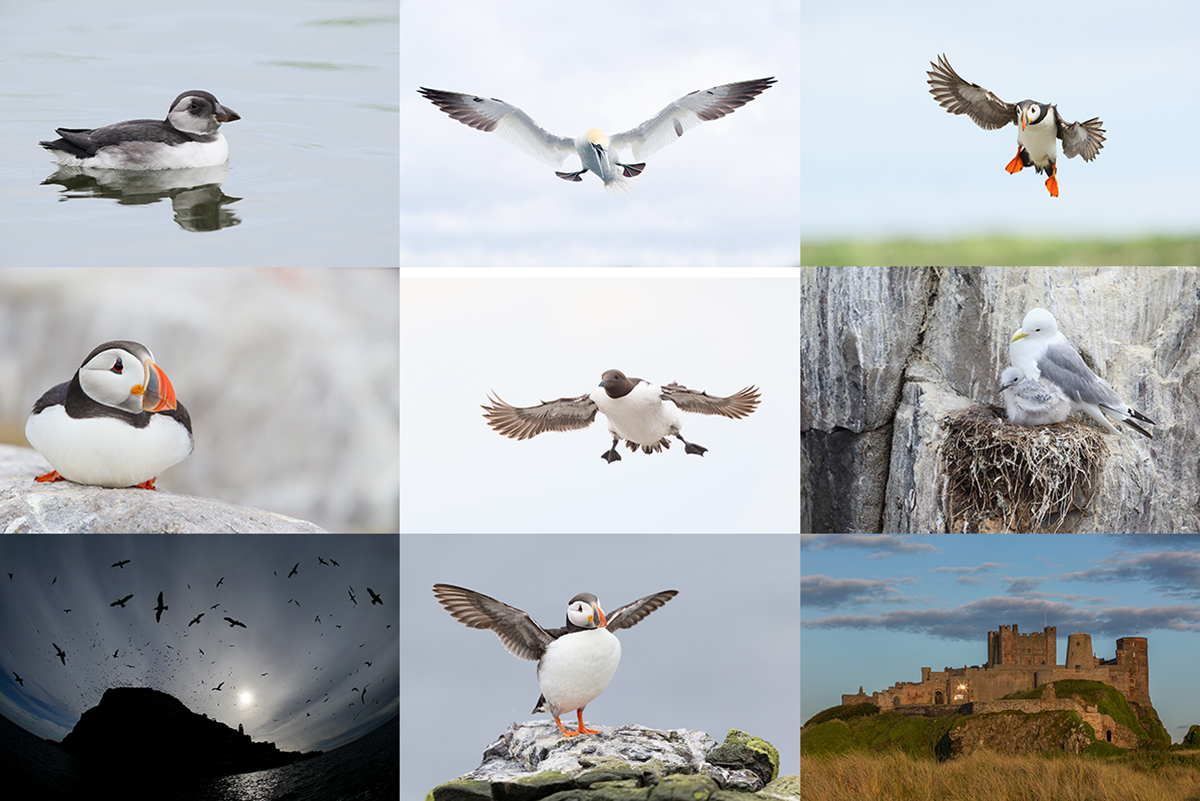
|
|
Images and card design copyright 2014: Arthur Morris/BIRDS AS ART. Click on the card to enjoy a spectacular larger version.
|
The 2015 UK Puffins and Gannets IPT
June 29 through July 5, 2015: $5499: Limit 10 photographers/Openings 2. Two great leaders: Denise Ippolito and Arthur Morris.
Here are the plans for next year: take a red eye from the east coast of the US on 28 June arriving in Edinburgh, Scotland on the morning of Monday 29 June (or simply meet us then either at the Edinburgh Airport (EDI) or later in the day at our cottages if you are driving your own vehicle either from the UK or from somewhere in Europe. Stay 7 nights in two gorgeous modern country cottages.
There are 5 days of planned puffin/seabird trips—weather permitting, and 1 full day of gannet photography with 2 sessions on the boat. (More info below.)
|
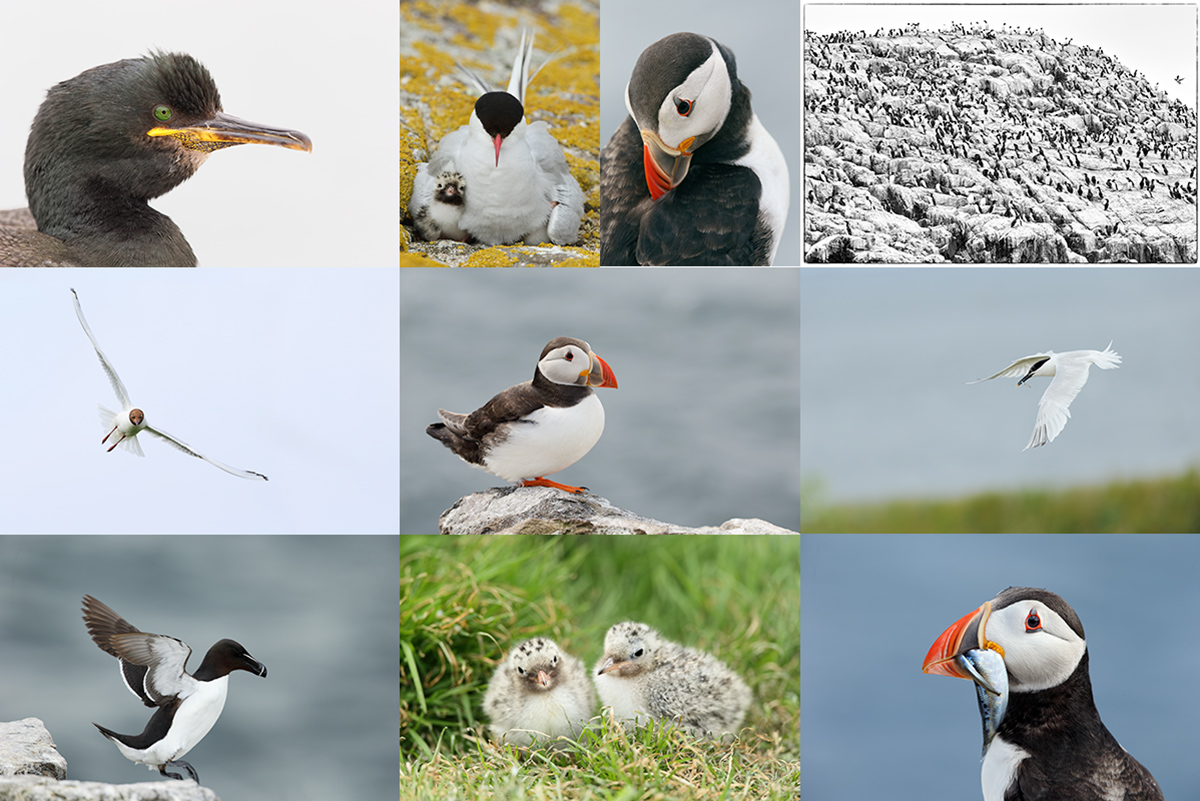
|
|
Images and card design copyright 2014: Arthur Morris/BIRDS AS ART. Click on the card to enjoy a spectacular larger version.
|
The Rest of the Fine Details
All breakfasts, lunches and dinners are included. All 5 puffins boat lunches will need to be prepared in advance, taken with, and consumed at your leisure. I usually eat mine on the short boat trip from one island to the other. Also included is a restaurant lunch on the gannet boat day and a farewell fine dining thank you dinner. The cost of your National Heritage Trust is also included; that covers the twice a day landing fees.
Plan to fly home on the early morning of Monday 6 July or to continue your stay or travels.
We are planning this as double-occupancy only but we should be able to arrange for singles by renting a 3rd cottage. We would need to know well in advance, i.e., soon, and it would be pricey and would need to be paid with your non-refundable deposit of $2,000. The shared rooms are decent-sized, each with two roomy single beds and a private bathroom. There are two king rooms available for couples. The upscale country-side cottages are beyond lovely with large living areas and lots of open space for image sharing and Photoshop lessons.
The single supplement is $1475. As we will be renting a third cottage the $1475 is due with your deposit and is also non-refundable.
If you are good to go please send your $2,000 deposit check now to save a spot. We do expect this workshop to sell out very quickly as we have already sold 2 slots even though the trip has not yet been formally announced till right now. Not to mention that everyone loves puffins. Please make your check out to “Arthur Morris” and send it to Arthur Morris/BIRDS AS ART, PO Box 7245, Indian Lake Estates, FL, 33855.
We do hope that you can join us.
Facebook
Be sure to like and follow BAA on Facebook by clicking on the logo link upper right. Tanks a stack!
Support the BAA Blog. Support the BAA Bulletins: Shop B&H here!
We want and need to keep providing you with the latest free information, photography and Photoshop lessons, and all manner of related information. Show your appreciation by making your purchases immediately after clicking on any of our B&H or Amazon Affiliate links in this blog post. Remember, B&H ain’t just photography!
…..
Amazon Canada
Many kind folks from north of the border, ay, have e-mailed stating that they would love to help us out by using one of our affiliate links but that living in Canada and doing so presents numerous problems. Now, they can help us out by using our Amazon Canada affiliate link by starting their searches by clicking here. Many thanks to those who have written.
Typos
In all blog posts and Bulletins, feel free to e-mail or to leave a comment regarding any typos, wrong words, misspellings, omissions, or grammatical errors. Just be right. 🙂
September 4th, 2014 Helen Hayes/Great Island “CBS This Morning” Feature Aired Yesterday
It was wonderfully done. Older daughter Jennifer and I laughed a lot. Helen’s understated humor cracked us up. When Michelle Miller asked “How did you learn to get along with them?” Helen answered,
“Oh, I got a hat. That made all the difference.” (Tern researchers wear a variety of headgear designed to keep the birds from opening up their scalps while defending their eggs, young, and territories.)
I was happy to see six BAA tern images on TV in the CBS “Taking Flight/Researcher helps migratory birds make a comeback” feature. It was yet another great tribute to the amazing ornithologist, Helen Hays. Those of you who did not get to see or tape it can enjoy “Woman revives Great Gull Island’s tern population” hereor on You Tube here. Thanks to Jay for leaving a comment with the link to the story on the CBS website and to Andrew Grandys for the You Tube link.


Important Bosque Festival of the Cranes Event Registration Notice
Registration for all Festival of the Cranes workshops, seminars and programs is open. Please click here and read carefully to avoid missing out on several wonderful and inexpensive educational opportunities. Please do not tarry as we expect all of the BAA/A Creative Adventure sessions to sell out quickly, especially the early morning In-the-Field Workshops.
The Streak Continues: 278
This blog was published just before 7:15am from my home in Indian Lake Estates, FL after another good night’s sleep. I did have stem cell/PRP/Prolozine injections in my right shoulder (the 2nd set) and the first ones for my left knee. The procedures were a lot more painful than they were the first time around. A very lot…. This post, which took me about 3 hours to prepare, makes 278 in a row.
As always, I would appreciate your using the BIRDS AS ART B&H affiliate links for all of your major gear, video, and electronic purchases, using our Amazon logo-link for all of your household purchases, and visiting the BAA Online Store for your tripod, tripod head, LensCoat, miscellaneous, accessories, and eGuide purchases as well.
Mysterious All Around…
Exploring old abandoned buildings in the Palouse was an exciting adventure, as was exploring the entire, insanely beautiful region.
#1: Aside from the grasses, what exactly are we looking at (or through)?
#2: Where was I standing?
#3: Why -1 stop? (A peek at the DPP 4.0 screen capture below might help.)
#4: Describe the lighting.
#5: What setting accentuated the ORANGE tones in the image?
|

|
|
This is a DPP 4.0 screen capture for today’s featured image.
|
DPP 4.0
In the new DPP 4.0 RAW eGuide Arash Hazeghi and I will teach you how to set up and customize DPP 4.0 so that it is most efficient. We teach you how and why to view the various palettes and where to put them. And we teach you how to set and use those two long bars each with lots of buttons and icons. As I said originally, DPP 4.0 is a whole different animal as compared to previous iterations of Canon Digital Photo Professional. There is a somewhat steep learning curve–heck, that’s what we are here for, but the results are clearly superior to those attained with any other RAW converter. I am working hard every day at re-crafting Arash’s original and brilliant first draft and each weekend we fine-tune things with a long phone conference. Writing is a process, a difficult one at best….
Most obvious in the screen capture above is the stuff in BLUE, the Shadow warnings. Those with good vision will see a smattering of Highlight warnings in RED. Likewise, those with perfect vision will note that the active AF sensor is illuminated in RED. The hard-to-see items are of course plainly visible on your laptop or computer monitor; here we are limited by the presentation of a small JPEG image file.
|
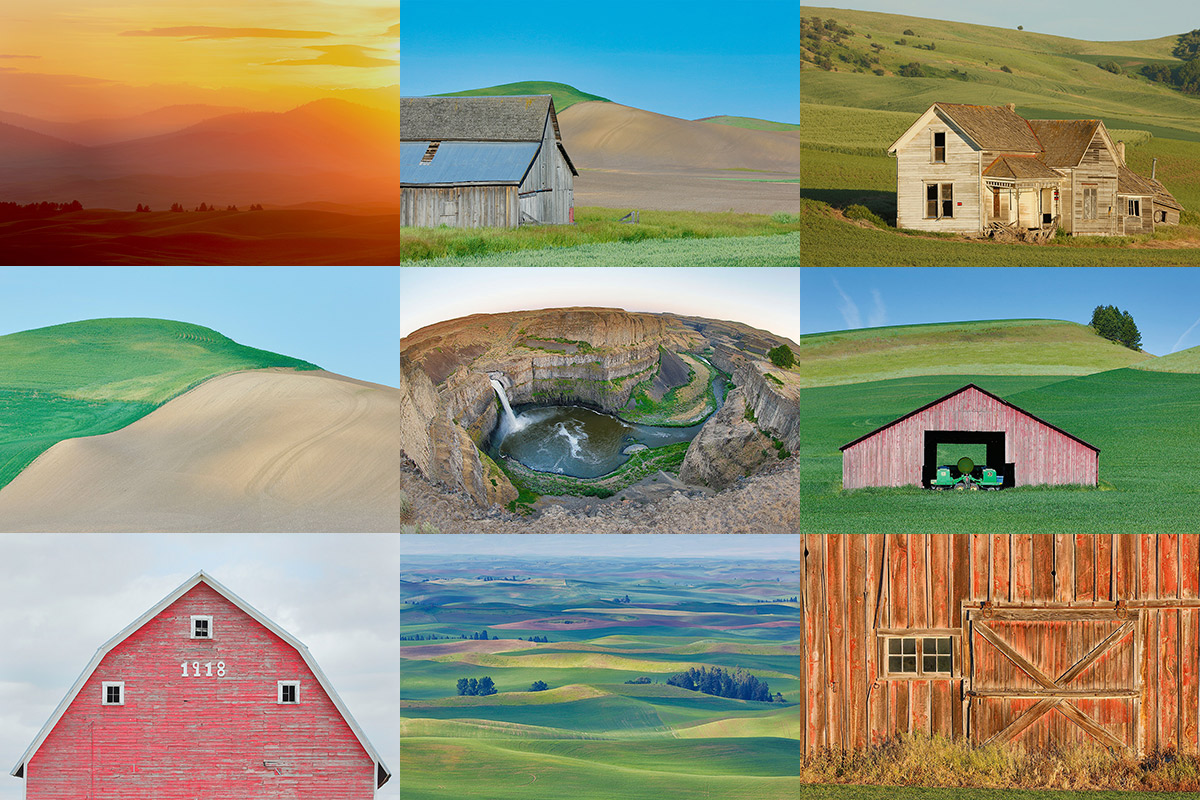
|
|
Please note that there are two Palouse IPTs in place. Hope that you can join us 🙂 Card and design by Arthur Morris/BIRDS AS ART.
|
The Palouse A Creative Adventure/BIRDS AS ART Instructional Photo-Tour (IPT)/Eastern Washington State. June 5-9, 2015/5 Full Days: $1699/Limit 12 photographers/Openings 4; this trip is a go.
Rolling farmlands provide a magical patchwork of textures and colors, especially when viewed from the top of Steptoe Butte where we will likely enjoy spectacular sunrises and possibly a nice sunset or two. We will photograph grand landscapes and mini-scenics of the rolling hills and farm fields. We will take you to some really neat old abandoned barns and farmhouses in idyllic settings. There is no better way to improve your compositional and image design skills and to develop your creativity than to join us for this trip. Two great leaders: Denise Ippolito and Arthur Morris. Photoshop and image sharing sessions when we have the time and energy…. We get up early and stay out late and the days are long. For a sample of what you will be learning, click here.
After 6 days of back-breaking scouting work in early June 2014 we found all of the iconic locations and, in addition, lots of spectacular new old barns and breath-taking landforms and views. We will teach you what makes one situation prime and another seemingly similar one a waste of your time.
What’s included: In-the-field instruction, guidance, lessons, and inspiration, our newfound but very extensive knowledge of the area, all lunches, motel lobby breakfasts, and Photoshop and image sharing sessions when possible.
You will learn and hone both basic and advanced compositional and image design skills. You will learn to get the right exposure every time. You will learn to develop your creative eye. You will learn the basics of HDR (high dynamic range) photography. You will learn a variety of in-camera creative techniques; Canon 5D Mark III bodies are a plus. And most importantly you will learn to see the situation and to create a variety of top-notch images. Do see both of our blogs for lots more on that in the coming weeks. You will learn how the quality and direction of light combine to determine the success of your images. And–please don’t gasp–we will be working quite a bit with sidelight when creating landscapes. Lastly, we will be touching on infrared photography.
A non-refundable $699 deposit is due now. The balance will be due on January 29, 2015. With the unpredictable nature of the photography business, I have not said this often lately, but it seems quite likely that this one will fill up very quickly. Please let me know via e-mail that you will be joining us. Then you can either call Jim or Jennifer at 863-692-0906 during business hours or send us a check; the latter is preferred.
Please send your deposit check made out to “Arthur Morris” to us at Arthur Morris/BIRDS AS ART, PO Box 7245, Indian Lake Estates, FL, 33855. If you have any questions, please feel free to contact me via e-mail. You can also contact denise via e-mail here
Facebook
Be sure to like and follow BAA on Facebook by clicking on the logo link upper right. Tanks a stack!
Support the BAA Blog. Support the BAA Bulletins: Shop B&H here!
We want and need to keep providing you with the latest free information, photography and Photoshop lessons, and all manner of related information. Show your appreciation by making your purchases immediately after clicking on any of our B&H or Amazon Affiliate links in this blog post. Remember, B&H ain’t just photography!
…..
Amazon Canada
Many kind folks from north of the border, ay, have e-mailed stating that they would love to help us out by using one of our affiliate links but that living in Canada and doing so presents numerous problems. Now, they can help us out by using our Amazon Canada affiliate link by starting their searches by clicking here. Many thanks to those who have written.
Typos
In all blog posts and Bulletins, feel free to e-mail or to leave a comment regarding any typos, wrong words, misspellings, omissions, or grammatical errors. Just be right. 🙂
September 3rd, 2014 Important “CBS This Morning” News Flash Update
Helen Hayes/Great Island Feature Re-scheduled.
8:51am EDT. The feature just aired. It was wonderful and I laughed a lot. And they used some of my images. I hope that each of you got it on tape or Tivo or got to watch it. It is not too late for those in time zones to the west.
A Wonderful and Moving Tribute to Helen HaysVia a comment on the blog by Glen Fox
September 2, 2014 at 4:13 pm
Artie, Thank you for this photo and head-up regarding the CBS interview with Helen Hayes. I first came acquainted with Helen in 1957, at the American Ornithologists Union meeting in Regina, SK. when I was a 14yr old budding ornithologist. I remember distinctly the cheers and wolf whistles that went up as Helen, then a newly-minted waterfowl biologist crossed the stage to present her paper, and the extended applause she received after her presentation from all her male contemporaries. You see, Helen was a pioneer, and one of the very first female wildlife biologists of her day. Later, in the early 1970s, we worked together editing my manuscript on Common Terns based on my graduate thesis. Helen was then the editor of The Wilson’s Bulletin, and with her help, that manuscript won a prize as the best paper to be published in that journal that year. Later, when I was a biologist with the Canadian Wildlife Service, we corresponded on deformities in fish-eating birds. Helen Hays has been a mentor and source of encouragement to hundreds of young people as she was to your Jennifer and her husband Erik. Her extensive data set on Common and Roseate Terns collected over the past 47 years will be a goldmine of information. Rarely do studies last more than 10 years, let alone 47! Hats off to the 80-something year old wonder lady with the yellow flowers in her straw hat. She is still a classy act and an inspiration to us all.. Yeah Helen!
On September 2, 2014 at 4:35 pm I responded:
Glen, Thanks for sharing your powerful and moving tribute to Helen with us here.
I wrote an article about Helen for the now defunct “Birder’s World Magazine” about 20 years ago. It was entitled “One Good Tern Lady.” At one point I had several hard copies but have lost track of those. I have been trying without success to find one so that I could scan the article…. Perhaps you or someone else has a copy…. best and thanks again, artie
Important Bosque Festival of the Cranes Event Registration Notice
Registration for all Festival of the Cranes workshops, seminars and programs will be open for all today at 9:00am MDT (11:00am EDT). Please click here and read carefully to avoid missing out on several wonderful and inexpensive educational opportunities. Please do not tarry as we expect all of the BAA/A Creative Adventure sessions to sell out quickly, especially the early morning In-the-Field Workshops.
The Streak Continues: 277
This blog was published just after 6:00am from my home in Indian Lake Estates, FL after another good night’s sleep. We head to Tampa today for another stem cell/PRP/Prolozine injection treatment for my right shoulder and the first one for my left knee. This post, which took me about two hours to prepare, makes 277 in a row.
As always, I would appreciate your using the BIRDS AS ART B&H affiliate links for all of your major gear, video, and electronic purchases, using our Amazon logo-link for all of your household purchases, and visiting the BAA Online Store for your tripod, tripod head, LensCoat, miscellaneous, accessories, and eGuide purchases as well.
Web Orders Only Please!
Though we have let you know in the past that BAA will receive affiliate credit only for web orders, several well meaning folks have placed B&H orders by phone after calling and being told by the salesman that “BIRDS AS ART will absolutely earn credit for this purchase. Please understand that that is not the case. BAA affiliate credit is earned only on orders placed on the web.
I greatly appreciate those of you who have been placing your gear orders on the web while using our B&H (or Amazon) affiliate links.
Catching Up on Photography Fine Points
From time to time–but probably not often enough–I like to go back and take a look at the answers to the questions that are sprinkled throughout various blog posts.
|
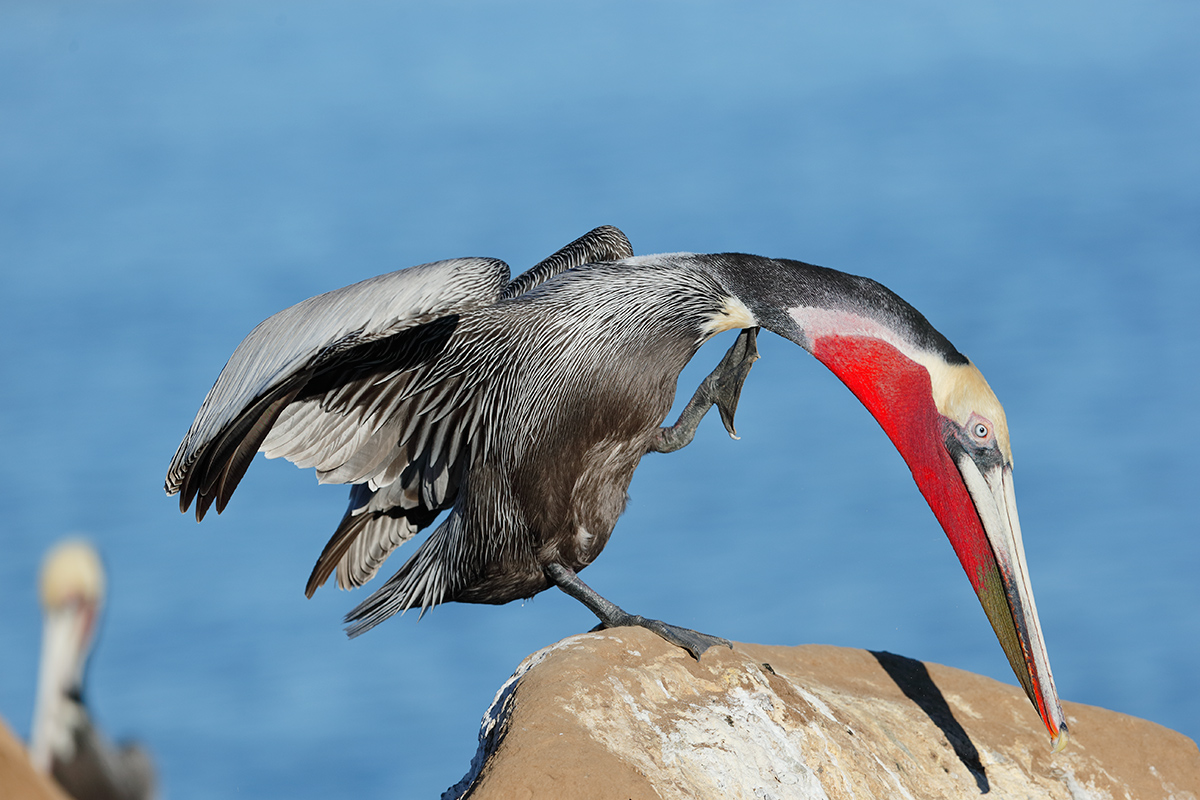
|
|
This image was created at 8:11am in full sun on last year’s Short Notice San Diego IPT with the hand held Canon EF 300mm f/2.8L IS II USM lens and the Canon EOS-1D X. ISO 400. Evaluative metering at zero: 1/4000 sec. at f/4.5 in Manual mode.
Central sensor/AI Servo/Surround Rear Focus AF as originally framed (see below) was active at the moment of exposure. Click here to see the latest version of the Rear Focus Tutorial. Click on the image to see a larger version. See image next for the original capture.
|
Mommy, Why are Their Bills So Red?
In yesterday’s Mommy, Why are Their Bills So Red? blog post, I asked:
#1: Why didn’t I simply point my lens to the right to eliminate the out-of-focus pelican behind the subject and have more room in front of the bird?
Nobody came close on this one…. At 1/4000 sec. at f/4.5 with central sensor AI Servo Surround set some might surmise that I had been concentrating on flight photography. They would have been correct. When I saw the pelican scratching, I got as low as I could to eliminate the rocks right behind the bird. I was not able to get low enough to separate the pelican’s bill from the rock. I knew that there was too much room behind the bird and not enough room in front but I did not want to miss the scratching action. The problem stemmed from the fact that central sensor Surround AF was active; if I pointed the lens to the right for better framing the active sensor would have been on the distant ocean. I remember being reluctant to move the active AF sensor as I was not sure of what would have been the best choice.
Knowing now what I did not know then about 61-Point AF, I would have realized that 61-Point Automatic selection would have been perfect for this situation as I was almost parallel to the bird…. Once I acquired focus I would have been able to re-compose right without losing focus….
#2: Had I been able to get lower, how would that have helped the image?
As noted above, had I been able to get lower I could have eliminated the merge of the tip of the bill with the rock. Kudos to David Policansky for leaving a comment and nailing that one.
|
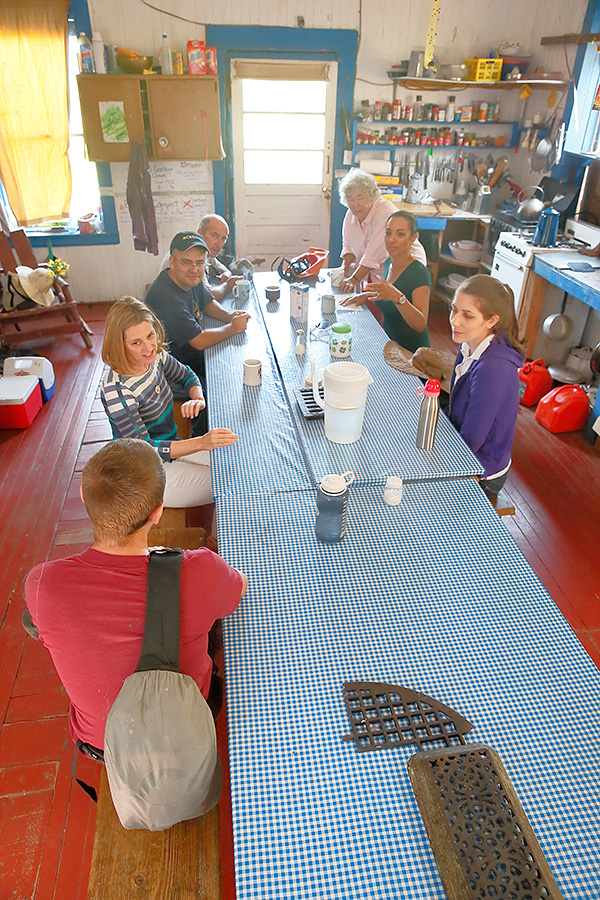
|
|
This image was created with the Canon EF 24-70mm f/2.8L II USM lens (hand held at 24mm) and the Canon EOS-1D X. ISO 1600. Evaluative metering +1/3 stop: 1/60 sec. at f/5.6 in Av mode. Color temperature: AWB.
Central sensor/AI Servo/Surround Rear Focus AF on the head of the young man with his back to the camera and and re-compose. Click here to see the latest version of the Rear Focus Tutorial. Click on the image to see a larger version.
|
Important CBS This Morning News Flash for Tuesday, September 2, 2014
In the “Important CBS This Morning News Flash for Tuesday, September 2, 2014” blog post here, I asked, referring to the image created in the GGI kitchen, why I should have gone with an HDR (High Dynamic Range) series. When you are photographing indoors with a window to the outside world going HDR is often the best and only solution. Note that both windows as well as the blue & white checkerboard oilcloth at the far end of the table were mega-over-exposed.
I followed the standard advice of going “high and wide for people” and was standing on one of the bench seats. Being indoors I was at a necessarily slow shutter speed despite having set a high ISO so in order to create a usable HDR series I would have needed to have my rig on a tripod. But that was not possible with me standing on the bench seat. You get the picture. So I went with a straight image capture and lived with the toasted windows and tablecloth.
Had my EOS-5D Mark III not been on the fritz I would have gone with in-camera HDR Natural with Auto Align set and hoped for the best….
|
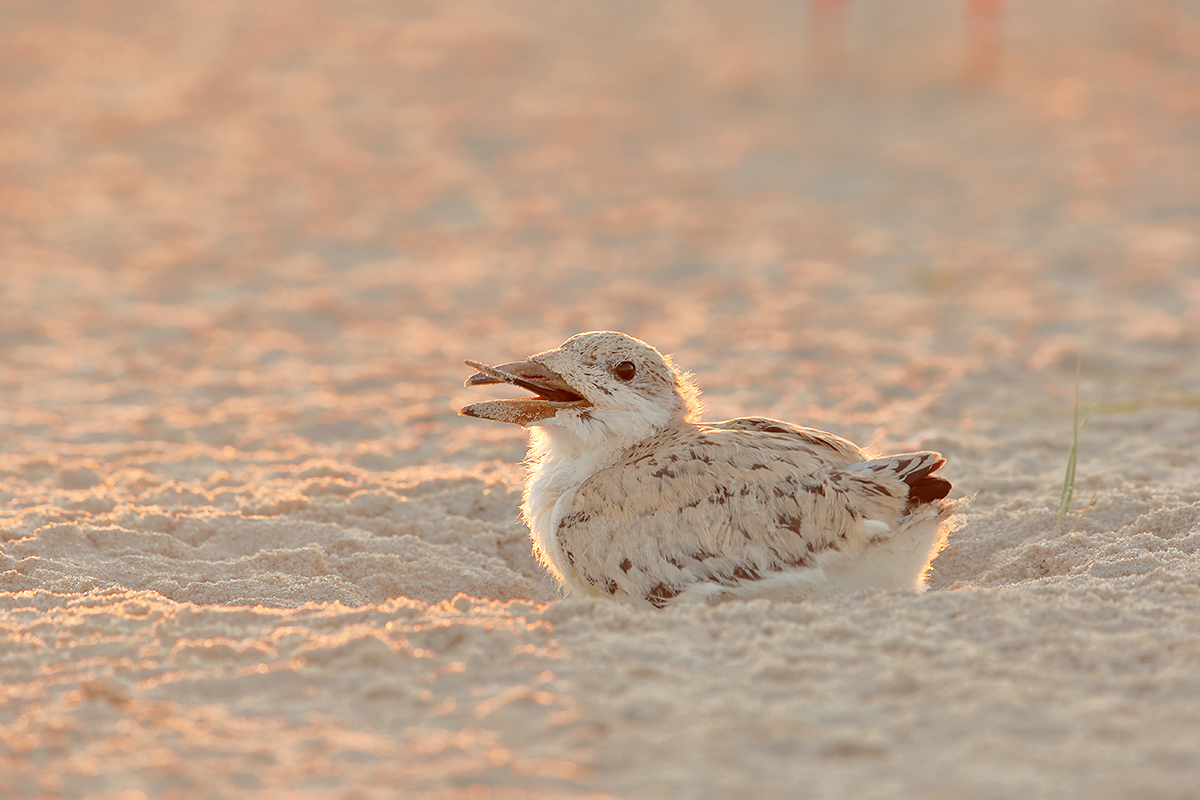
|
|
This image was created at Nickerson Beach at 6:33am on the clear morning of 25 August, 2014 with the Gitzo 3532 LS carbon fiber tripod, the Mongoose M3.6 head, the Canon EF 600mm f/4L IS II USM lens, the Canon Extender EF 2X III, and the Canon EOS-1D X. ISO 1600. Evaluative metering +1 2/3 stops as framed: 1/160 sec. at f/9 in Manual mode.
Central Sensor (by necessity)/AI Servo-Expand/Rear Focus AF on the base of the bird’s face and release. When you add the 2X TC to an f/4 lens with the 1DX or the 5D III hit the MFn button once to toggle to AF Expand and enjoy 4 extra AF sensors. Learn everything there is to know about the 1D X and 5D III AF systems including how to manage the various AF Area Selection Modes, when to use which one, and several ways to move the AF sensor around in the 1D X AF Guide and the 5D Mark III User’s Guide. Click here to see the latest version of the Rear Focus Tutorial. Click on the image to see a larger version.
Black Skimmer chick with twig at dawn
|
The Importance of Being Early III
In The Importance of Being Early III I posted with regards to the image above:
Image Question
What other elements of composition–though quite small and seemingly insignificant to many, add to the success of this image?
The two tiny blades of grass right behind the behind the chick and the pair of legs of an adult skimmer on the upper right frame-edge both added interest to the image as both were perfectly positioned. If I were painting this chick on a plain sand beach I would have placed these two elements in exactly the same spots….
Just for the record book, the item that the chick is holding in its bill is a small, likely windblown twig.
AF Question
With the active and the eight surrounding sensors squarely on the chick’s face why did I take my thumb off the rear focus button before creating the image? Note: I did not re-compose….
AF sometimes has problems in extreme low contrast situations. AF often has problems in backlit situations. For those reasons I released the rear focus button once I had acquired focus. Here’s a tip for similar situations: there is a small, round, green AF indicator light. If that light is flickering when you are in AI Servo AF it means that AF is having trouble locking on. If the light is steady, it indicates that accurate focus has been achieved….
Exposure Questions
With regards to the skimmer silhouette image I wrote:
1-Why would +2 stops as framed have been very close to +3 stops off the sky?
+2 stops as framed would have been very close to the meter reading that you got at +3 stops off the sky because the bird is darker than the sky and would have influenced the meter. Remember that if you are (properly) working in Manual mode that you would need to look at the analogue scale in the viewfinder to note these differences.
2-Assuming that I went to Manual mode what would the correct shutter speed have been at f/5.6?
The image was created at zero in Av mode at 1/8000 sec. at f/5.6. To get two stops lighter in Manual mode I would have needed to halve the shutter speed twice as halving the shutter speed once gets you one stop lighter. Another way to think of it would be to go six counterclockwise clicks with the index finger wheel with each click representing 1/3 stop lighter. Either way you would wind up at 1/2000 sec. at f/5.6.
All photographers need to be familiar with the relationships that deal with ISO, shutter speed, aperture, and exposure compensation. In other words, you need to be able to do the math. Those who have trouble doing the math are referred to “Measuring Light in Stop”s section on page 54 of the original The Art of Bird Photography (160 pages in soft cover).
|

|
|
San Diego offers a wealth of very attractive natural history subjects. With annual visits spanning more than three decades I have lot of experience there….
|
2015 San Diego 4 1/2-DAY BIRDS AS ART Instructional Photo-Tour (IPT): FEB 1 thru the morning of FEB 5, 2015: $1799 (Limit: 8/Openings: 7)
Meet and Greet after dinner on your own at 7:00pm on JAN 31
Join me in San Diego to photograph the spectacular breeding plumage Brown Pelicans with their fire-engine red bill pouches; Brandt’s and Double-crested Cormorants in breeding plumage with their amazing crests; breeding plumage Wood and Ring-necked Duck; other species possible inluding Lesser Scaup, Redhead, and Surf Scoter; a variety of gulls including Western, California, and the gorgeous Heerman’s, all in full breeding plumage; shorebirds including Marbled Godwit, Willet, Sanderling and Black-bellied Plover; many others possible including Least, Western, and Spotted Sandpiper, Whimbrel, Black and Ruddy Turnstone, Semiplamated Plover, and Surfbird; Harbor Seals (depending on the current regulations) and California Sea Lions likely; and Bird of Paradise flowers. And as you can see by studying the two IPT cards there are some nice landscape opportunities as well.
Did I mention that there are wealth of great birds and natural history subjects in San Diego in winter?
This IPT will include five 3 1/2 hour morning photo sessions, four 2 1/2 hour afternoon photo sessions, five lunches, after-lunch image review and Photoshop sessions, and two fine dinners. To ensure early starts, breakfasts will be your responsibility.
A $499 non-refundable deposit is required to hold your slot for this IPT. You can send a check (made out to “Arthur Morris) to use at BIRDS AS ART, PO Box 7245, Indian Lake Estates, FL, 33855. Or call Jim or Jennifer at the office with a credit card at 863-692-0906. Your balance, payable only by check, will be due on 12/1//2014. If the trip fills, we will be glad to apply a credit applicable to a future IPT for the full amount less a $100 processing fee. If we do not receive your check for the balance on or before the due date we will try to fill your spot from the waiting list. If your spot is filled, you will lose your deposit. If not, you can secure your spot by paying your balance. Please print, complete, and sign the form that is linked to here and shoot it to us along with your deposit check. If you register by phone, please print, complete and sign the form as noted above and either mail it to us or e-mail the scan. If you have any questions, please feel free to contact me via e-mail.
|

|
|
Though the pelicans will be the stars of the show on this IPT there will be many other handsome and captivating subjects in wonderful settings.
|
San Diego Natural History Museum Program & The Birds of the World Exhibit
On Saturday morning, February 7, 2015 I will be presenting “A Bird Photographer’s Story” at the San Diego Natural History Museum to kick off the Birds of the World photographic exhibit that will feature the images of about a dozen of the world’s top avian photographers. This program,which is being generously sponsored by the Canon Explorers of Light program, will be free and open to the public. I am proud to say that both Denise Ippolito and I will have images hanging in the show. The exhibit opening is scheduled for later that same day, February 7, 2015. (Times TBA).
Folks on the IPT who wish to stay over and attend the program and the exhibit opening on Saturday are invited to join me for a photo session on Friday morning as follows:
Friday Morning Add-on Photo Session: February 6, 2015: $299.
This workshop includes 3 hours of in-the-field pelican photography instruction and brunch with image review and Photoshop instruction. For now, this session is open only to folks attending the IPT.
Facebook
Be sure to like and follow BAA on Facebook by clicking on the logo link upper right. Tanks a stack!
Support the BAA Blog. Support the BAA Bulletins: Shop B&H here!
We want and need to keep providing you with the latest free information, photography and Photoshop lessons, and all manner of related information. Show your appreciation by making your purchases immediately after clicking on any of our B&H or Amazon Affiliate links in this blog post. Remember, B&H ain’t just photography!
…..
Amazon.com
Those who prefer to support BAA by shopping with Amazon may use this link:
Amazon Canada
Many kind folks from north of the border, ay, have e-mailed stating that they would love to help us out by using one of our affiliate links but that living in Canada and doing so presents numerous problems. Now, they can help us out by using our Amazon Canada affiliate link by starting their searches by clicking here. Many thanks to those who have written.
Typos
In all blog posts and Bulletins, feel free to e-mail or to leave a comment regarding any typos, wrong words, misspellings, omissions, or grammatical errors. Just be right. 🙂
|
|

























